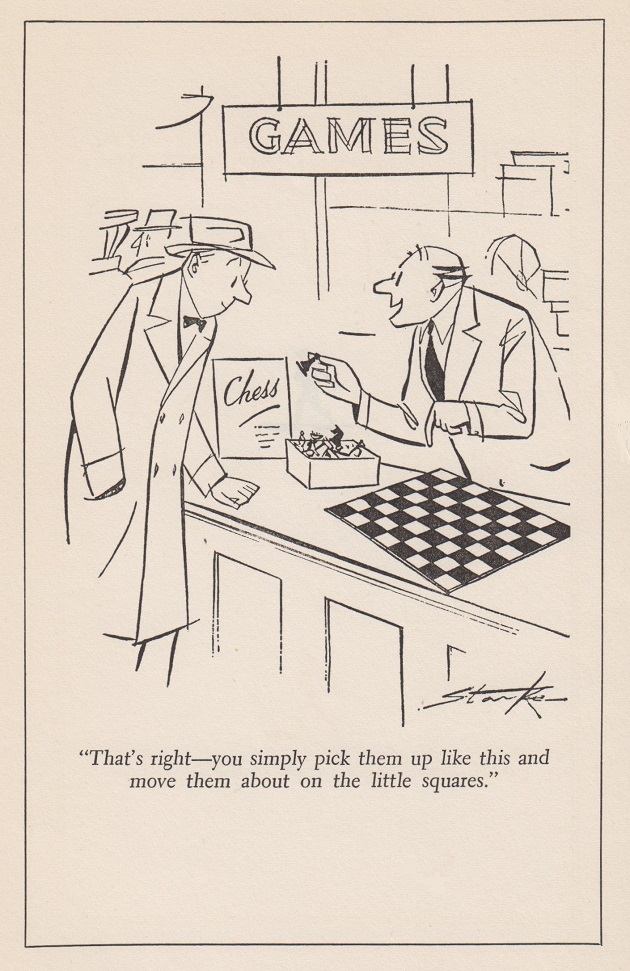
Edward Winter

See C.N. 10611 below.
The present article comprises a selection of cartoons and caricatures shown in C.N.
***
The illustrations by Edward McLachlan in Chess for Tigers by Simon Webb (Oxford University Press) must be amongst the most amusing ever seen in a chess volume:
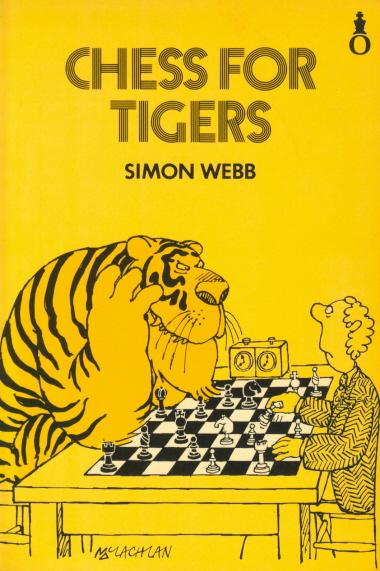
(1035)
Edward McLachlan also contributed to Chess for Tomorrow’s Champions by J.N. Walker (Oxford, 1985):
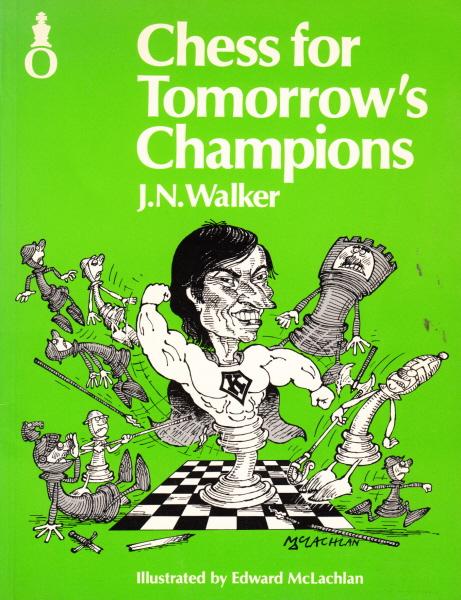
Two images given at the start of Chess with Violence:
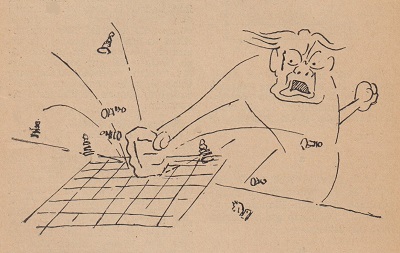
Lances humorísticos de ajedrez by Hans Cohn (Guatemala, 1938), page 32
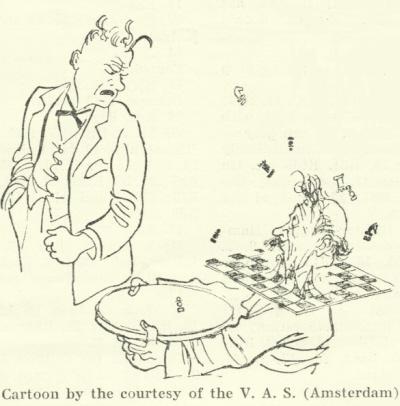
The Chess World, 1 January 1933, page 157
Here is a less than flattering depiction of the Argentine master Roberto Grau (1900-44), taken from page 50 of M. Czerniak’s book, published in Buenos Aires in 1946, Torneo Internacional del Círculo de Ajedrez Octubre 1939:
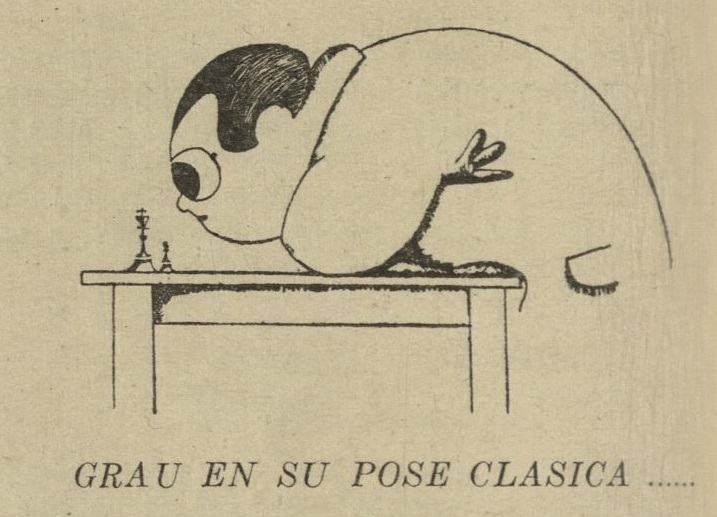
(2491)
The above scan has been provided by the Cleveland Public Library.
From our collection: a baker’s dozen of sketches and caricatures of Richard Réti:
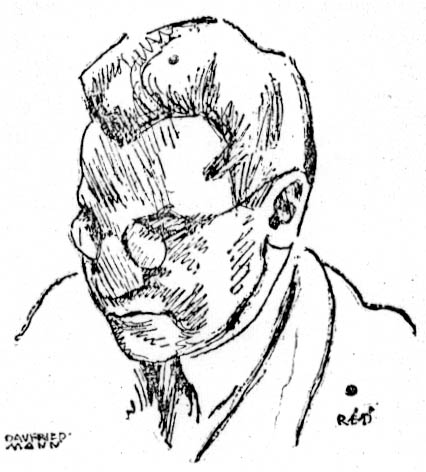 |
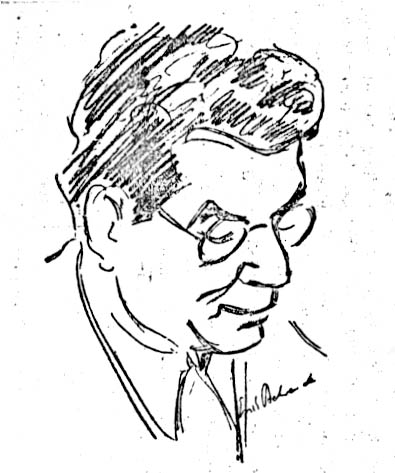 |
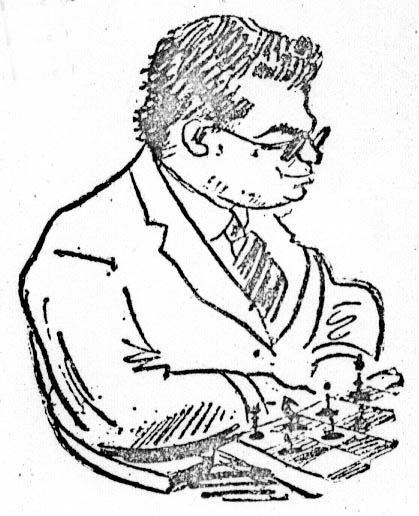 |
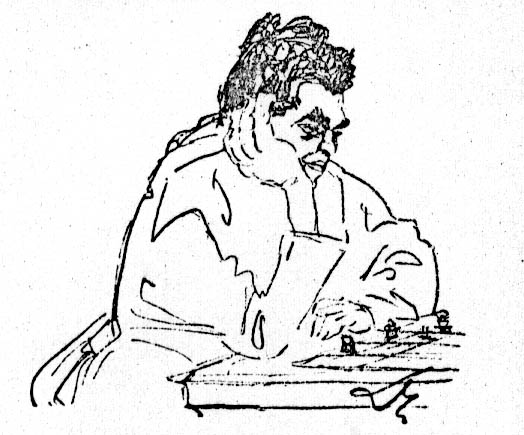 |
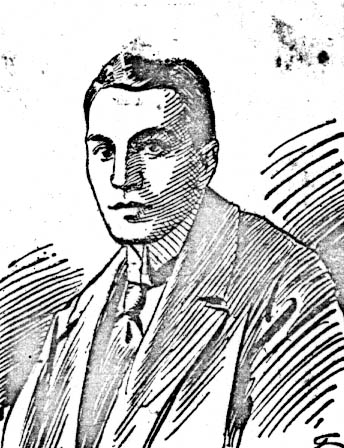 |
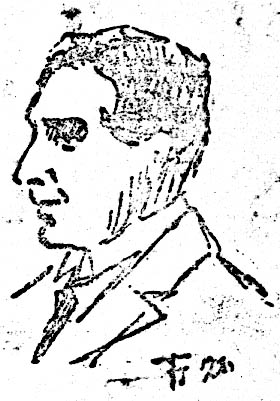 |
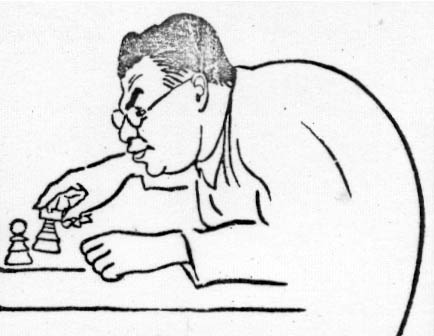 |
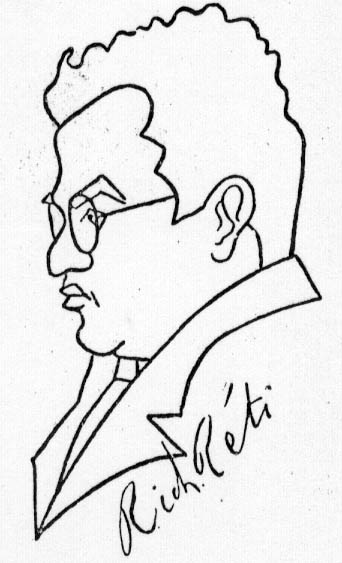 |
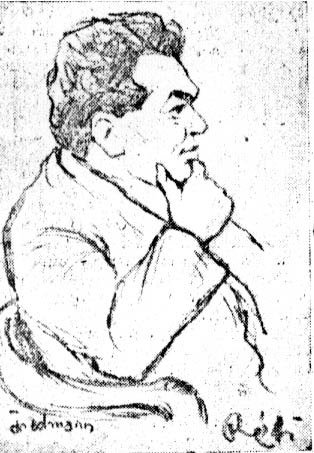 |
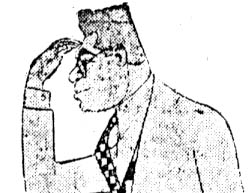 |
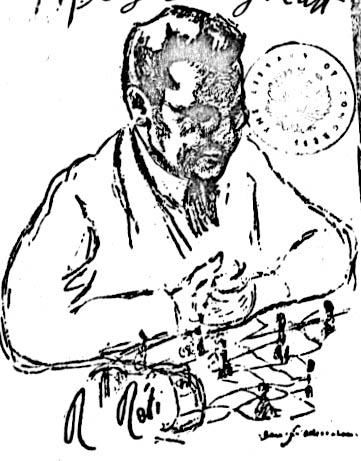 |
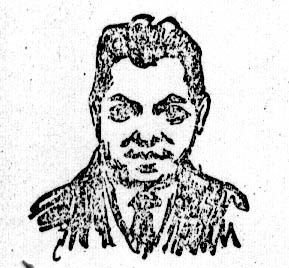 |
|
|
||
(3110)
Now we have found three more:
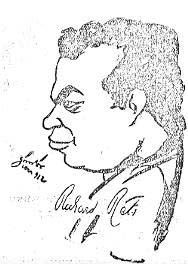
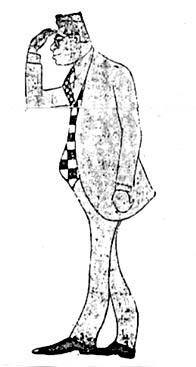
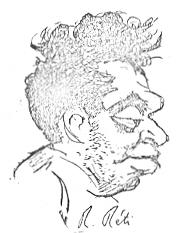
(4125)
From Miriam Friedman Morris (Pomona, NY, USA):
‘C.N. 3510 includes three portraits of Réti (1, 9 and 11) produced by my father, David Friedmann (1893-1980).
Richard Réti (Copyright: Miriam Friedman Morris)
He is renowned for a series of lithographs entitled “Das Schachmeister Turnier in Mährisch-Ostrau, Juli 1923” (The Chess Master Tourney) and “Köpfe berühmter Schachmeister” (Portraits of Famous Chess Masters). Four portfolios of “Köpfe berühmter Schachmeister” were found. One of them, No. 28, is in the collection of the Royal Library of the Netherlands, The Hague.
The portfolio of the Mährisch-Ostrau tourney comprises 14 lithographs, one portrait representing each participant: Lasker, Réti, Grünfeld, Selesniev, Euwe, Tartakower, Bogoljubow, Tarrasch, Spielmann, Rubinstein, Pokorný, Hromádka, Wolf and Walter.
The portfolio “Köpfe berühmter Schachmeister” consists of 12 or 14 portraits. Two chessplayers were dropped, whereas Ossip Bernstein and/or Richard Teichmann were added. It is possible that as many as 50 portfolios were produced. All the lithographs bear the signature of the chessplayer depicted, and the signature Dav. Friedmann was handwritten in pencil on each lithograph.
He specialized in portraits drawn from life of famous personalities from the arts, music, theater, sport, politics, etc. His pre-War art was confiscated by the Gestapo in Berlin and in Prague under the auspices of the German Reich. In search of evidence of his career, I have discovered over 100 portraits published in the B.Z. am Mittag, among them Capablanca, Alekhine, Vidmar and Nimzowitsch. There are probably other portraits of chessplayers still unaccounted for, and it would be fascinating to discover who they are and where the remaining portfolios are located.
David Friedmann survived the Holocaust, but his wife and daughter perished. His post-War journey took him from Czechoslovakia to Israel and to the United States, where he continued to paint until he died in 1980, in St Louis.
I shall be grateful for any help in creating an inventory of his lost works and preserving the legacy of a remarkable artist.’
Our correspondent has also kindly provided a rare photograph of her father, taken in Berlin on 15 September 1924:
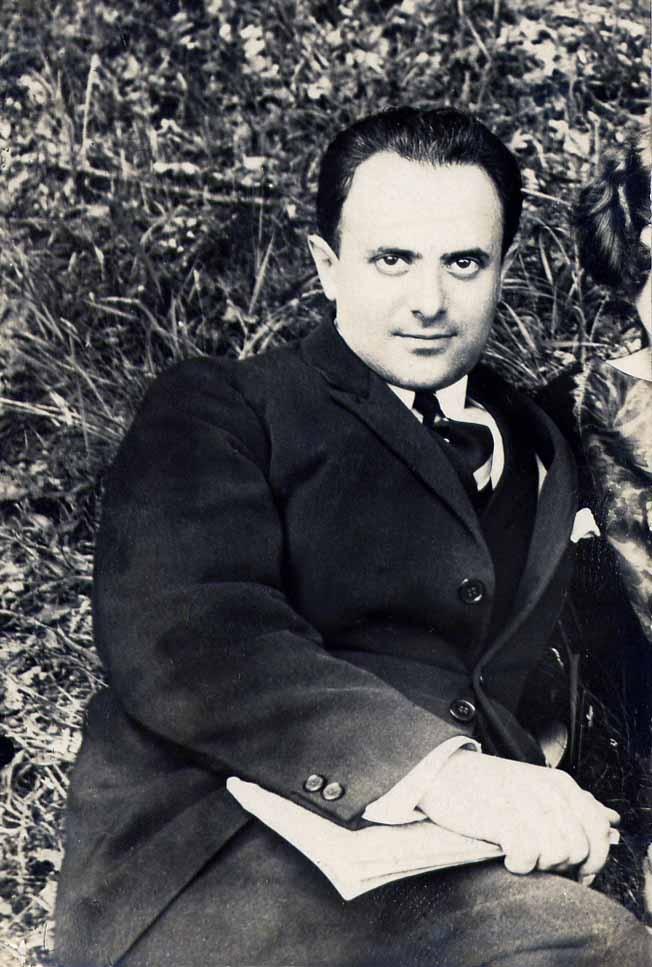
David Friedmann
(4132)
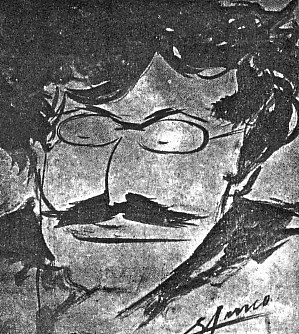
The subject is Emanuel Lasker and the artist Rafael Blanco. The portrait appeared on the front cover of the Cuban magazine Crónica de Ajedrez, June 1911. Blanco is probably best known in the chess world for his loss to Capablanca at Havana, 1913 (annotated in Chess Fundamentals). The biographical feature about him on the back cover of the 9/1974 issue of Jaque Mate (Cuba) described him as ‘an exceptional caricaturist, a graduate of the Escuela de San Alejandro in Havana’.
(3471, 3475)
Yandy Rojas Barrios (Cárdenas, Cuba) supplies a better-quality version, from page 125 of El Fígaro, 4 March 1906:
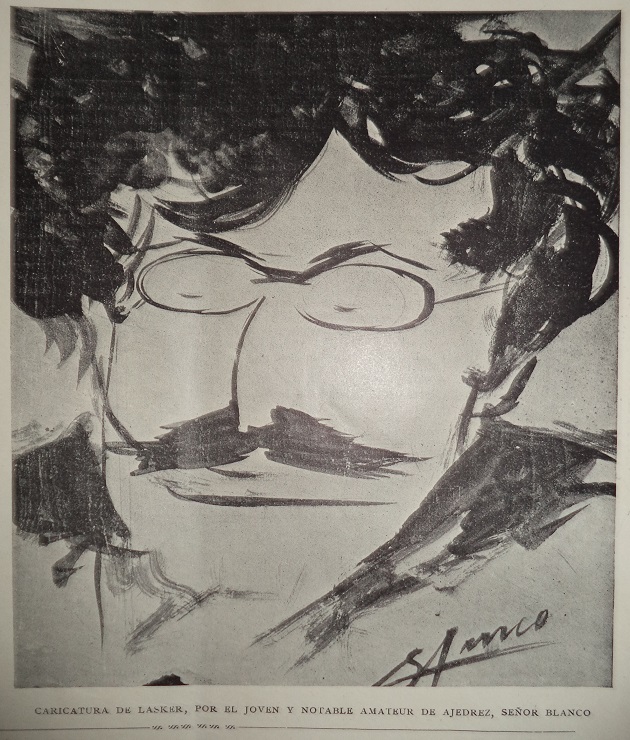
(11944)
From the June 1911 issue of Crónica de Ajedrez (page 66) comes this caricature of Capablanca by Conrado Massaguer:
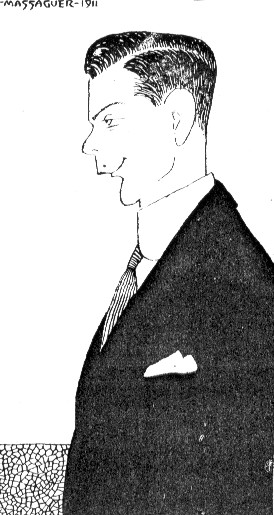
(3476)
A drawing of Capablanca which we reproduce from the Finnish newspaper (in Swedish) Dagens Tidning, 21 February 1914:
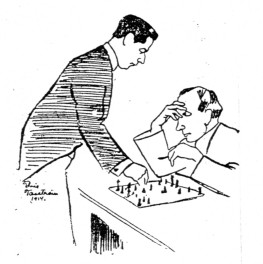
(3564)
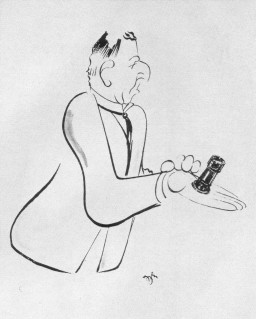
This caricature, by Zen, is of Harry Golombek, as given in III° torneo internazionale di scacchi Venezia 1949 by H. Müller (Venice, 1950).
(3657, 3664)
The sketch of Janowsky given below was on page 251 of the July 1905 issue of the American Chess Bulletin:
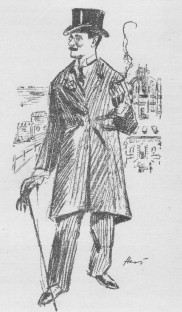
(3699)
This seldom-seen caricature of Capablanca, Lasker and Alekhine was published in the Yugoslav magazine Šahovski Glasnik in 1927 and was reproduced on page 18 of B. Kažić’s book Na pervenstvo mira Matchi pretendentov (Belgrade, 1969):
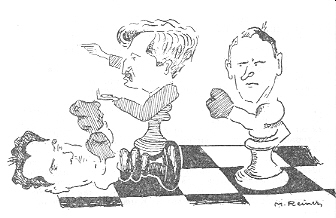
(3926)
Addition on 2 March 2023:
Courtesy of the Cleveland Public Library we are able to show the front covers of two issues of Šahovski Glasnik (13 October 1927 and 31 December 1927):
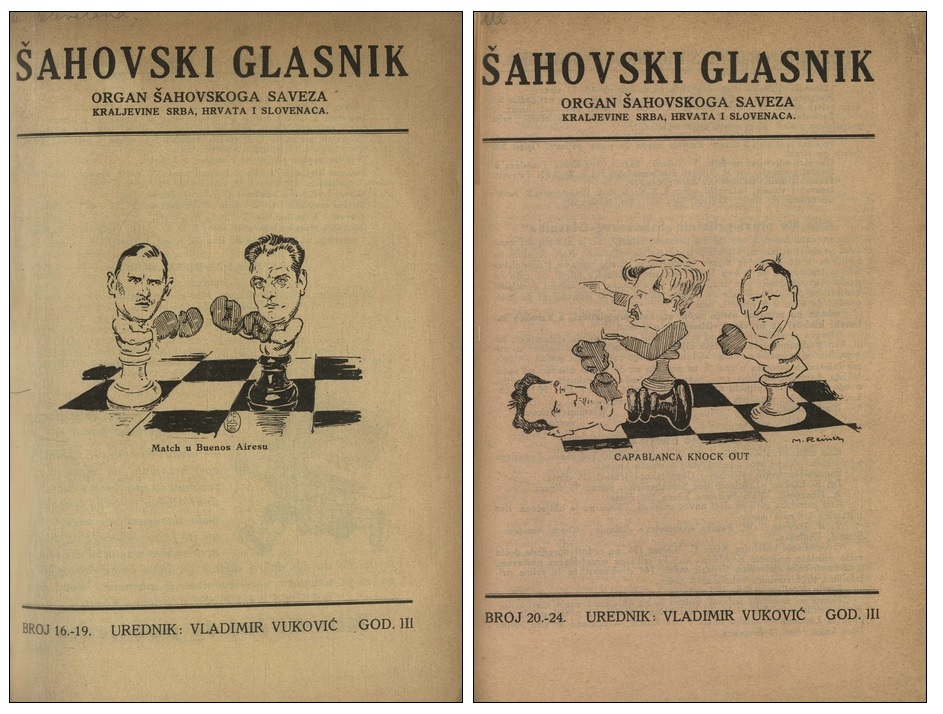
The cartoon and poem below come from page 244 of the December 1898 American Chess Magazine, to mark Pillsbury’s chess tour and the victory of the Republican Party in the mid-term elections:
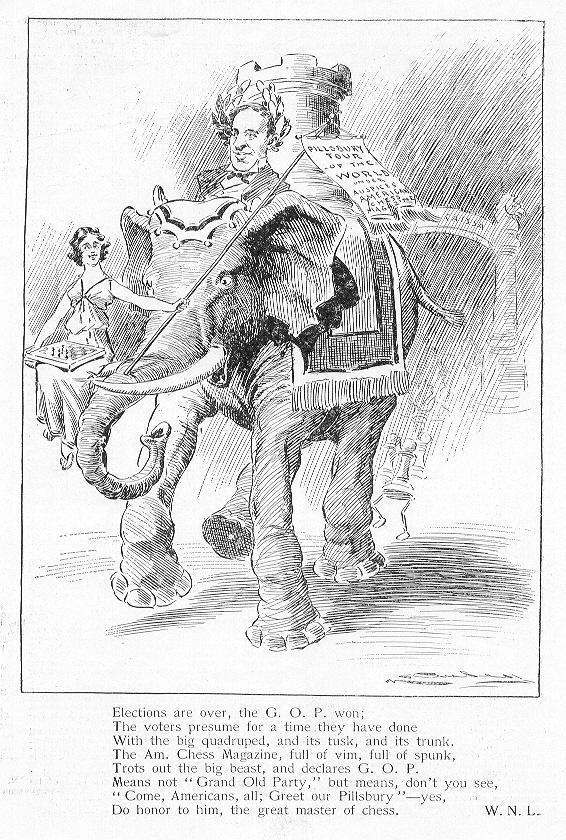
(3932)
The dates of Emanuel Lasker’s world championship reign, 1894-1921, are well known, but even an elementary matter like that can unhorse someone like Dimitrije Bjelica. Page 126 of his book Šahovska Čitanka (undated, but circa 1966) had the following:
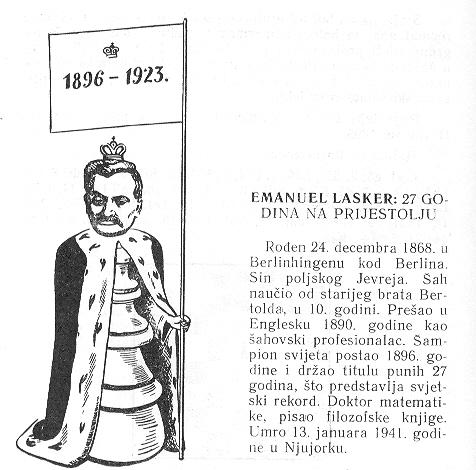
(3936)
Miguel Artigas (Sabadell, Spain) writes:
‘I have been reading a comic magazine published in Cuba by Ediciones de colores; there is no publication date, but it was brought out at the time of the Olympiad in Havana (1966). This issue, wholly devoted to chess, is entitled “Capablanca la máquina de jugar ajedrez. El ajedrez cuenta su historia”, and the main story (pages 2-15) is a biography of Capablanca in comic-strip form. I would be interested to know if other chessplayers’ biographies have been published in a similar way.’
Our correspondent has provided the front cover of the publication and the first and last pages of the story:
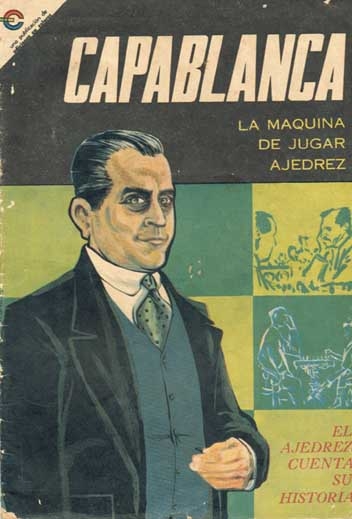
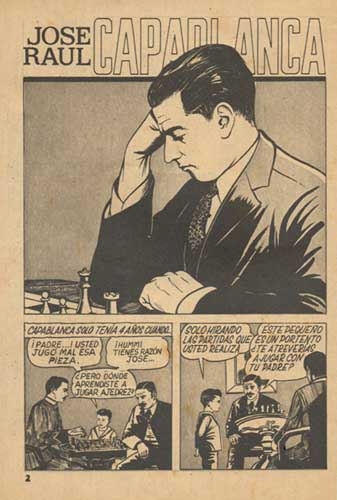
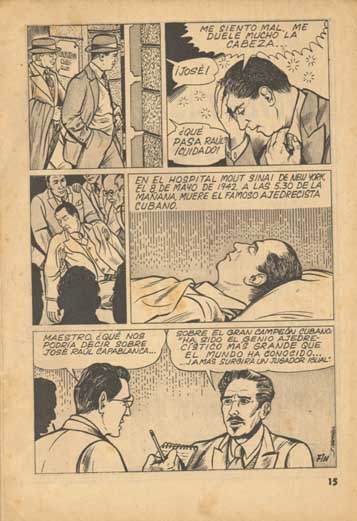
(3937)
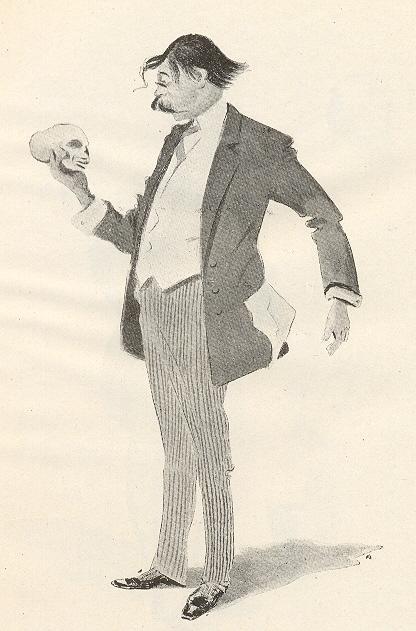
This is Benito H. Villegas (1877-1952) of Argentina, in a picture culled from page 496 of El ajedrez en la Argentina by José Pérez Mendoza (Buenos Aires, 1920).
(4459)
From page 493:
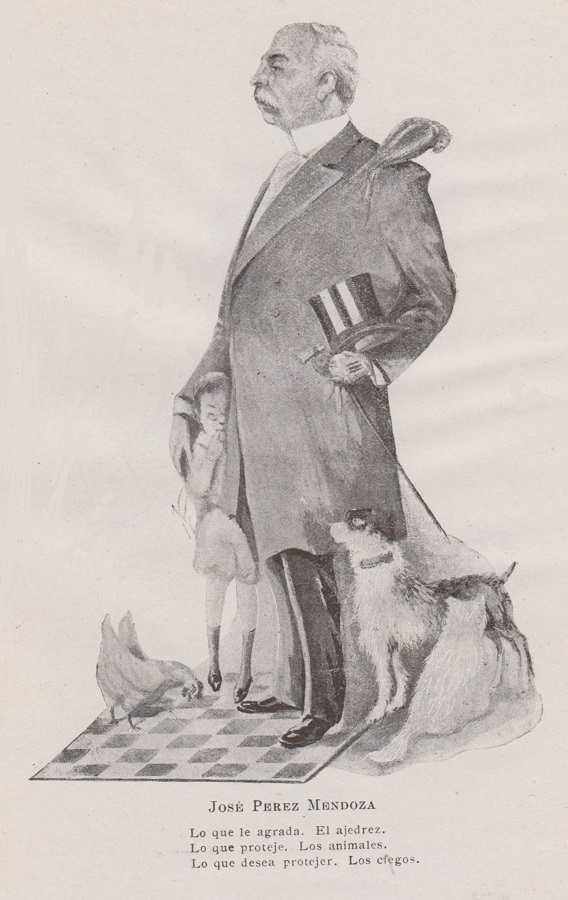
(11749)
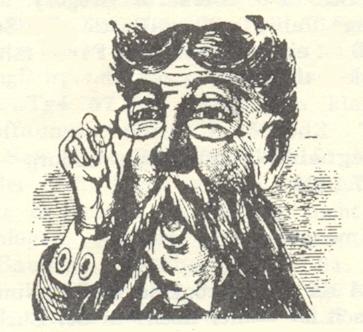
Improbably, this sketch was labelled ‘Dr Siegbert Tarrasch’ on page 8 of Aaron Nimzowitsch 1886-1935 Ein Leben für das Schach by Gero H. Marten (Hamburg, 1995).
On the subject of sketches and caricatures of chess masters, we suggest that some of the best are by Frank Stiefel in his book Was Sie schon immer über Schachweltmeister wissen wollten, ... aber nie zu fragen wagten (Schwieberdingen, 2000).
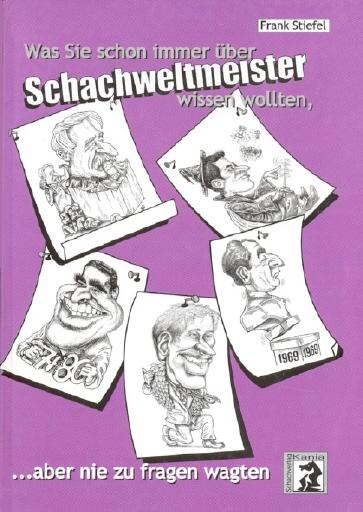
(4695)
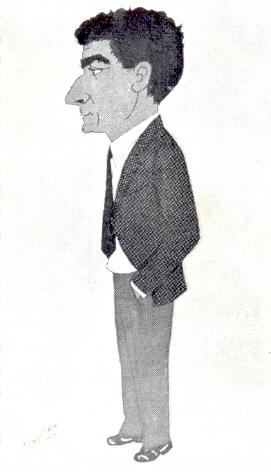
After this caricature was given, unidentified, in C.N. 4813, suggestions from correspondents included M. Adams, L. Fressinet, A. Matanović, B. Parma and T. Petrosian. Understandably, no reader gave the correct answer, which was J. Penrose. The caricature appeared in the Palma de Mallorca, 1969 tournament book, which also presented, on page 4, a group photograph:
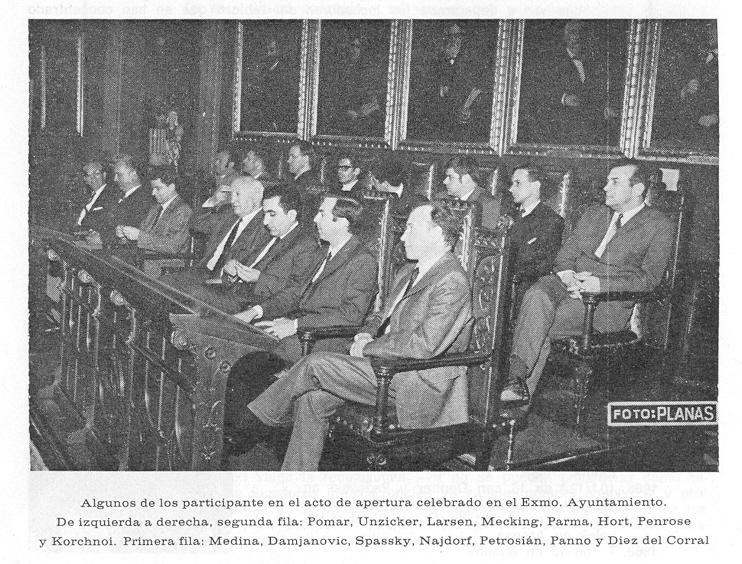
(4818)
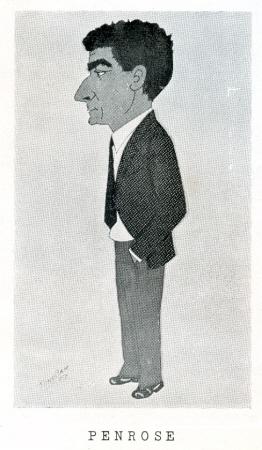
This caricature (from the Palma de Mallorca, 1969 tournament book) was discussed in C.N.s 4813 and 4818, but is the matter straightforward? Javier Asturiano Molina (Murcia, Spain) informs us that according to Ricardo Lamarca Barrios of Madrid, who was present at the tournament and knew the artist, Tony Sam, the player depicted in the caricature is not Jonathan Penrose but Bruno Parma.
Below are the small coloured photographs of Parma and Penrose in the tournament book (on pages 88 and 96):
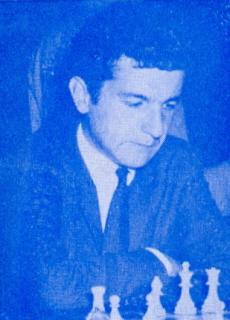
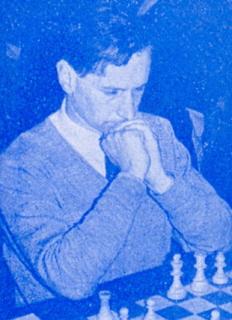
Bruno Parma and Jonathan Penrose
(6785)
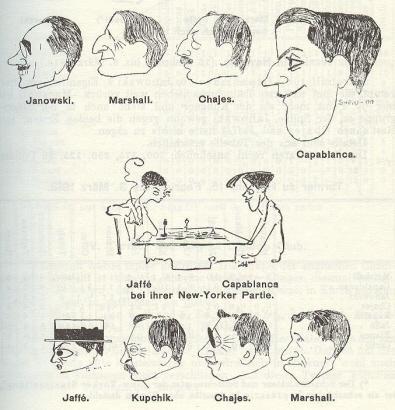
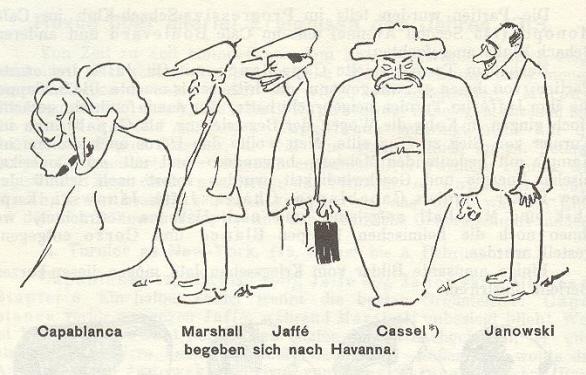
These caricatures were published on pages 3-4 of the January-February 1914 Wiener Schachzeitung. How many cases of misidentification are there?
(4942)
Jan Kalendovský (Brno, Czech Republic) submits two caricatures, of Tarrasch and Tartakower, from Schach Karikaturen aus der internationalen Schachwelt by E. Gőndőr (Vienna, 1922):
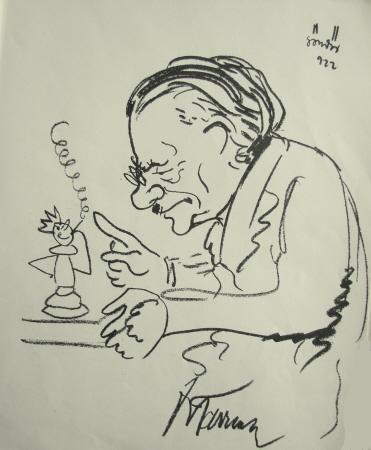
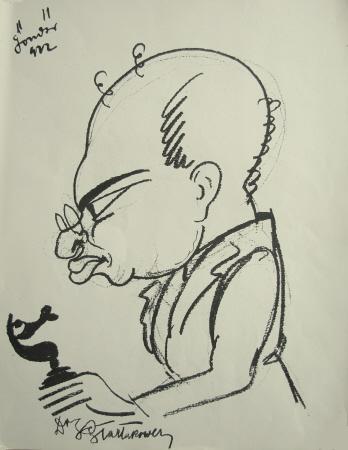
(5247)
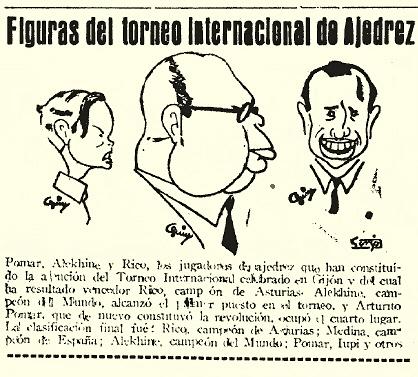
Christian Sánchez (Rosario, Argentina) sends the above cutting with caricatures of Arturo Pomar, Alexander Alekhine and Antonio Rico at Gijón, 1945, from page 6 of the Spanish (Cuenca) newspaper Ofensiva of 2 August 1945.
The caricature of Alekhine must be one of the last published during his lifetime.
(5307)
Juan Carlos Sanz Menéndez (Alcorcón, Spain) submits the following:
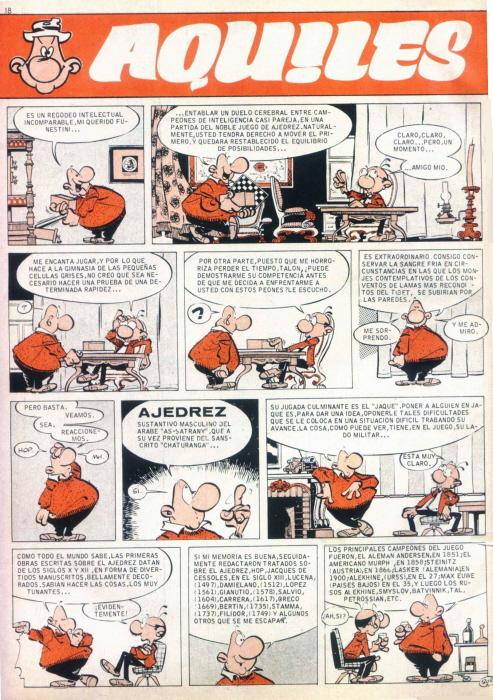
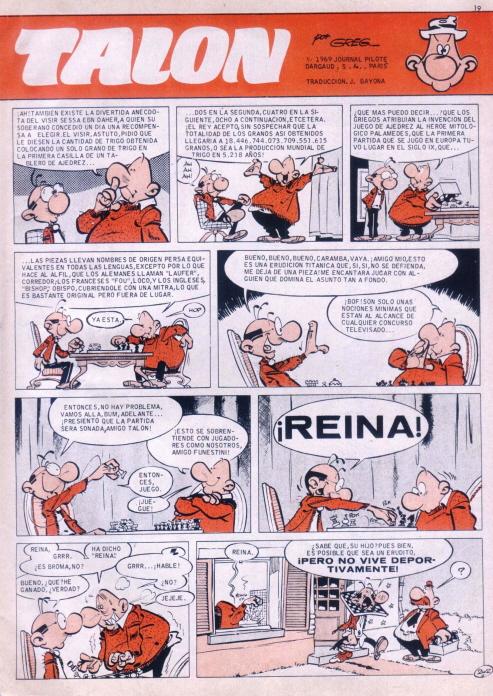
‘Aquiles Talón’ on pages 18-19 of Gran Pulgarcito, number 50 (1970), the original having appeared in the French magazine Pilote
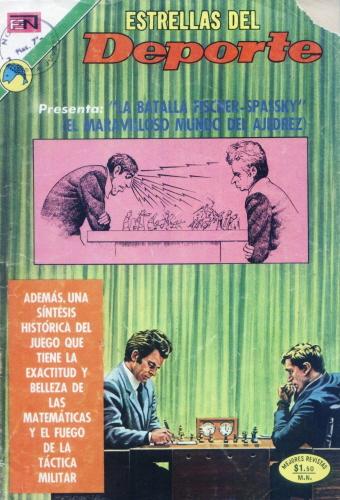
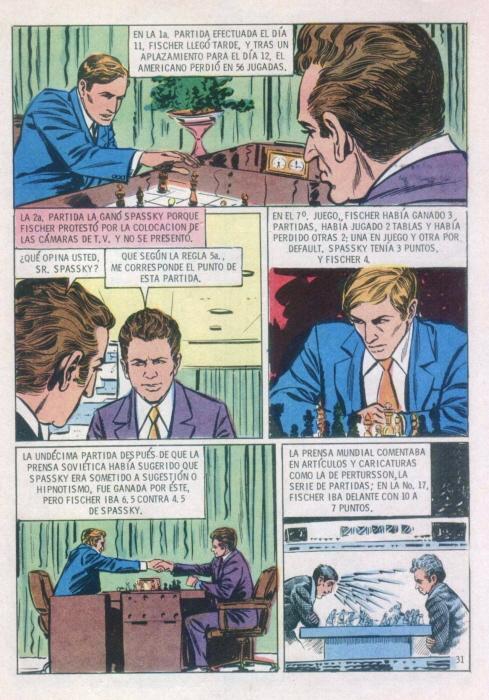
‘La Batalla Fischer-Spassky/El maravilloso Mundo del Ajedrez’ in Estrellas del Deporte (Mexico, 1973), page 31
(5418)
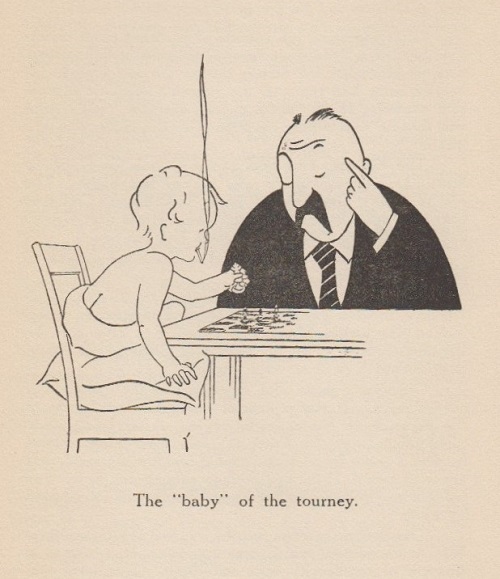
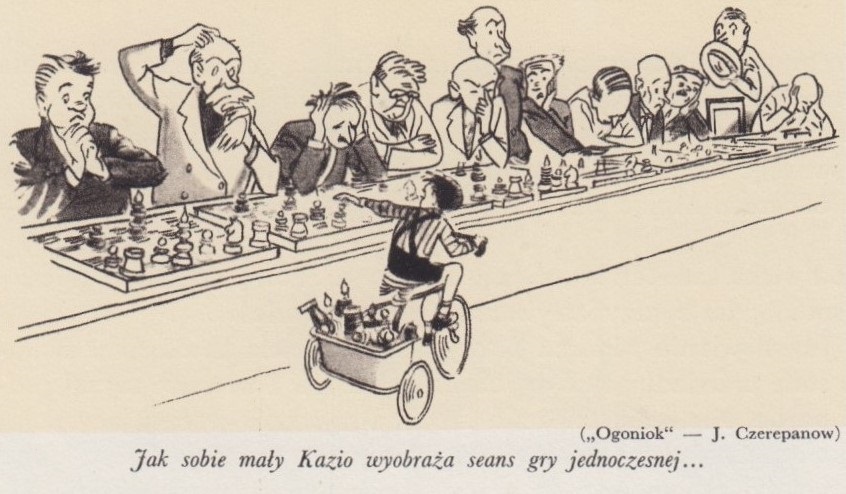
Source: page 98 of Z szachami przez wieki i kraje by Jerzy Giżycki (Warsaw, 1960)
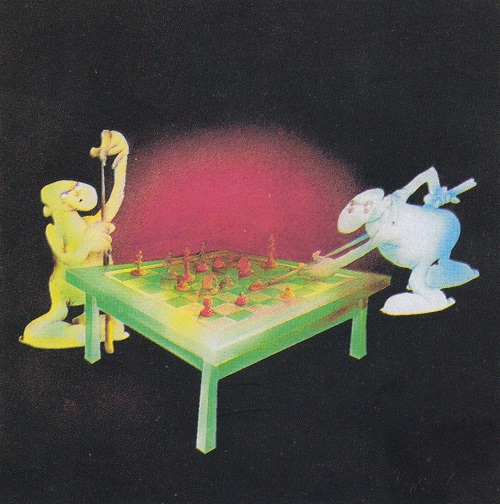
From Chess Miniatures & Caricatures by Jovan Prokopljević (1999)
Recent reports of alleged cheating put us in mind of two old US cartoons. The first, by George Price, comes from page 131 of the June 1939 Chess Review:
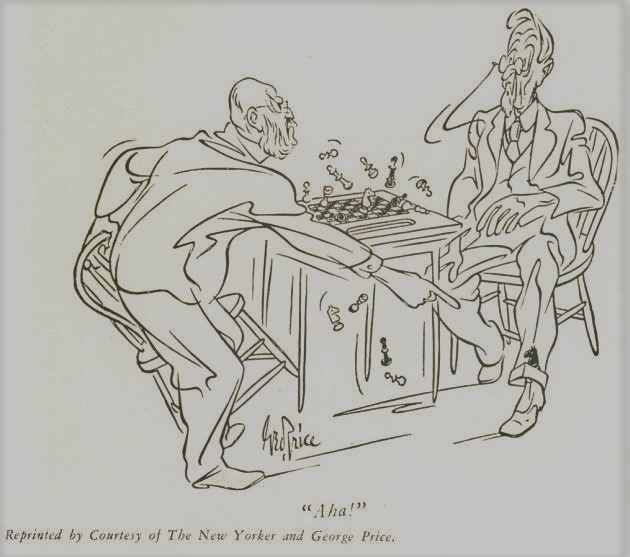
The second cartoon, from page 24 of the March 1948 Chess Review, depicts a rather more sophisticated technique:
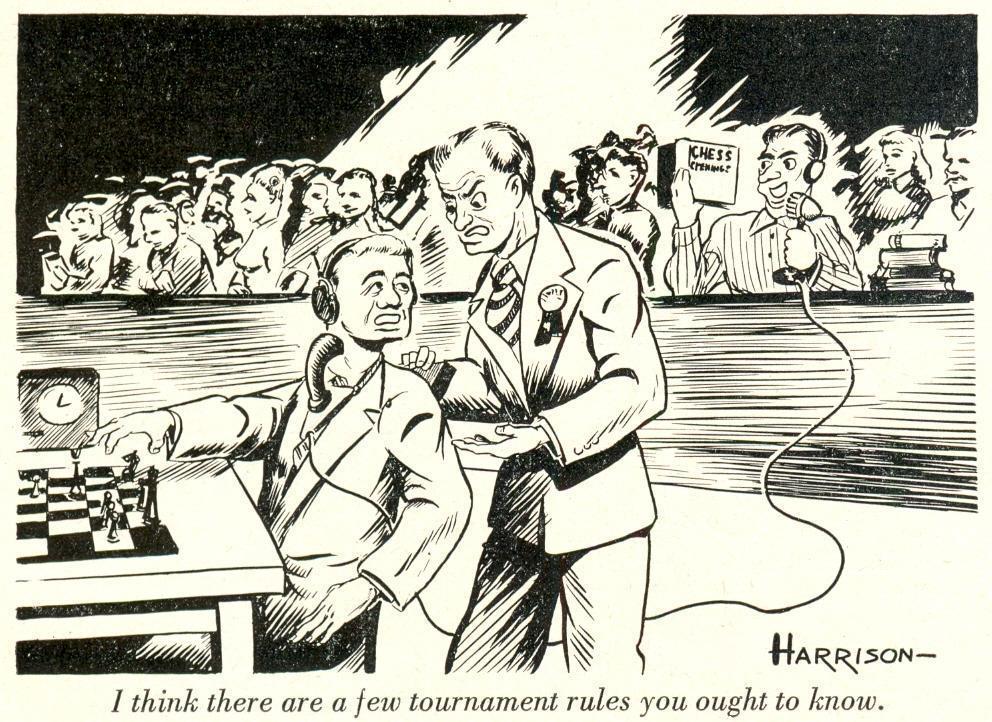
Page 251 of the July 1905 American Chess Bulletin had a sketch of Tarrasch by Julius Hess from the New Yorker Staats Zeitung, the context being the Ostend, 1905 tournament:
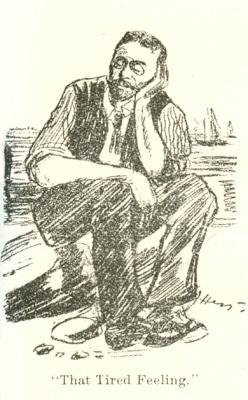
(5724)
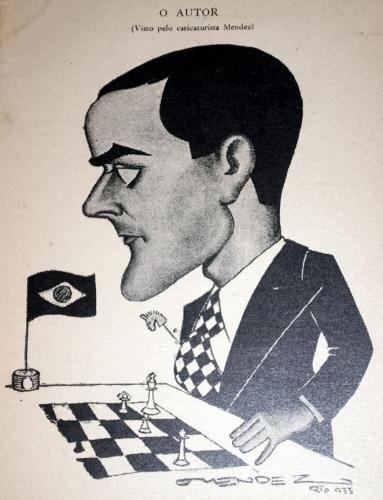
See Joaquim Valladão Monteiro.
(5799)
There is a lack of photographs of the peripatetic match between Marshall and Capablanca in 1909. The illustration below, by C.W. Kahles (1878-1931), comes from page 177 of the Chess Weekly, 1 May 1909. On page 345 of A Chess Omnibus we commented that it had been ‘sketched with some artistic licence’.
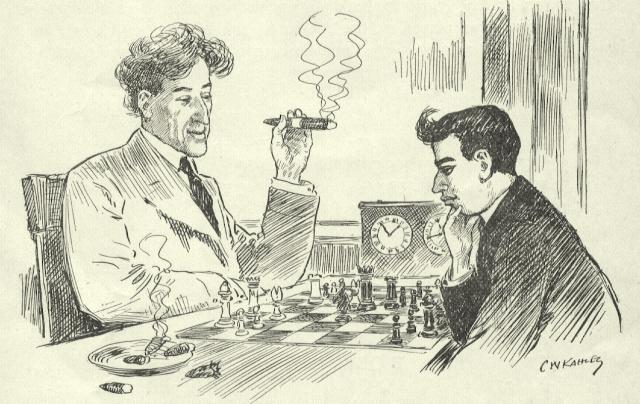
(5921)
From Olimpiu G. Urcan (Singapore) comes this sketch on page 438 of the November [sic – it was mistakenly headed ‘October’] 1905 BCM:
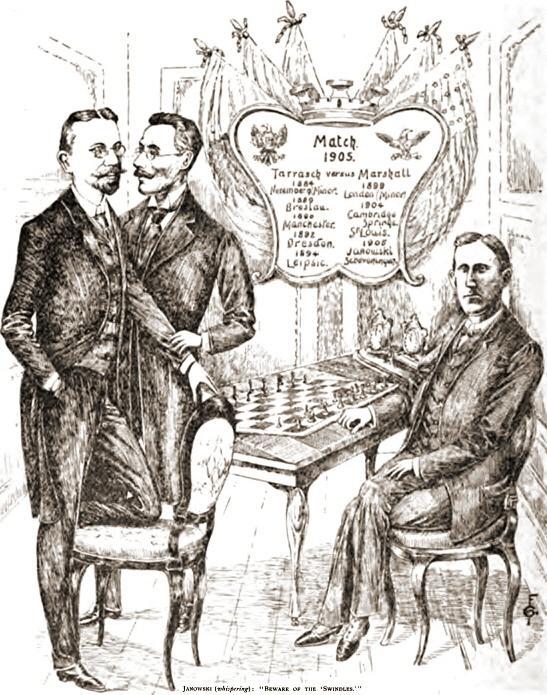
(6149)
Capablanca’s game against Milner-Barry at Margate, 1936 was given on pages 333-334 of CHESS, 14 May 1936 accompanied by a sketch:
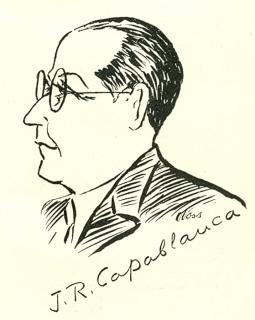
(6204)
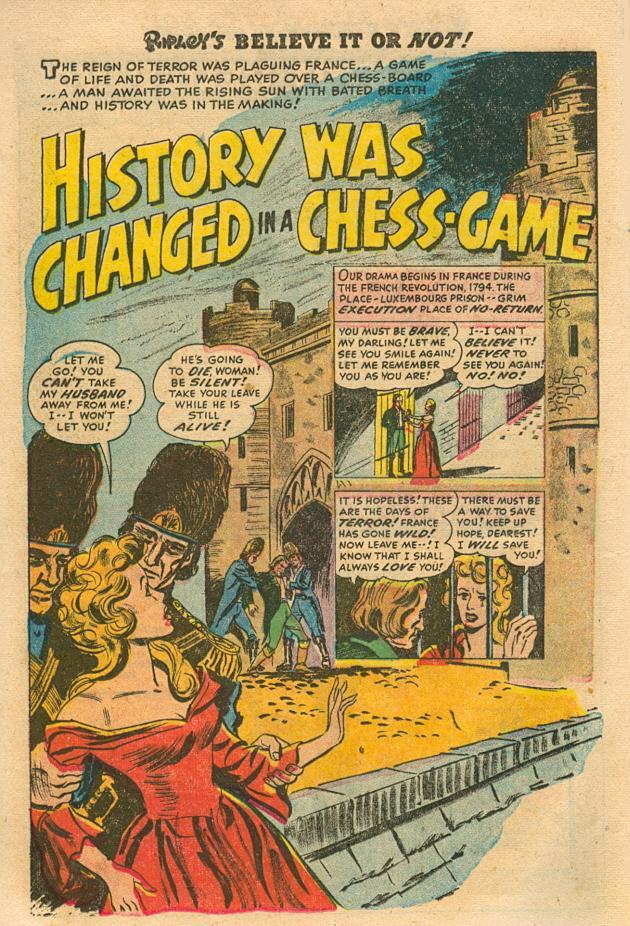
This is the opening of a five-page comic-strip ‘History was changed in a chess-game’ in the September 1953 issue of Ripley’s Believe it or Not! In the story, Thomas Paine has a last-minute reprieve from the guillotine after his wife, disguised as a young man, defeats Robespierre at chess.
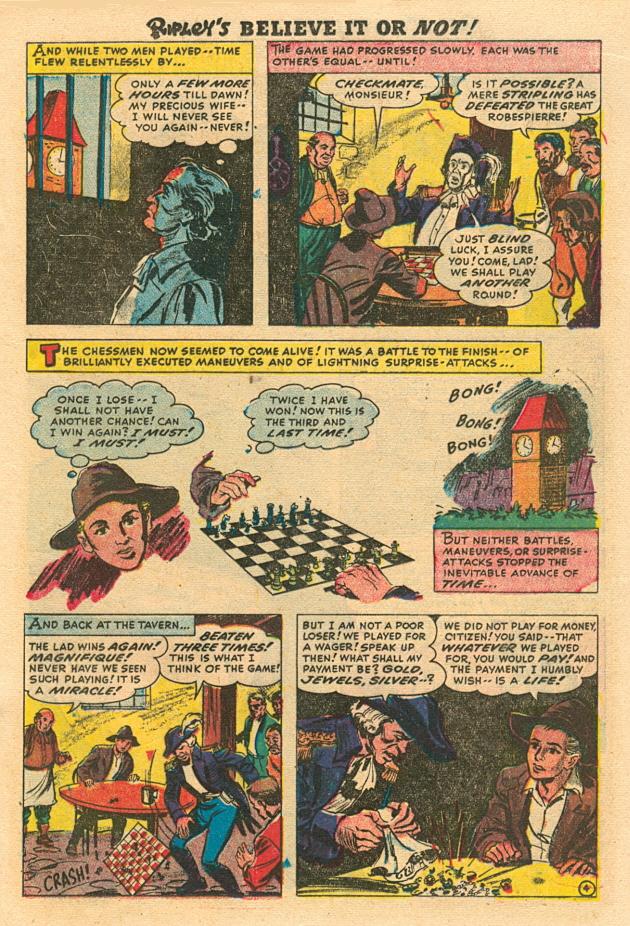
Wanted: other versions of the tale.
(6361)
From page 11 of the January 1949 Chess Review:
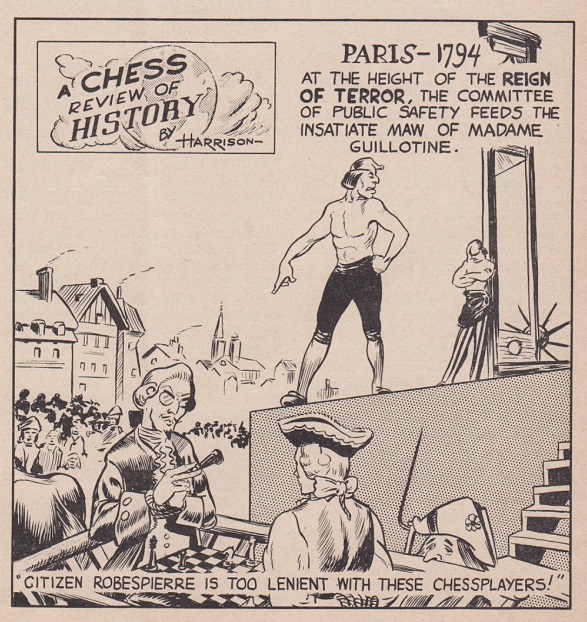
(8907)
Morten Hansen (Frederiksberg, Denmark) has sent us a number of pages from the Danish edition of a chess-related story in a war comic, Djævelens slagmark. For example:
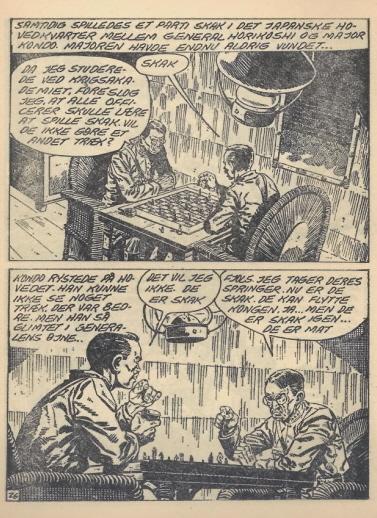
Our correspondent points out that the English version of the story is entitled ‘No Higher Stakes’, and he summarizes the plot thus:
‘The action takes place in Burma in February 1942, and the two main characters, General Horikoshi and Captain Grant, are both keen chessplayers. Grant is captured by the Japanese and, when revealed to be a chessplayer, is forced to play a game against Horikoshi with his life at stake. Grant wins, and Horikoshi has to commit suicide.’
We give below a sample page (with references to the ‘Mikalov Gambit’ and ‘Sparski’) from issue 94 of the publication Battle:
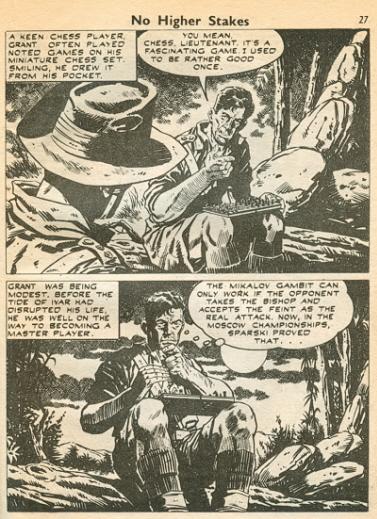
Mr Hansen notes that the story has been reprinted on pages 201-264 of the book Let ’Em Have It (London, 2008).
(6377)
From page 14 of London 1946, published by CHESS (Sutton Coldfield, 1946):
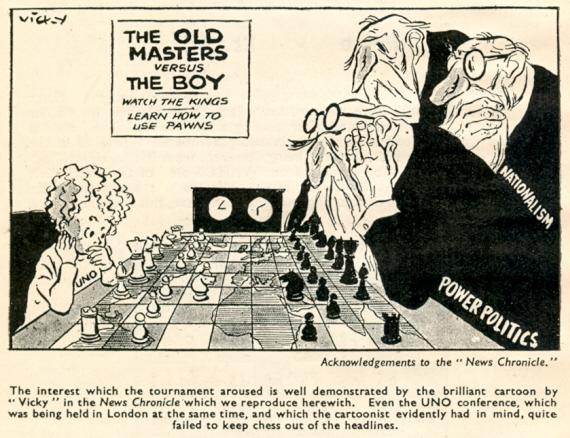
(6589)
Michael Syngros (Amarousion, Greece) has updated his catalogue of ‘Chess literature in Hellenic (original or translations) and books by Hellenic authors in other languages’ and kindly authorizes us to make it available here.
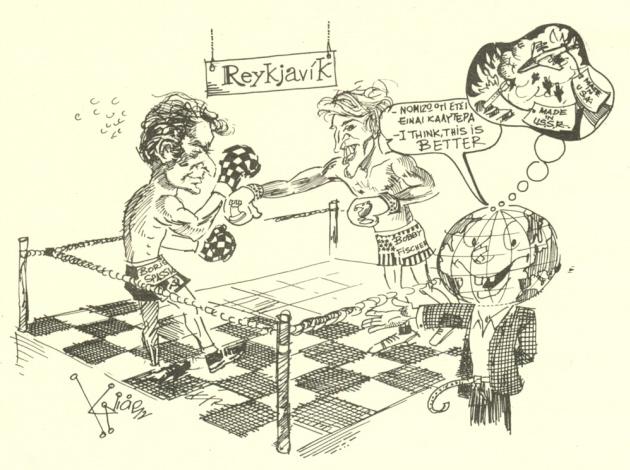
This illustration comes from the multilingual cartoon book Η ζωή μας είναι σκάκι by Κώστα Νιάρχου/Costas Niarchos (Athens, 1972).
(7037)
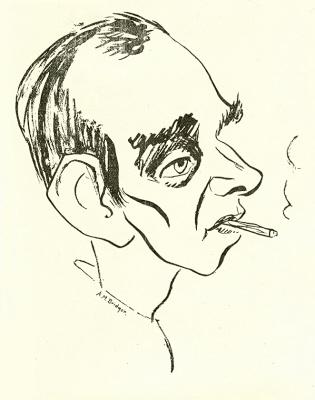
William Winter
This caricature comes from page 193 of the 14 January 1939 CHESS, which reproduced it in a review of Time and Space, the ‘official organ of the Workers’ Chess League’ and ‘a bright new chess magazine with pronouncedly Left tendencies’. William Winter was named as ‘the editor and author of much of the matter’, although the entry in Betts’ Annotated Bibliography names the editor as E. Klein, also stating that the magazine ran for 23 issues, from August 1938 to June 1940.
(7117)
An early example of a comic strip with a chess theme comes from the ‘Rhymo the Monk’ series by Gus Mager. It was reproduced on pages 320-321 of the October 1905 American Chess Bulletin, courtesy of the New York Evening Journal:
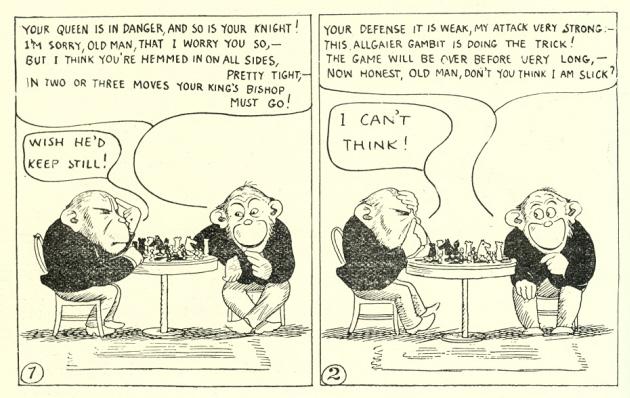
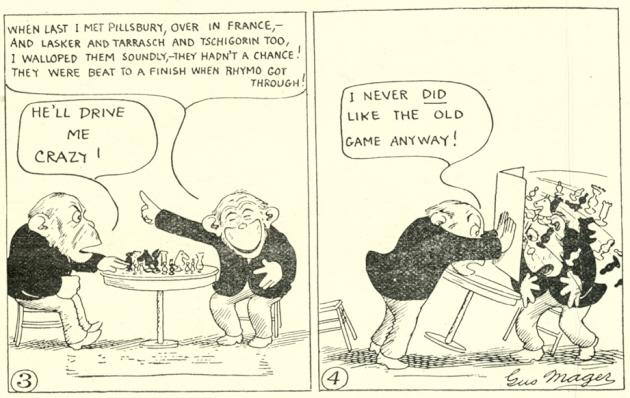
(7234)
Olimpiu G. Urcan points out the following in the Brooklyn Daily Eagle, 18 February 1931, page 24:
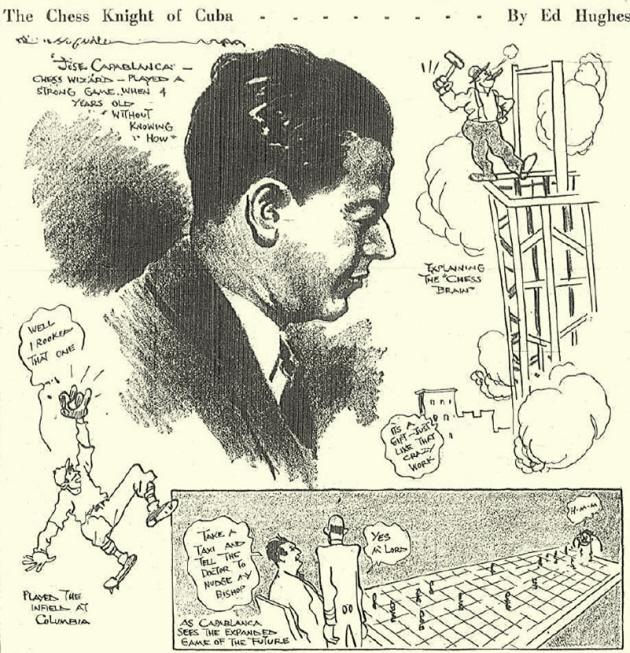
(7337)
See the remainder of C.N. 7337 for Capablanca’s interview with Ed Hughes.
From page 6 of “Among These Mates” (Sydney, 1939), a book which C.J.S. Purdy published under the pseudonym Chielamangus:
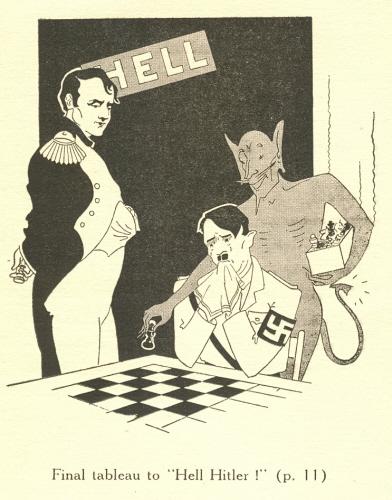
From page 8 of the October 1944 Chess Review:
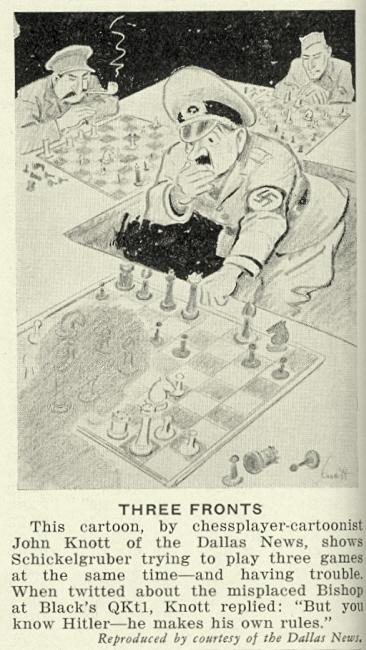
(7402)
See Chess: Hitler and Nazi Germany.
C.N. 5897 gave this cartoon from page 33 of the Chess Weekly, 26 June 1909:
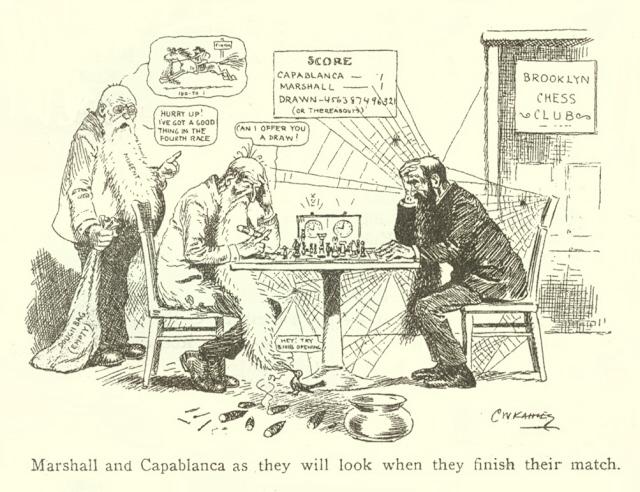
With regard to fears that the 1927 world championship match might drag on forever (‘s’éterniser’) V. Soultanbéieff wrote in a footnote on page 18 of Le match Capablanca Alekhine (published by L’Echiquier in Brussels in 1929):
‘Une caricature spirituelle parue dans la Haagsche Post exprima cette idée d’une façon plaisante. Elle avait pour titre “Le match Capablanca-Alekhine”; la 986e partie est déclarée nulle et elle représentait les deux joueurs – vieillards infirmes et barbus – jouant la partie en 1957 ...’
Can that cartoon be traced?
In the meantime, we recall the following from page 122 of the April-May 1910 Wiener Schachzeitung:
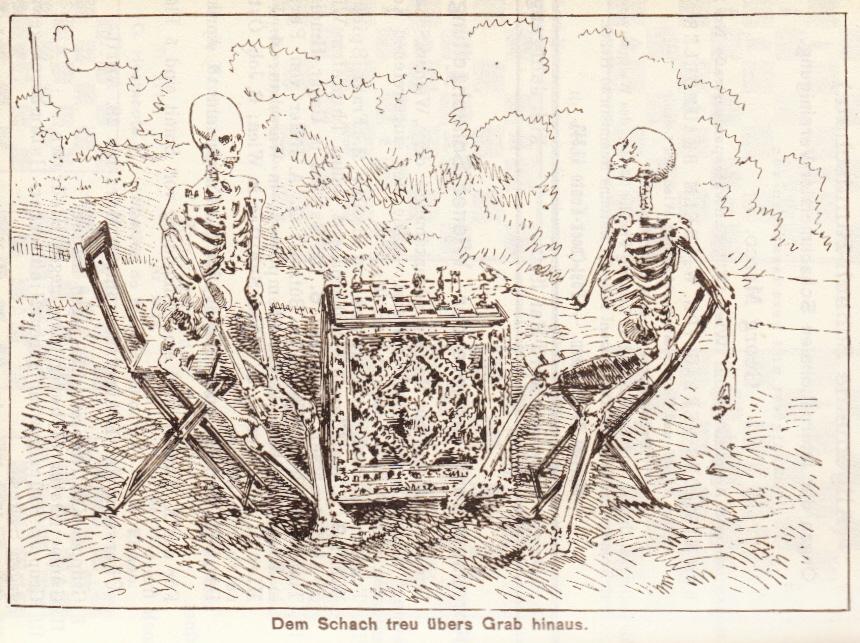
(7441)
A cartoon feature by C.J. Theriat from page 488 of Harper’s New Monthly Magazine, February 1888:
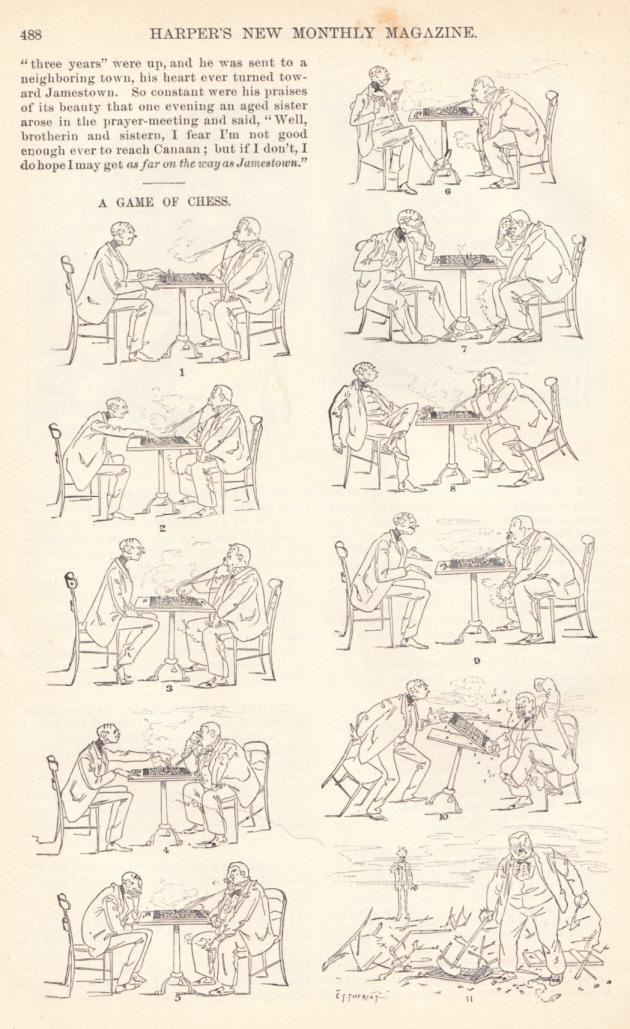
(7449)
From page 139 of Chess Review, May 1963:
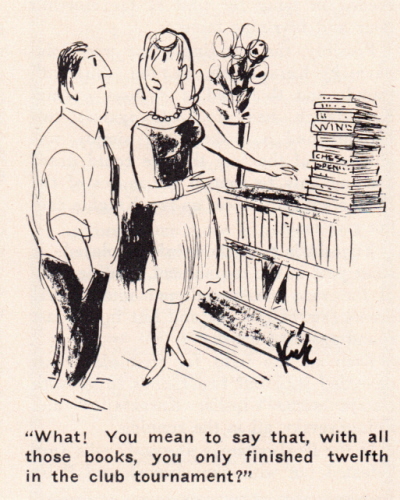
(7494)
Luca D’Ambrosio (Bolzano, Italy) forwards this caricature of Capablanca from page 15 of the Dresdner Neueste Nachrichten of 24 March 1927:
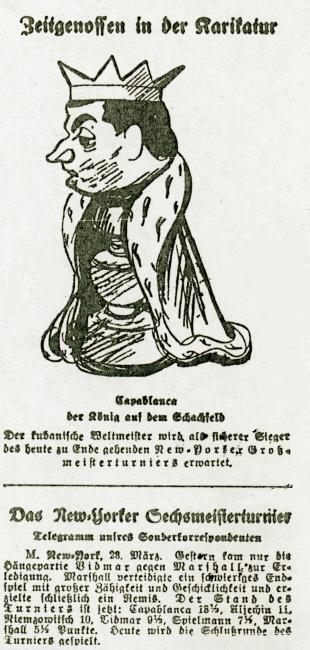
(7549)
A specimen from page 3 of El Mundo Deportivo, 29 September 1929 has been supplied by Dominique Thimognier (Fondettes, France):
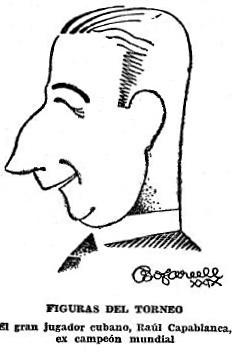
(7576)
Ross Jackson (Raumati South, New Zealand) recently acquired this cartoon, published on page 147 of Punch, 30 September 1882:
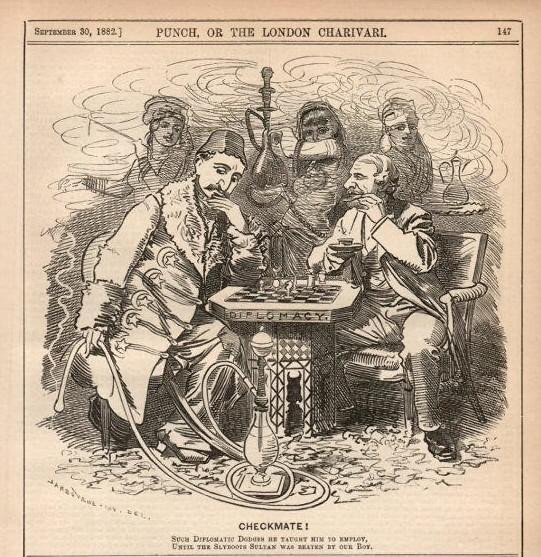
(7579)

(7648)
For the umbrella story see Harry Nelson Pillsbury.
From page 213 of the Westminster Papers, 1 March 1876:
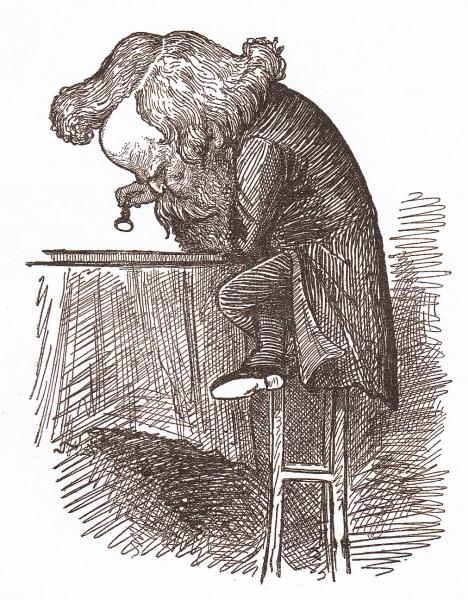
The caricature was mentioned by ‘A Looker-on’ in the 15 March 1876 issue of the Chess Player’s Chronicle, page 53:
‘Have you seen the charming portrait of “Herr Wilhelm Steinitz”, and accompanying letterpress, which appear in the Westminster Papers for the current month? The likeness, though somewhat flattering, is, in my humble opinion, admirable, and has given rise to an incredible amount of fun among chessplayers hereabouts, though I hear that the original somewhat objects to it. On dit, though, of course, I do not vouch for the fact, two actions for libel – or, I suppose, two threats of actions – have been brought against the Papers during the past week. But threatened people, they say, live long.’
(7695)
From page 369 of Aron Nimzowitsch On the Road to Chess Mastery, 1886-1924 by Per Skjoldager and Jørn Erik Nielsen (Jefferson, 2012):
‘The anecdotes have, of course, left the impression that Nimzowitsch disliked smoking very much. But the drawing of Nimzowitsch from the tournament in Copenhagen 1923, however, discloses Nimzowitsch to be – a smoker. A letter from his younger brother Benno to Professor Becker, written in 1935, confirms, though with a chronological vagueness, that Aron was a diligent smoker “when he was young”. The letter also said that he had to give it up because of health problems. Like many other ex-smokers, Nimzowitsch then developed a strong dislike for tobacco smoke.’
The sketch in question is shown below, courtesy of Mr Skjoldager:
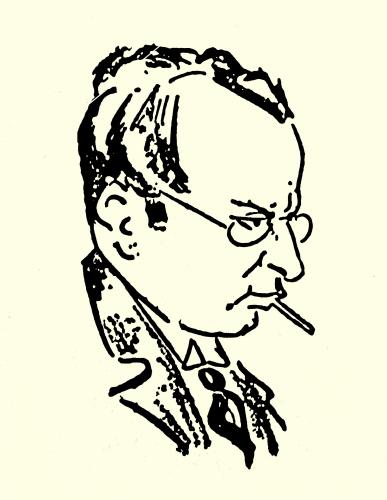
(7832)
See A Nimzowitsch Story.
Dominique Thimognier submits the front cover of Le Petit Vingtième, 2 July 1936, featuring General Alcazar and Tintin in L’oreille cassée (The Broken Ear):
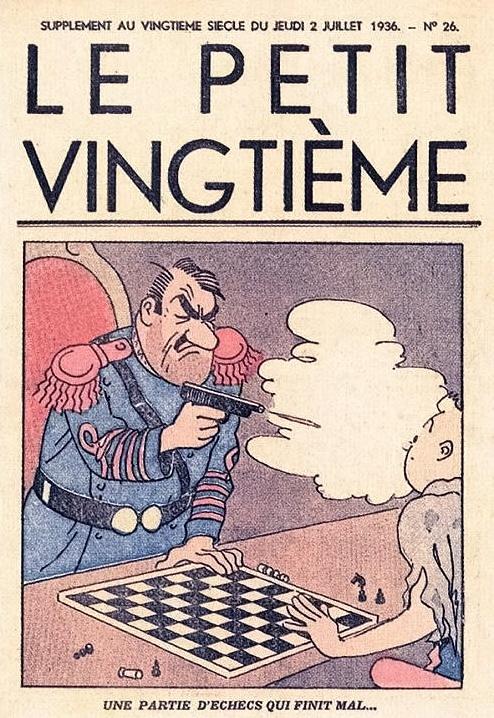
(8113)
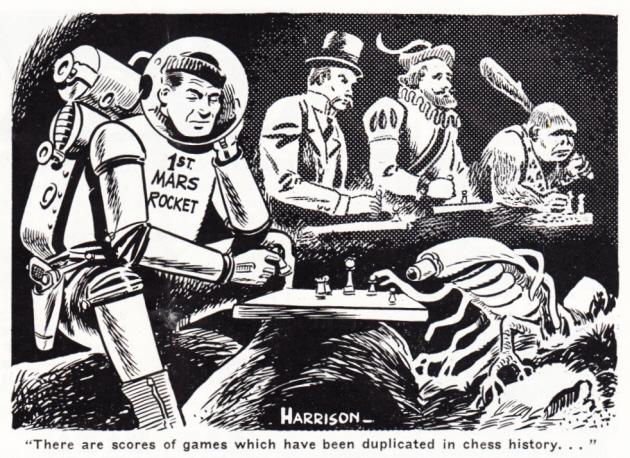
Source: Chess Review, March 1953, page 77.
(8257)
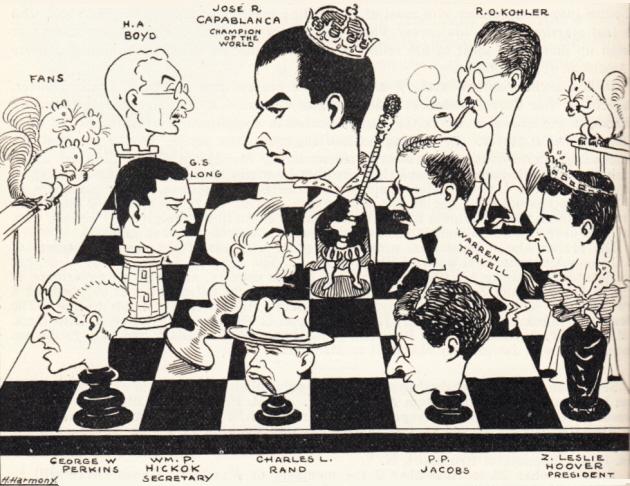
Source: American Chess Bulletin, November 1918, page 234. The item came from the Evening World, 23 September 1918 and concerned a meeting of the Correspondence Chess League of America.
(8307)
The front cover of Caïssa, 1 May 1950 has been forwarded by Alan McGowan (Waterloo, Canada):
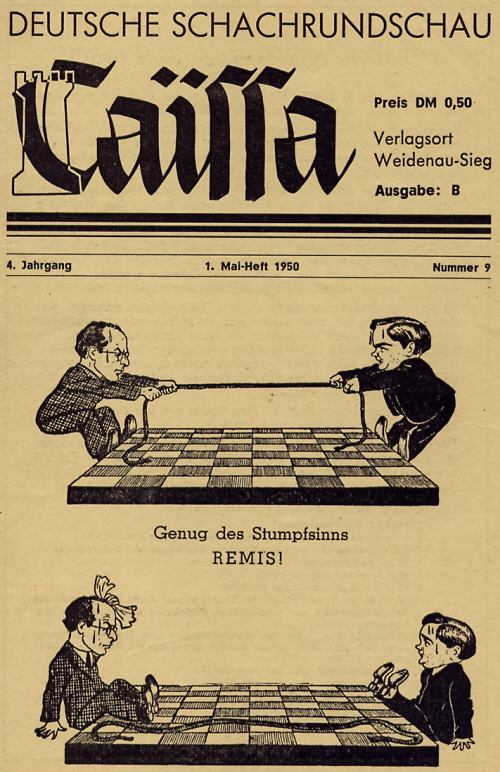
The magazine gave no explanation (concerning the context, for instance, or the rotation of the chessboard), but Mr McGowan notes that, as mentioned on page 129 of the issue, the Candidates’ tournament in Budapest was in progress. One of the games between Bronstein and Kotov was drawn in 15 moves.
(8437)
There has been a comic-strip chess magazine, The Incredible Adventures of Chessman:
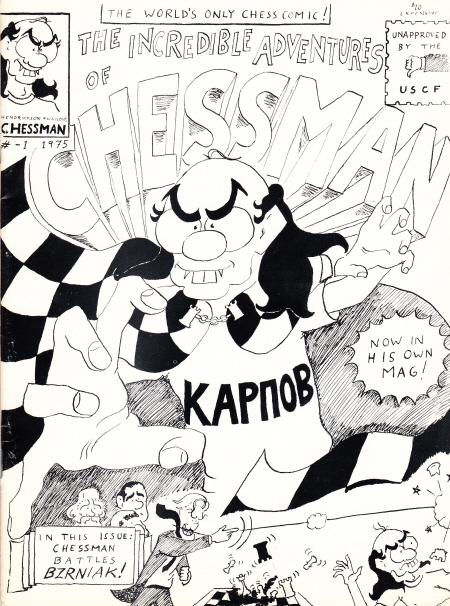
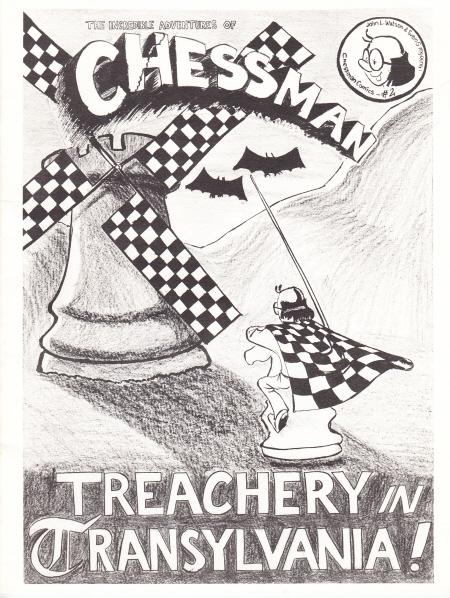
We believe that there were only these two issues, published in 1975 and 1982. The text of both was by John Watson, with the artwork credited to Chris Hendrickson (1975) and Svein G. Myreng (1982).
(8439)
Early cartoons depicting computers/machines and chess are always welcome. From page 65 of the December 1946 CHESS:
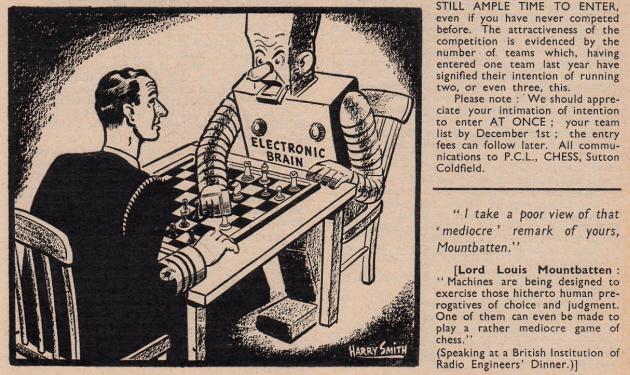
(8464)
From page 54 of the February 1928 Wiener Schachzeitung:
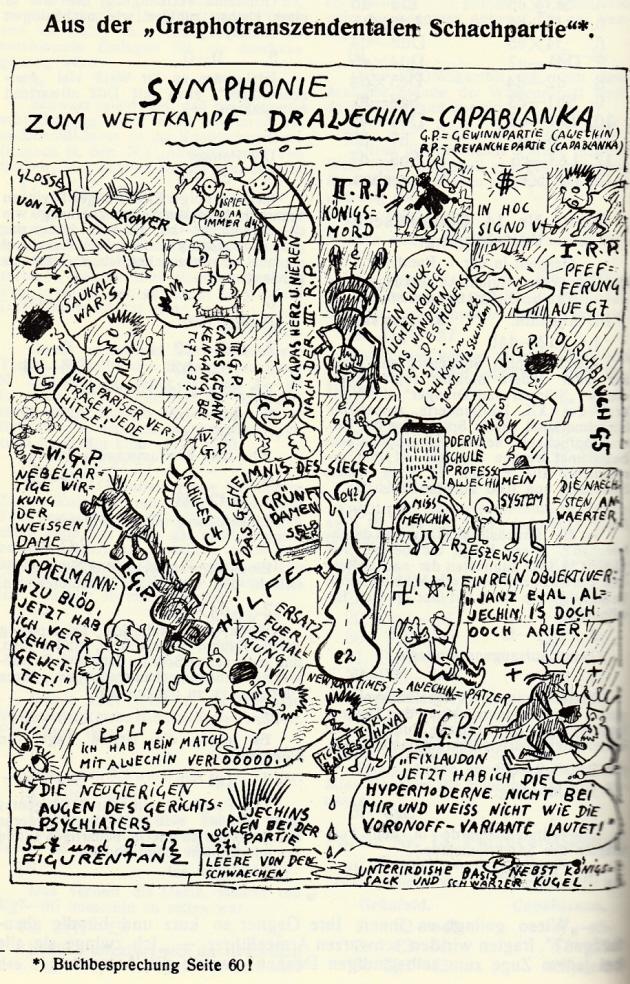
And from page 60 of the same issue:

As reported by a correspondent in C.N. 7728, the Wiener Schachzeitung is available online at the ANNO website.
(8471)
A ‘once’ yarn from a column by Al Horowitz on page 8 of the September 1948 Chess Review:
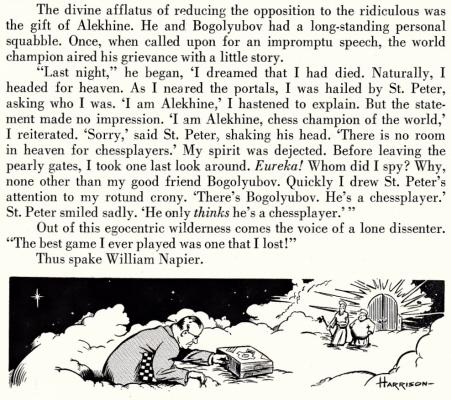
Horowitz also considered that the story, worded differently, merited a full page (page 134) in his book The New York Times Guide to Good Chess (New York, 1969).
The earlier C.N. items (see too page 229 of Kings, Commoners and Knaves) pointed out that the joke had been published on page 6 of the July 1898 American Chess Magazine. The earliest known inclusion of Alekhine and Bogoljubow’s names is in an article by Julius du Mont on page 133 of the May 1941 BCM.
(8672)
From page 243 of CHESS, April 1966:
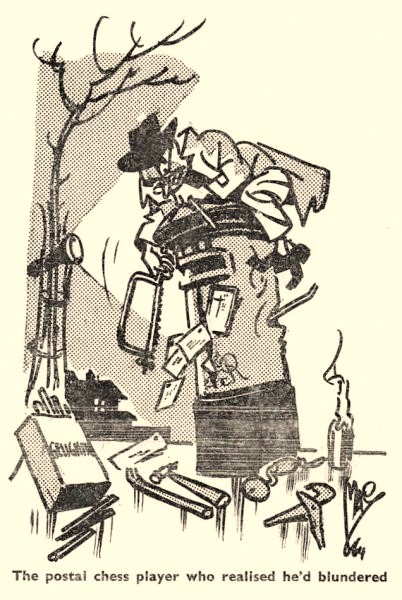
(8713)
Information is sought about this picture, from page 277 of CHESS, July 1972:
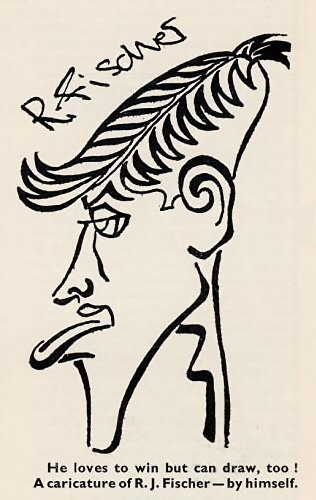
(8721)
Rudy Bloemhard (Apeldoorn, the Netherlands) has found the website
of
Marina
Petric, which states that the Fischer caricature was by her
late father, Berislav Petric. [Link broken.]
(8724)
From Michael Clapham (Ipswich, England):
‘The Fischer caricature is included in the montage on the front cover of the Winter 1961 issue of the American Chess Quarterly:
The montage appears to come from promotional material for the tournament held in Bled on 2 September-4 October 1961. It features the 20 contenders, plus Milan Vidmar, the tournament director.
The website referred to in C.N. 8724 mentions that the caricatures shown were from a tournament in Yugoslavia in 1959. However, only the first group image of eight is from the Candidates’ tournament held there in 1959.
Three of the larger images are included in the montage from Bled, 1961 (Fischer, Matanović and Petrosian), but I cannot identify most of the other large images. However, a similar caricature to one of these (although Gligorić is facing in the opposite direction) is on the cover of a booklet, published in Belgrade, on Zurich, 1959:’
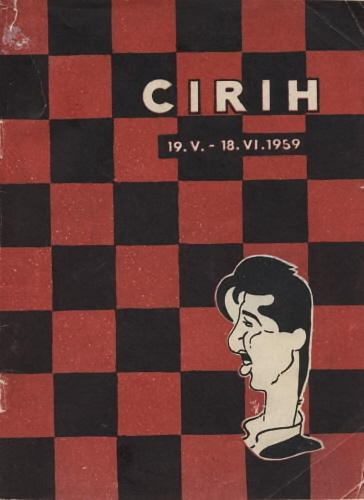
The other caricature of Gligorić referred to by Mr Clapham was also on the front cover and title page of 100 partija Svetozara Gligorića (Belgrade, 1952). From our copy:
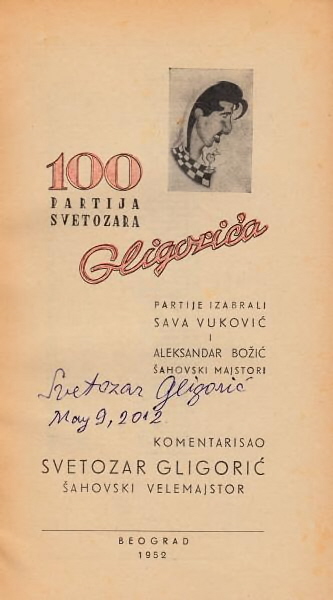
(8778)
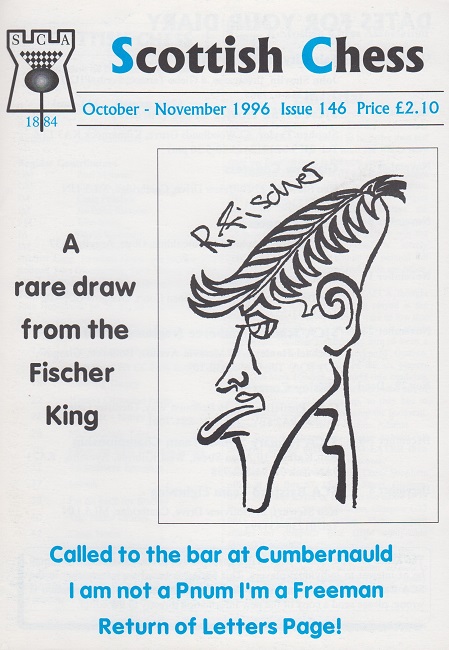
This caricature is often attributed to Fischer himself, but in C.N. 8724 a correspondent reported that the website of Marina Petric showed it as one of many by her late father, Berislav Petric.
(11096)
Marina Petric (Austin, TX, USA) informs us that her father, Berislav Petric, drew a set of chess caricatures in Belgrade and asked the players concerned, including Fischer, to sign them. She has provided the two pictures below:
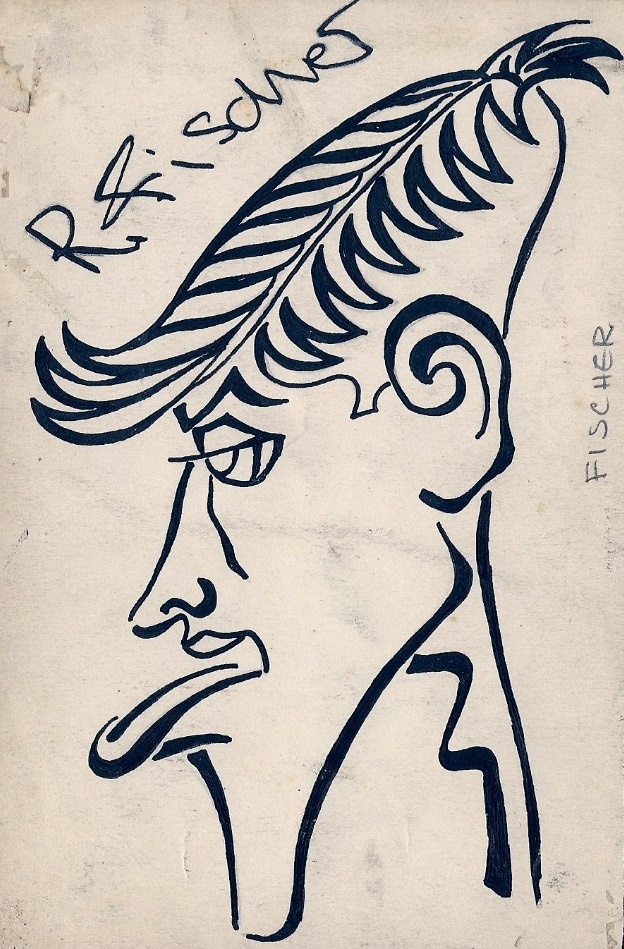
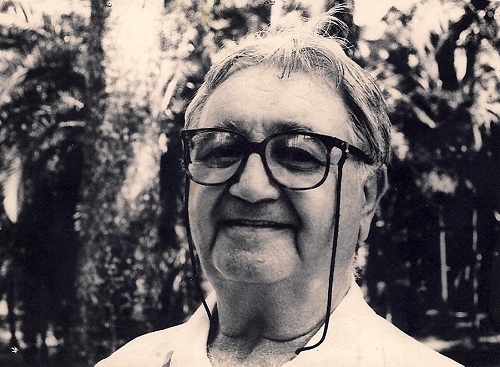
Berislav Petric
At our request, Marina Petric has added that her father was born in Sarajevo on 3 May 1929. After graduating in architecture, he emigrated to Brazil in 1964, and died in Rio de Janeiro on 8 May 1998.
(11110)
Two photographs in our collection on which we lack any particulars:
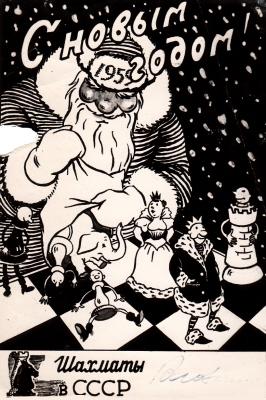
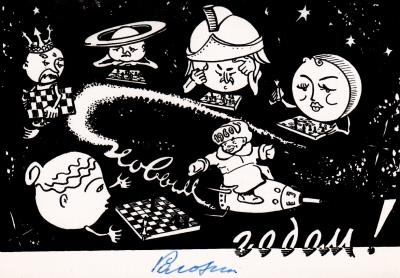
(8771)
As noted by Dan Scoones (Port Coquitlam, BC, Canada), the New Year cards (1959 and 1960) were signed by Viascheslav Ragozin.
For purposes of comparison, below is the title page of one of our copies of A. Koblentz’s book on the Sicilian Defence, Сицилианская защита (Moscow, 1955), with an inscription by Ragozin to Golombek:
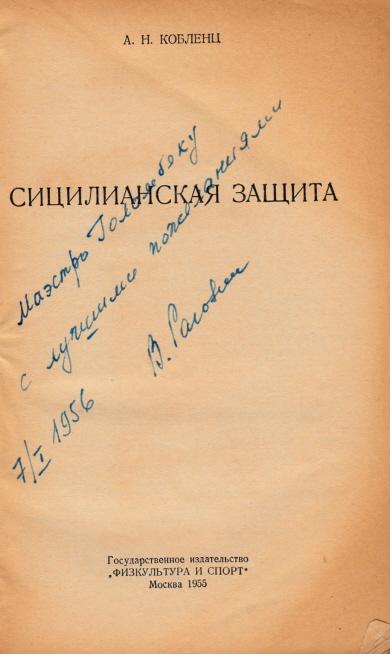
(8829)
Further to C.N. 8771, below is a cartoon (cutting only) from an unidentified Soviet newspaper which features Karpov:
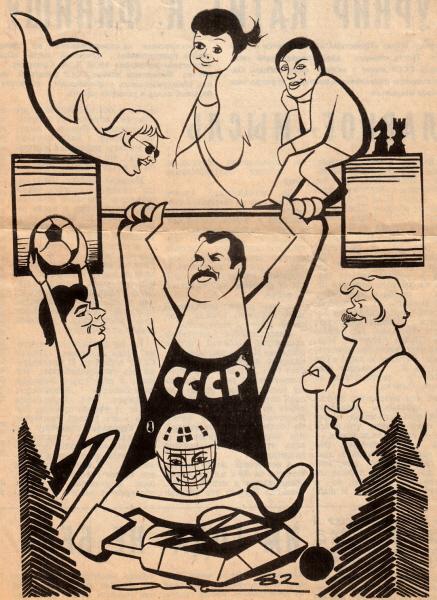
(8785)
Information about sketches, cartoons and other artwork by prominent chess figures is always welcome. From the front cover of Chess Life, 20 April 1961:
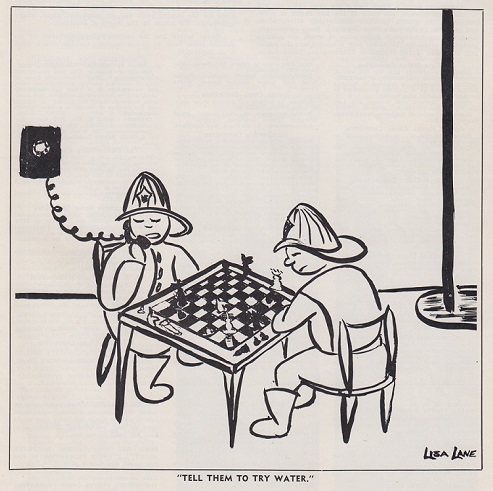
(8927)
From page 119 of A History of Chess by Jerzy Giżycki (London, 1972):
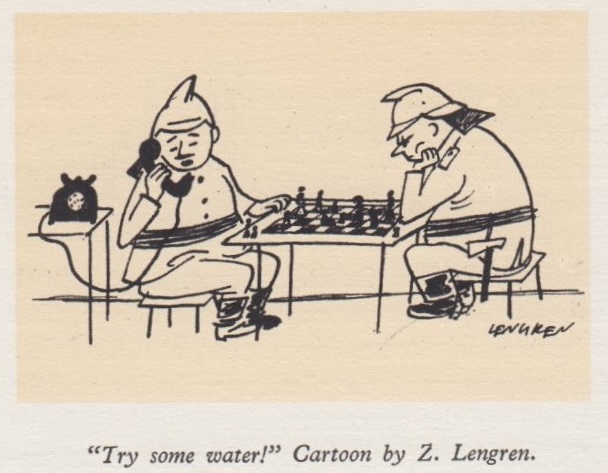
When was the cartoon by Zbigniew Lengren first published?
(8943)
Tomasz Lissowski (Warsaw) forwards, courtesy of Paweł Dudziński, the cartoon by Zbigniew Lengren as it appeared on page 98 of Z szachami przez wieki i kraje by Jerzy Giżycki (Warsaw, 1960):
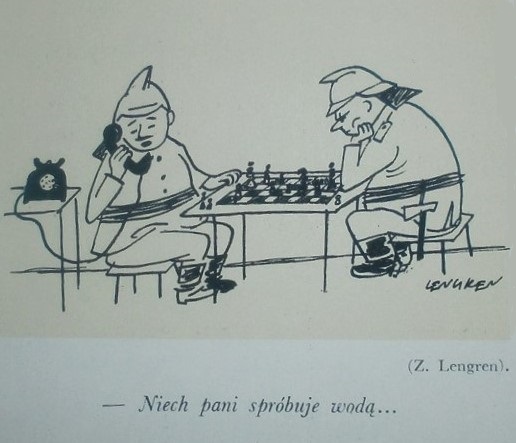
Lisa Lane’s very similar cartoon (see C.N. 8927 above) was on the front cover of Chess Life, 20 April 1961.
(9007)
A drawing by W.H. Cozens from page 77 of the February 1941 CHESS:
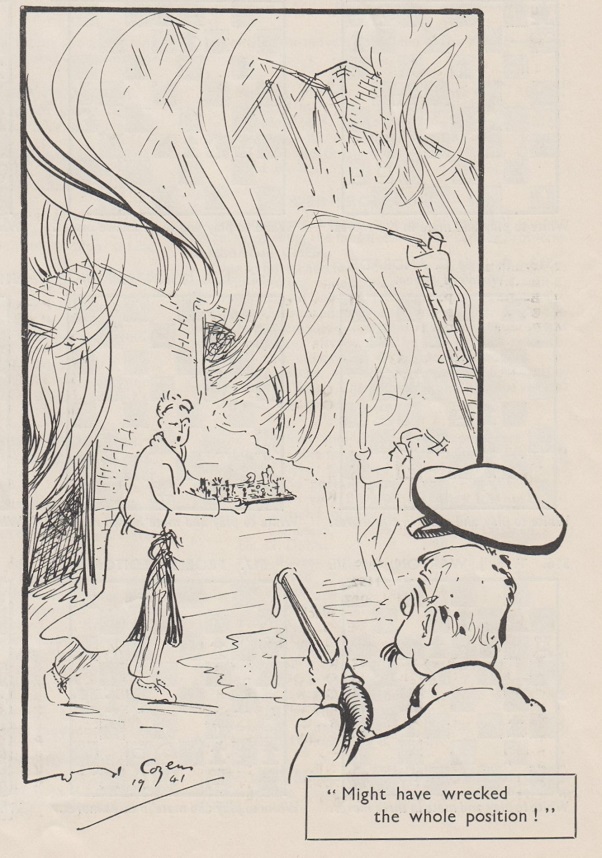
(10427)
Further examples:
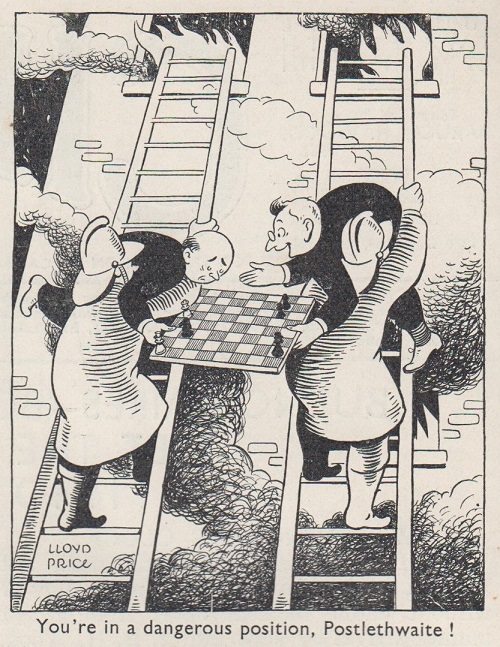
CHESS, 20 August 1939, page 416
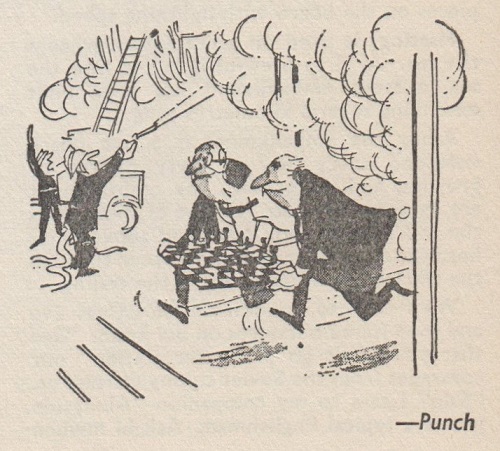
CHESS, 15 December 1962, page 57
See too page 56 of Short v Kasparov The Hi-jacking of The World Chess Championship by William Hartston (London, 1993), page 43 of Square Minded by Saskia de Winter and Willy de Winter (Condesa, 2001) and page 17 of Chess for Laughs by Joel Rothman (London, 2007).
Another illustration of absorption in chess comes from page 84 of Square Minded:
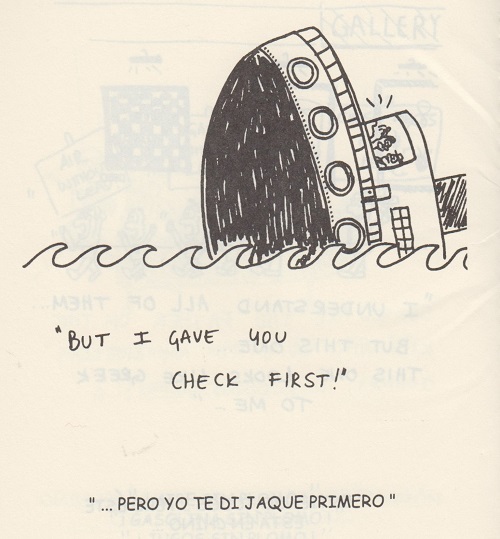
A particularly skilful cartoonist is Jovan Prokopljević. From his 1999 book Chess Miniatures & Caricatures:
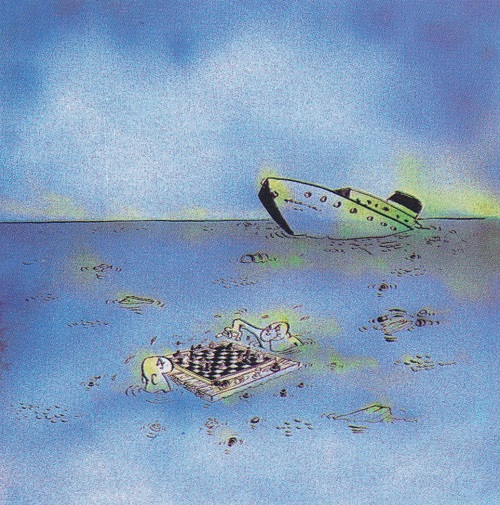
(10879)
Also on the absorption theme:
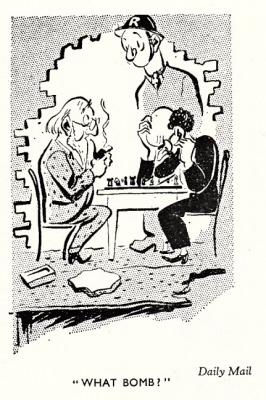
CHESS, January 1943, page 52.
(8726)
Addition on 5 October 2024:
From page 21 of the September 1948 Chess Review:

Fire has been the theme of several cartoons and now it is shown in a Hairbreadth Harry comic strip by Charles William Kahles (1878-1931):

Brooklyn Daily Eagle, 24 January 1924, page A3

Brooklyn Daily Eagle, 25 January 1924, page A3
As discussed in C.N.s 5897 and 5921, cartoons by Kahles were published in two issues of the Chess Weekly in 1909, in relation to the Capablanca v Marshall match.
(11720)
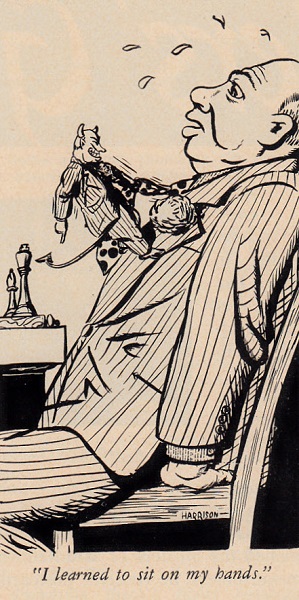
Source: Chess Review, May 1947, page 29
(8890)
Gerard Killoran (Ilkley, England) provides a set of caricatures on page 261 of The Graphic, 19 August 1922:
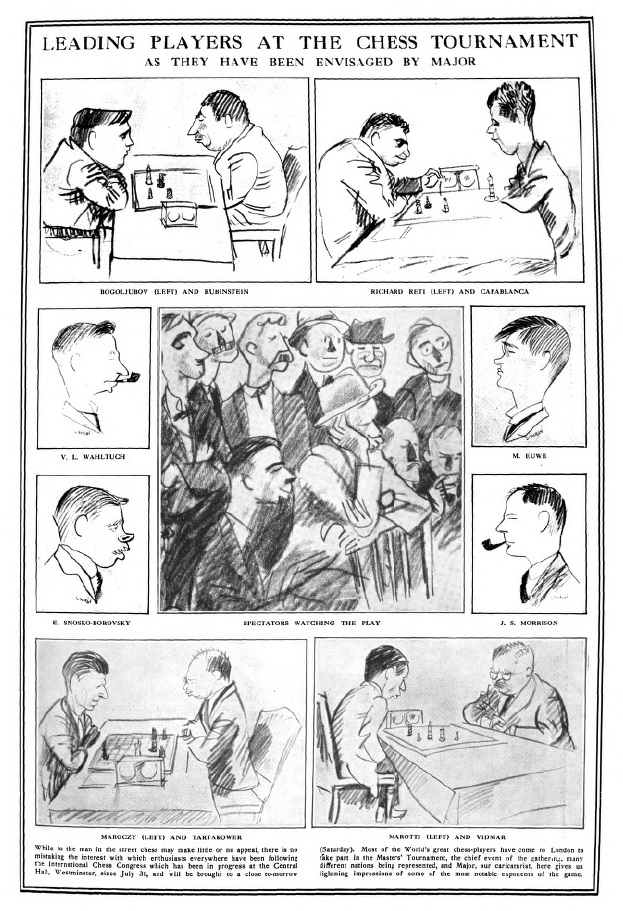
(8982)
Harrie Grondijs (Maastricht, the Netherlands) has forwarded this cutting from De Telegraaf, 17 May 1944, concerning the tournament in Baarn:
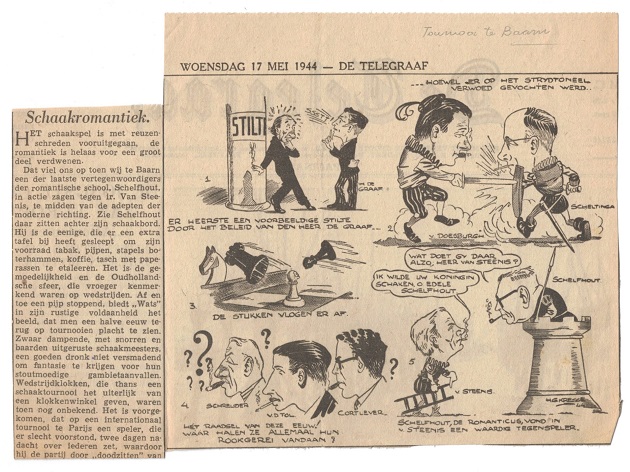
Our correspondent has translated the captions:
1. ‘There was exemplary quietness enforced by Mr De Graaf ...’ 2. ‘... although on the battleground some heavy fighting was going on.’ 3. ‘The pieces flew all around.’ 4. ‘The puzzle of the century! Where do they all get their smoking gear from?’ 5. ‘What are you up to, Mr van Steenis?’ ‘I wish to abduct your queen, O honourable Schelfhout.’ ‘Schelfhout, the romantic, met a worthy opponent in van Steenis).’
(9023)
From Dominique Thimognier, concerning Carlsbad, 1929:
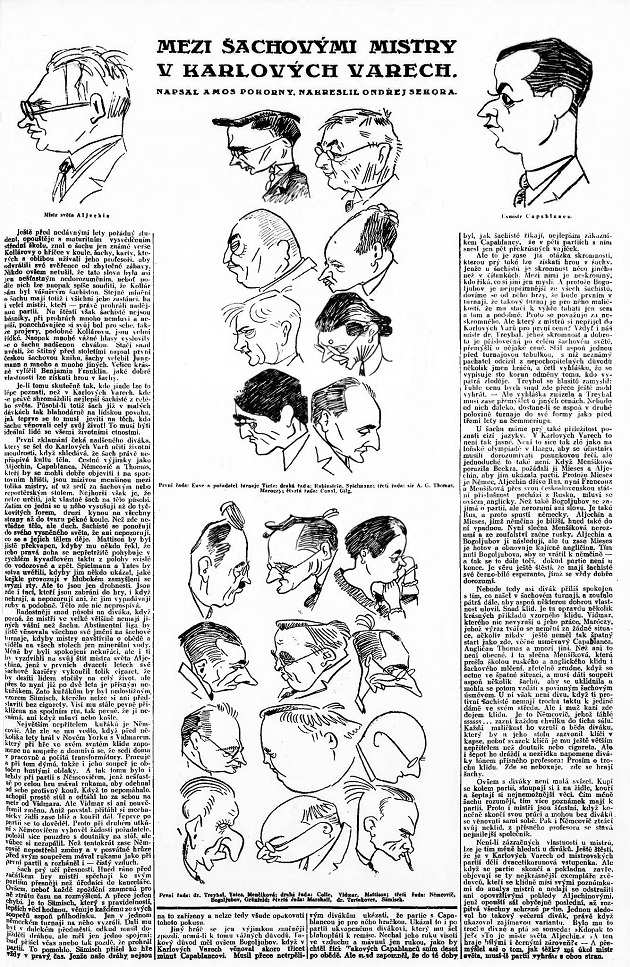
Lidové noviny, 11 August 1929, page 17 (Larger version)
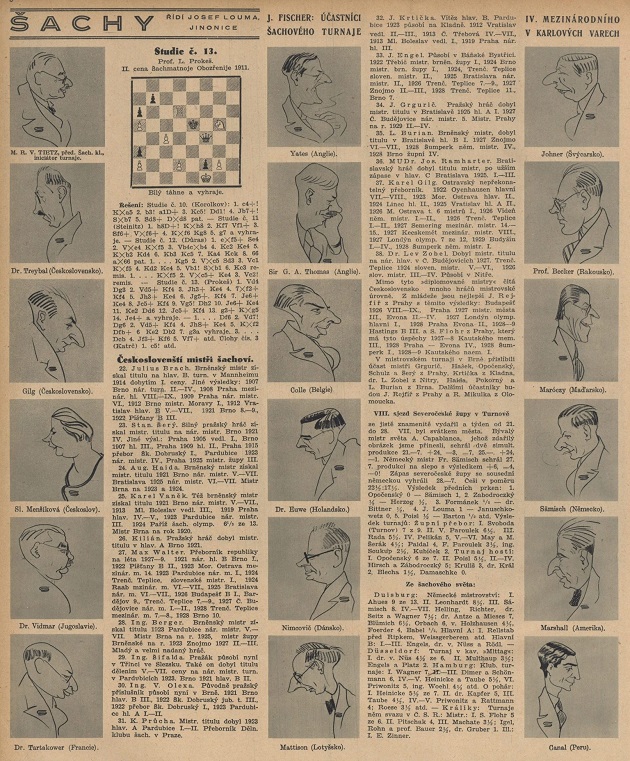
Pestrý týden, 17 August 1929, page 8 (Larger version)
(9026)
As regards announcing an attack on the rook, we note a caricature of Capablanca in the Argentinian publication La Vida Moderna, 28 June 1911 which was reproduced on page 64 of Los años locos del ajedrez argentino by Juan Sebastián Morgado (Buenos Aires, 2013). The author has kindly provided the ‘chess consultation’ cutting:
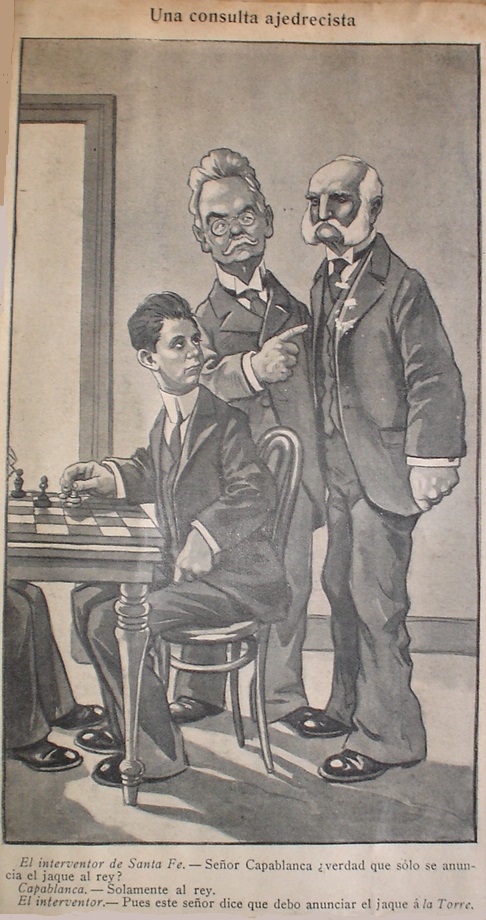
From page 63 of the book:
‘El semanario La Vida Moderna, aprovechando la presencia de Capablanca en el país, publica una caricatura muy graciosa, haciendo un chiste sobre este tema. Pueden verse a Capablanca (sentado, jugando), Gil y Lisandro de la Torre, entablándose este diálogo:
Interventor Gil: Señor Capablanca ¿Verdad que sólo se anuncia el jaque al rey?
Capablanca: Solamente al rey.
Interventor Gil: Pues este señor dice que debo anunciar el jaque a la Torre.’
Mr Morgado has sent us this translation:
‘Taking advantage of Capablanca’s presence in the country, the weekly publication La Vida Moderna had a very amusing cartoon, making a joke about this topic. It showed Capablanca (seated and playing), Gil and Lisandro de la Torre having this dialogue:
Interventor Gil: Señor Capablanca, is it true that check is announced only to the king?
Capablanca: Yes, only to the king.
Interventor Gil: But this gentleman says that I have to announce check to the rook.’
Our correspondent also explains the context:
‘There is a pun based on the fact that “this gentleman” was Lisandro de la Torre and that torre is the Spanish word for rook or tower. The political situation in the Santa Fe province was complicated; the elected governor had been removed by the central government, and Anacleto Gil had been appointed to replace him. Lisandro de la Torre was a very popular representative whose political career was in the ascendancy.’
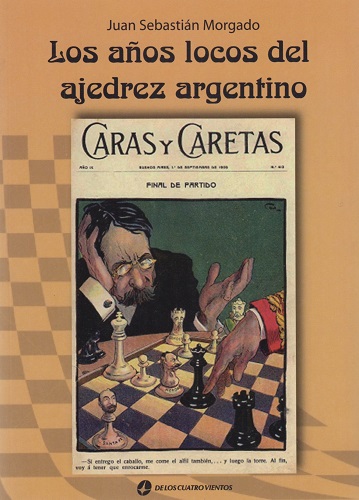
(9031)
The immense popularity of chess in 1972 is demonstrated by a double-page spread of cartoons (‘There’s No Business Like Chess Business’) by Mahood on pages 118-119 of the 26 July-1 August 1972 issue of Punch:
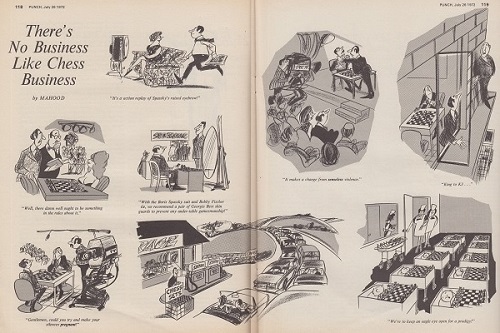
One example:
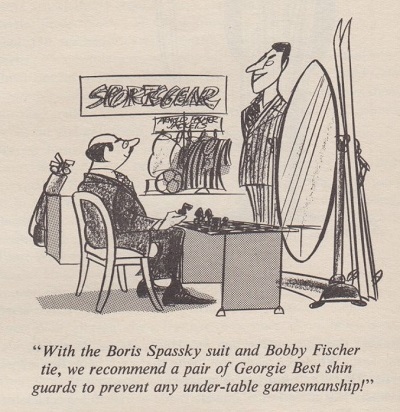
(9105)
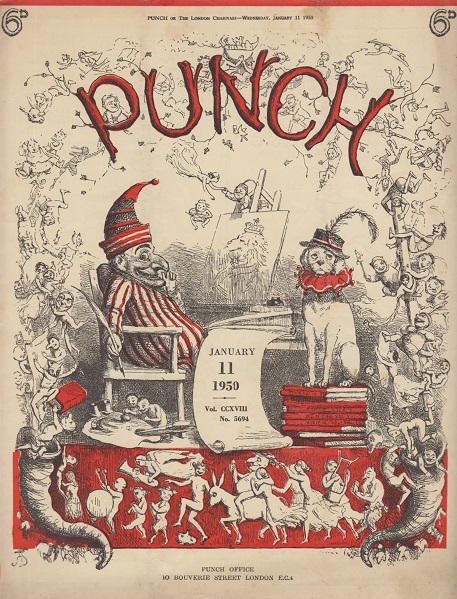
Pages 34-35 of the 11 January 1950 Punch had an article by B.A. Young on Hastings, 1949-50:
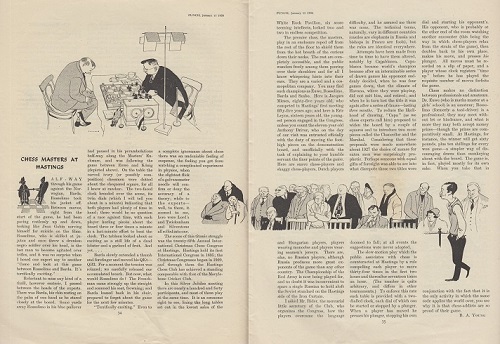
Two brief excerpts:
‘Half-way through his game against the Norwegian, Barda, Rossolimo took his jacket off. Between moves, right from the start of the game, he had been pacing restlessly up and down, looking like Jean Gabin nerving himself for suicide on the films. Rossolimo, who is skilled at ju-jutsu and once threw a drunken negro soldier over his head, is the last man to become agitated over trifles ...’
‘Even to a complete ignoramus about chess there was an undeniable feeling of suspense, the feeling you get from watching a complicated experiment in physics, when the slightest flick of a galvanometer needle will confirm or deny the accuracy of a theory; while to the experts – well, to them, it seemed to me, here were Lord’s and Twickenham and Silverstone all rolled into one.’
Mention was made of the game between König and Euwe (round three, 31 December 1949), and a cartoon showed a position which arose over the board:
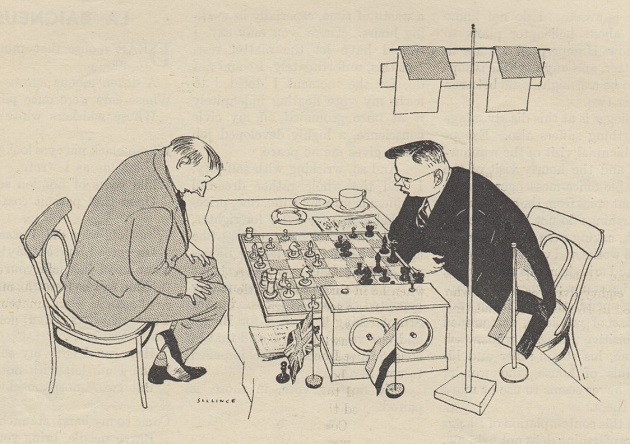
The article also referred to Arthur Rider, the Secretary of the Hastings and St Leonards Chess Club. When he died four years later, he received a 36-line obituary by D.J. Morgan in the March 1954 BCM. The final paragraph, reproduced below, illustrates how well written the BCM used to be:
‘In the international chess arena, as in much else, the limelight is thrown on the performers. They take the stage; they enrich life with their skill. Too often, little is known of the personalities behind the scenes who make all this possible; of their capacity for unremitting and self-sacrificing work, of their gifts for organization, of their powers “to see things whole” combined with great attention to details, of the wisdom and diplomacy which remove friction and set the wheels running smoothly. Amongst such, A.A. Rider was a notable example. We mourn his passing; we are grateful for his achievements. These will long keep his memory green, and will inspire those who take up where he left off.’
(9107)
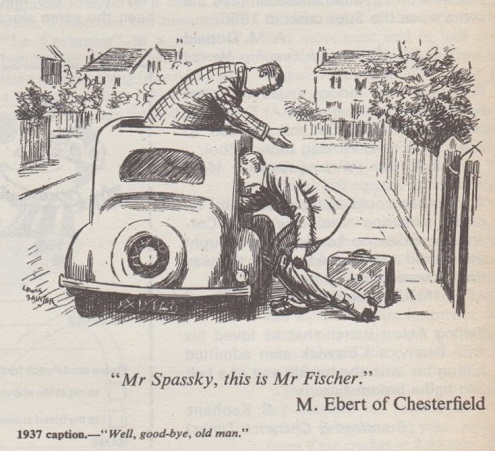
Punch, 16-22 August 1972, page 220
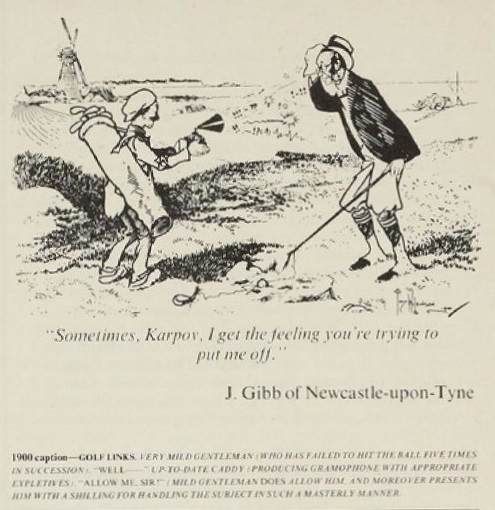
Punch, 16-22 August 1978, page 66.
(9124)
A cartoon by Harrison on page 27 of Let’s Play Chess ‘by the Editors of Chess Review’ (New York, 1950):
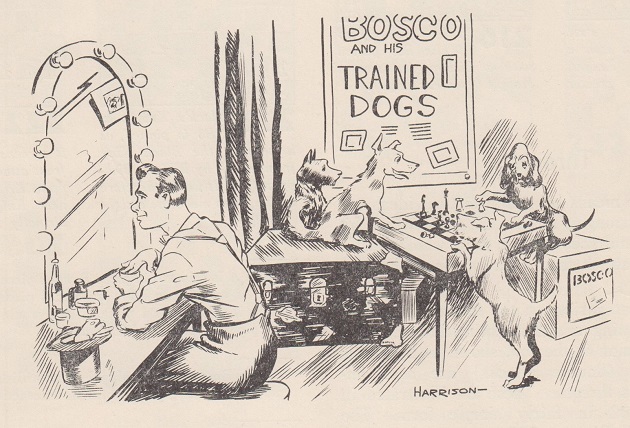
(9321)
From page 209 of Chess Review, July 1959:
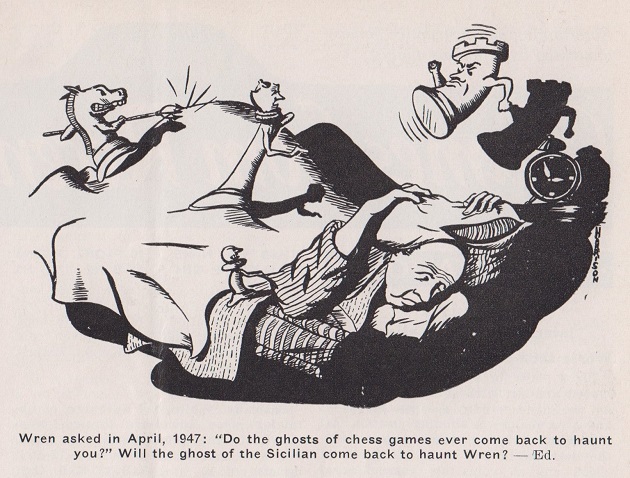
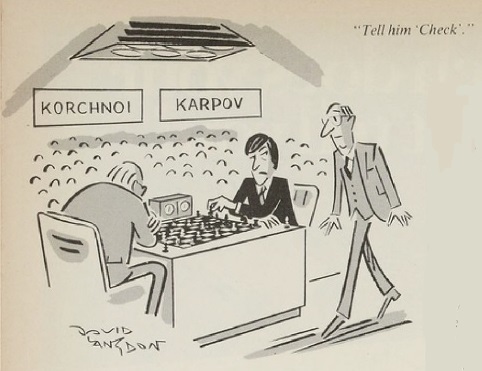
Source: Punch, 14 October 1981, page 652. A chess article on the same page, ‘Above Board?’ by Jonathan Sale, attained a similar level of humour.
(9259)
Two cartoons from, respectively, page 19 and page 25 of Let’s Play Chess ‘by the Editors of Chess Review’ (New York, 1950):
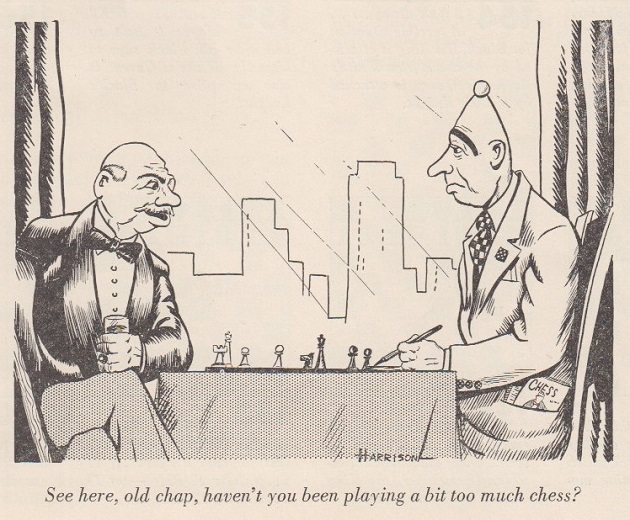
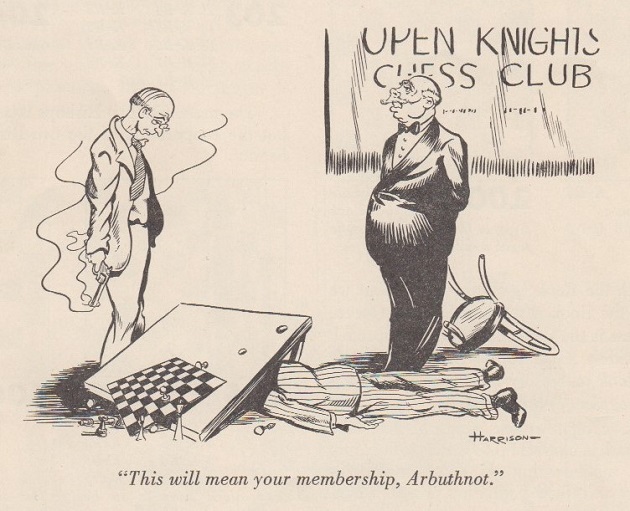
(9359)
Unlikely as it may seem, the 1971 Candidates’ Final match prompted a set of five chess cartoons by Bill Tidy on pages 494-495 of Punch, 13 October 1971. The first one is indicative of their standard:
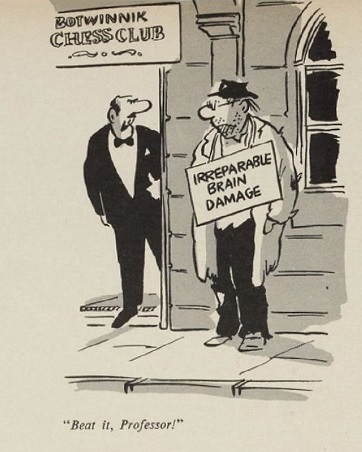
(9471)
From page 93 of CHESS, January 1940:
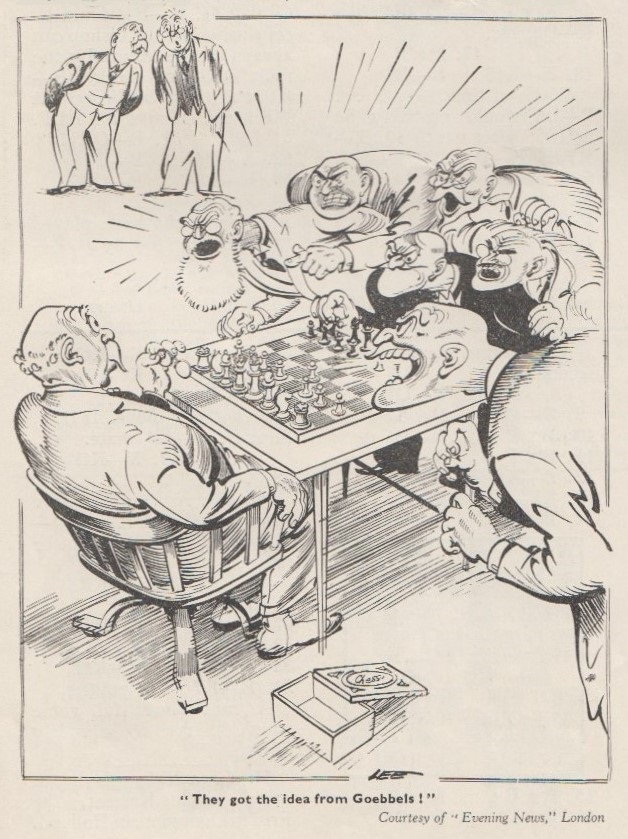
(9637)
Gerard Killoran provides a cartoon from page 8 of the Sun (Sydney), 30 October 1929:
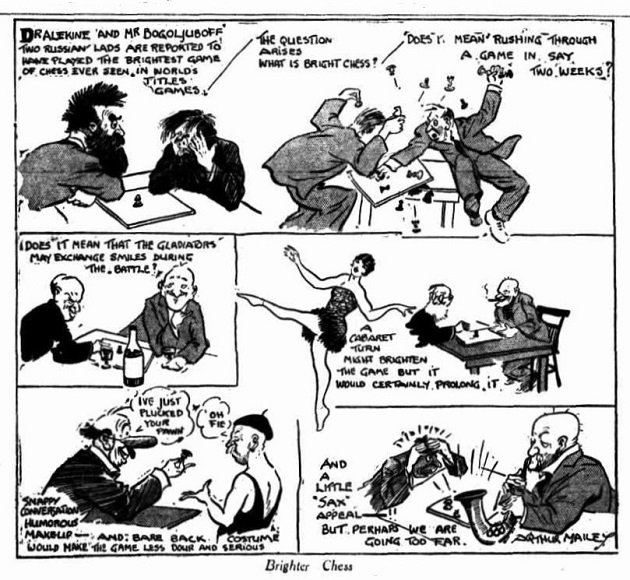
The cartoonist, Arthur Mailey (1886-1967), was an Australian test cricketer.
(9976)
Further chess cartoons by Arthur Mailey have been found by Gerard Killoran in the Sun (Sydney), 15 April 1923, page 13; the Sun (Sydney), 6 May 1924, page 4; the Newcastle Sun, 24 August 1933, page 8.
Our correspondent also points out a brief article by Mailey, ‘Training in Secret’ (the Newcastle Sun, 10 September 1935, page 2), concerning the Alekhine v Euwe world championship match.
(9989)
Peter Verschueren (Kudelstraat, the Netherlands) sends this cartoon by Jo Spier (1900-78) from page 11 of De Telegraaf, 16 December 1935:
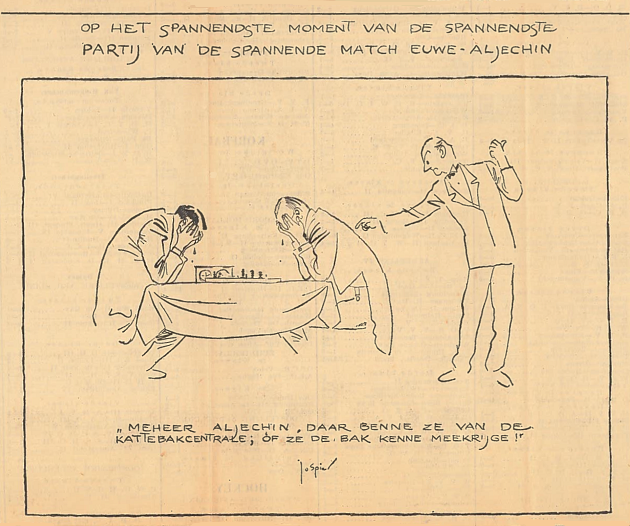
The heading and caption:
At the most exciting moment in the most exciting game of the exciting Euwe-Alekhine match.
‘Mr Alekhine, them cat litter boys is askin’ if they can take the tray out.’
(10054)
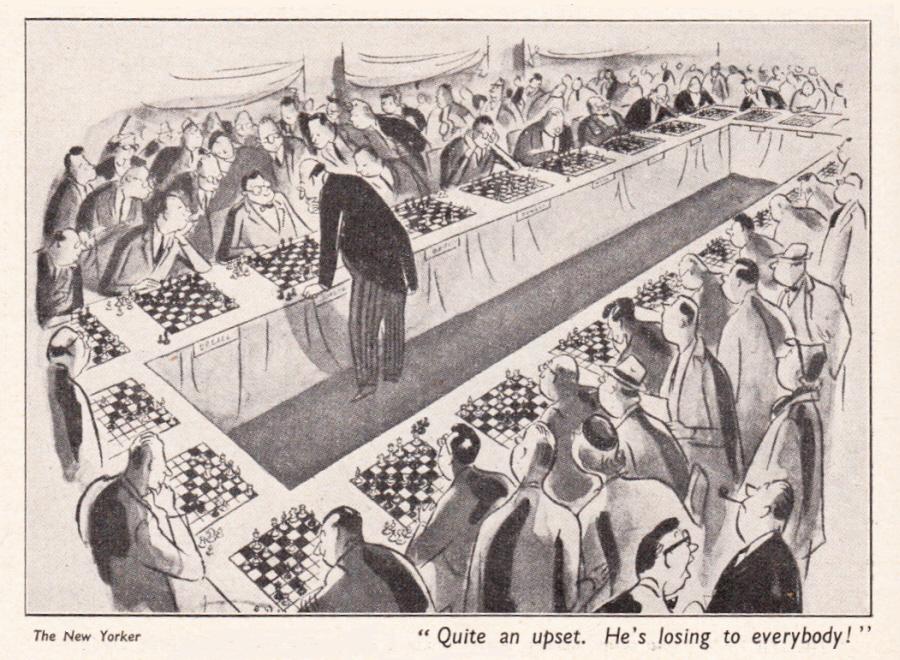
CHESS, January 1952, page 70
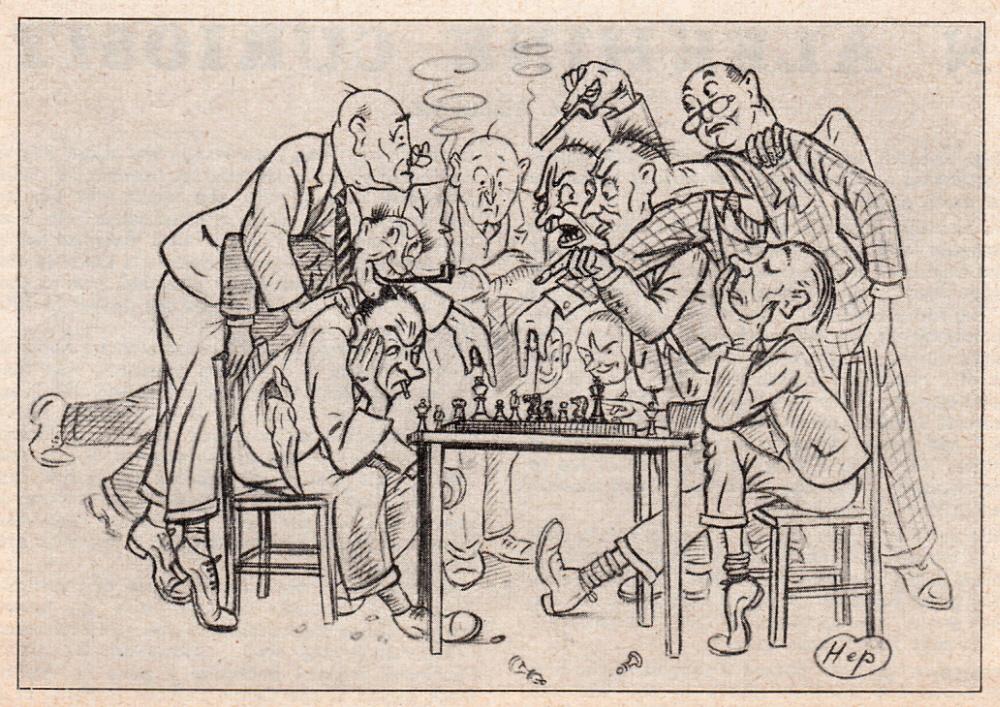
CHESS, January 1952, page 75
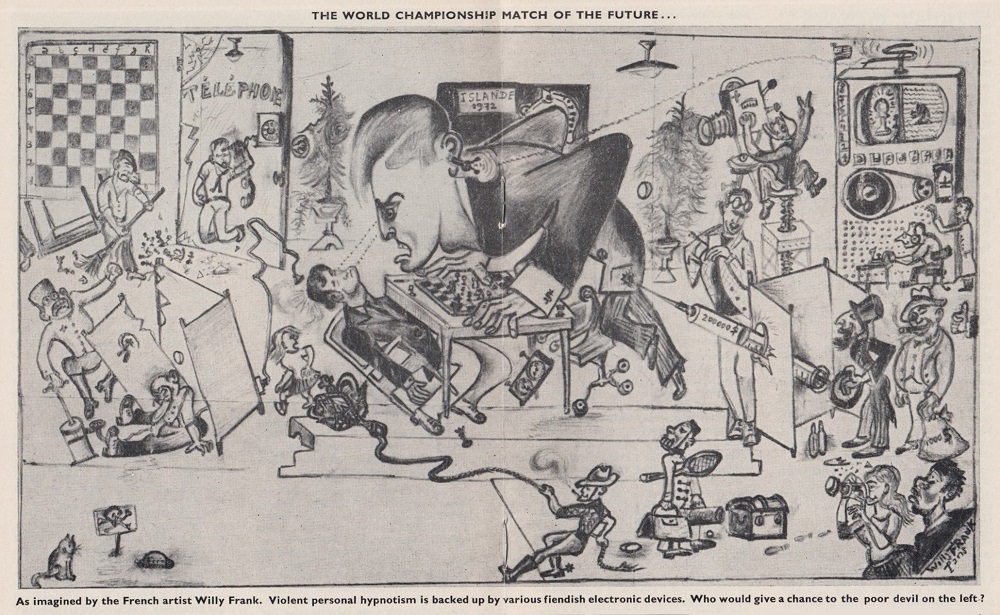
CHESS, November 1972, pages 48-49
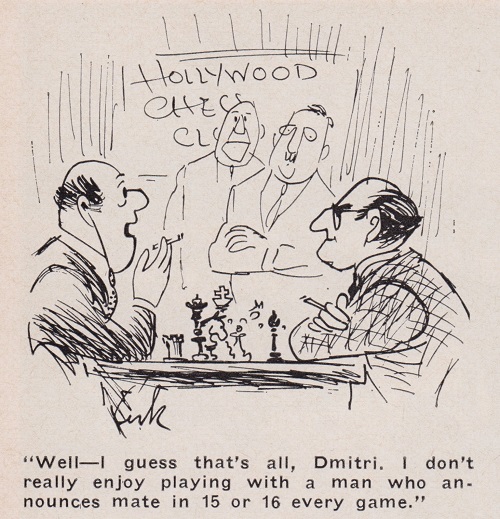
Chess Review, July 1967, page 198
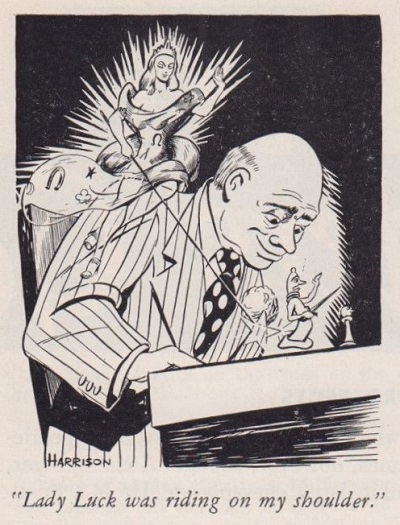
Chess Review, January 1948, page 15
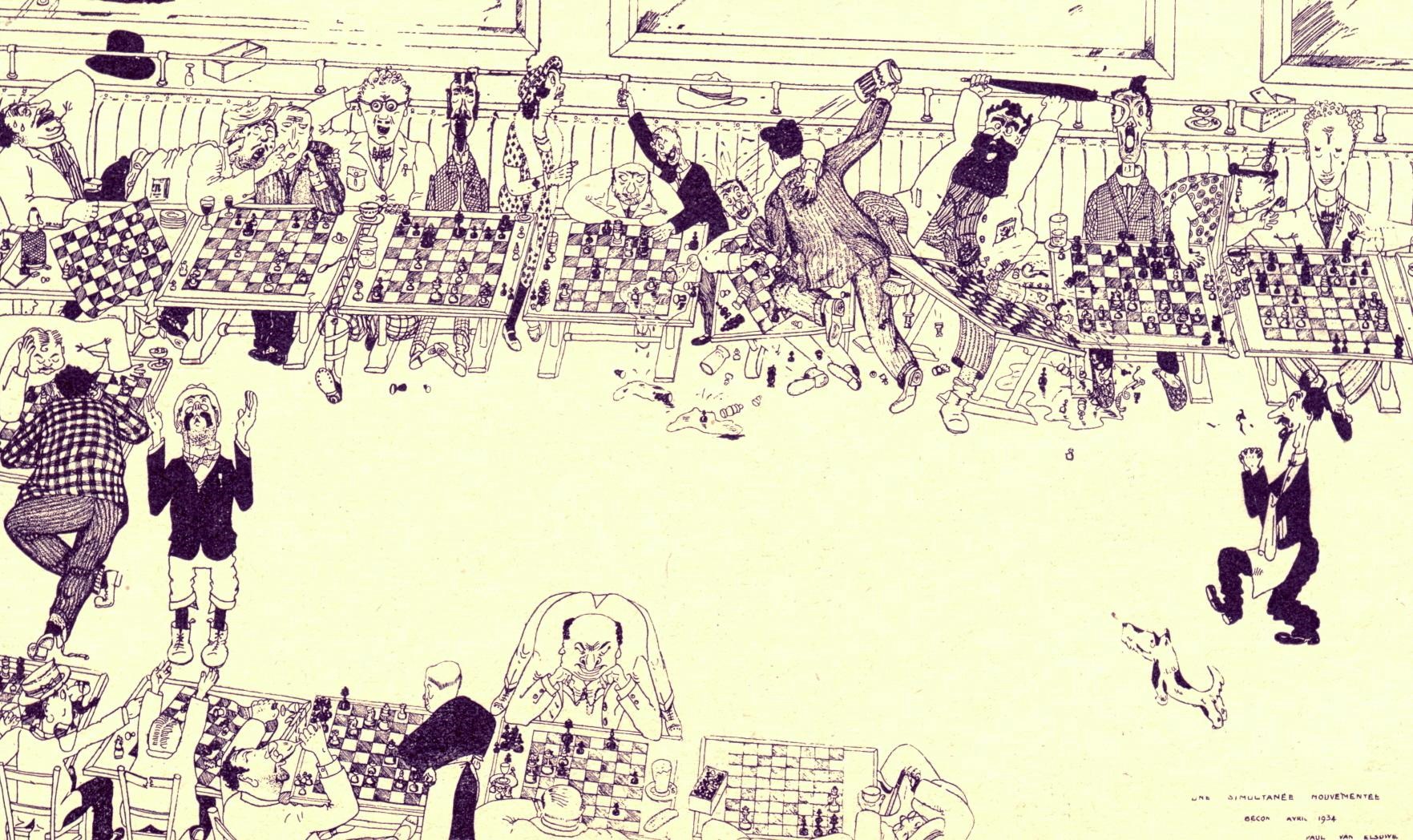
P. Van Elsuwe: ‘Une simultanée mouvementée’, from page 323 of Les Cahiers de l’Echiquier Français, July-August 1934.
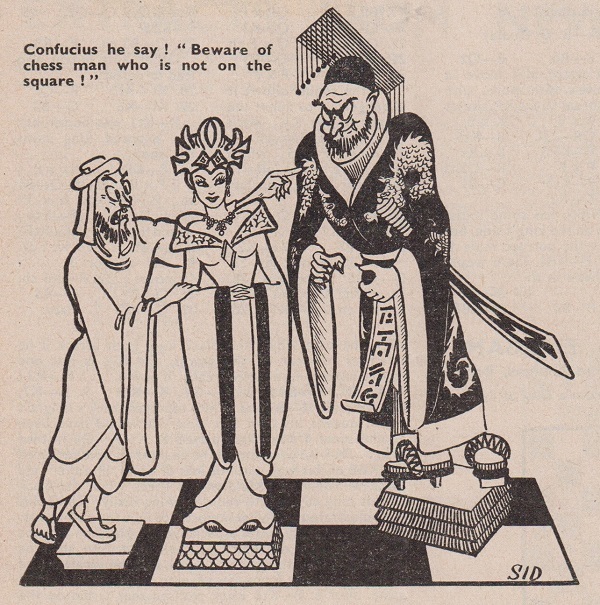
CHESS, December 1950, page 56
Four of the cartoons in the anonymous book ¿Juguemos al ajedrez? (Barcelona, 1947), whose front cover was shown in C.N. 6329:
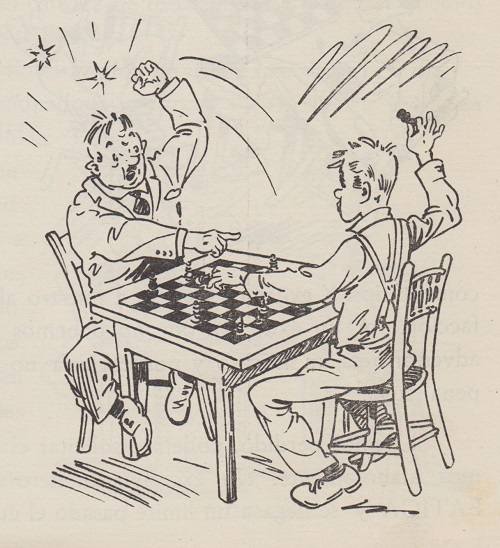
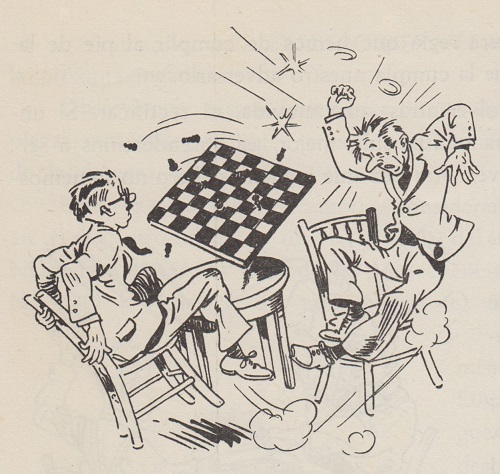
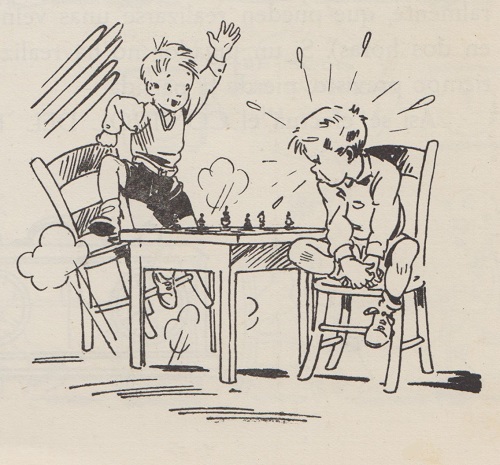
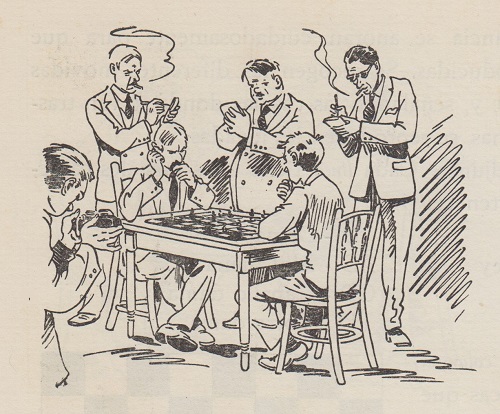
Towards the end of the book – the pages are unnumbered – the Immortal Game was shown. Anderssen’s nationality was given as English, and his opponent was misnamed (‘... entre los grandes maestros Anderssen (inglés) y Kiesevitzki (ruso)’). The same mistakes occur in connection with the musical composition La Inmortal by Ferrer Ferran.
(10067)
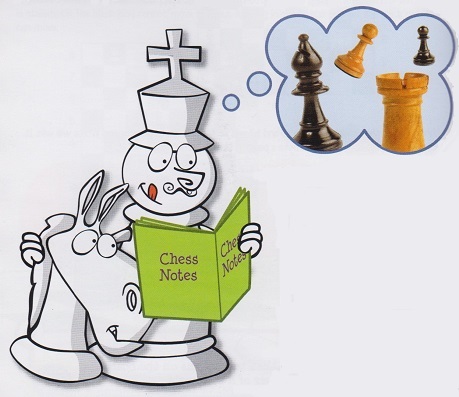
(10112)
The above image appeared on page 46 of a 2004 introduction to the game, Playing Chess Step-by-Step. For further information, see C.N. 10112.
Richard Forster (Zurich) notes portraits of chess figures in Henry Grob: der Zeichner und Maler by Henry Grob (Zurich, 1965), including the following cartoon:
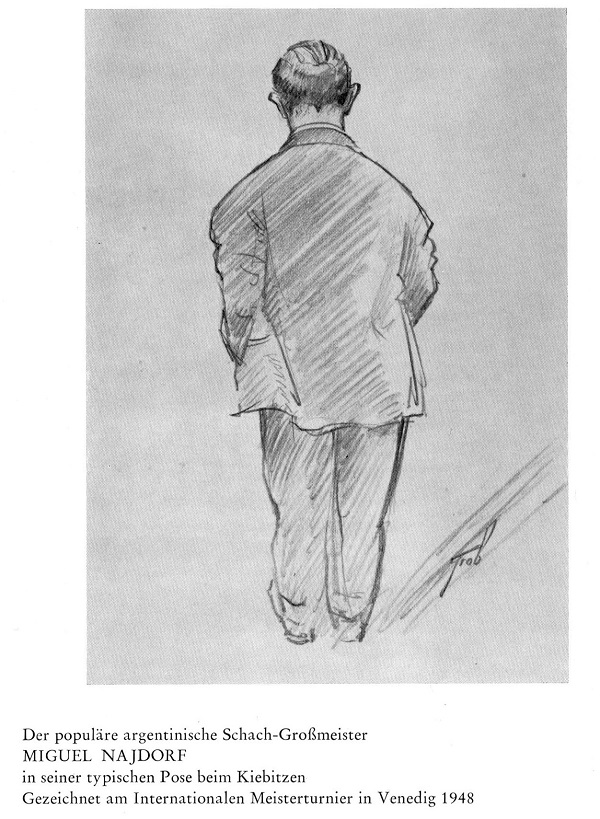
(10217)
A drawing of Reshevsky on page 52 of the June 1992 Chess Life:
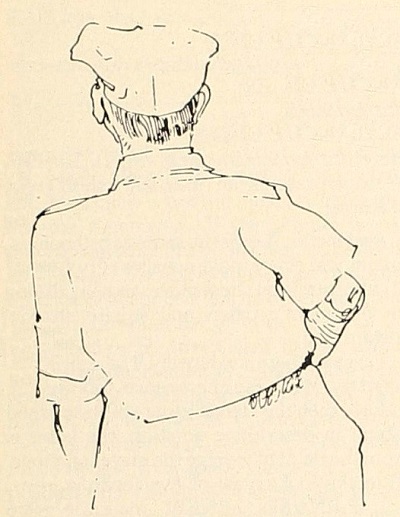
(12079)
Also from that C.N. item:
The French cartoonist [Jacques-Armand] Cardon can skilfully depict his subjects (often politicians) from behind. See, for instance, Vu de dos.
Olimpiu G. Urcan provides the following from the Illustrated Sporting and Dramatic News:
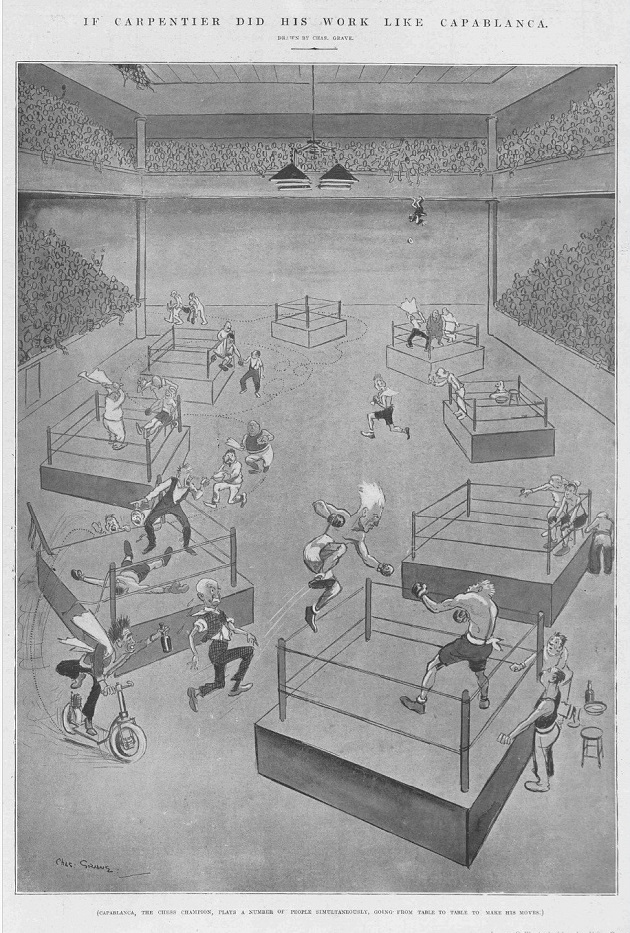
21 February 1920, page 871
(10307)
Juan Carlos Sanz Menéndez (Alcorcón, Spain) contributes material on pages 1982-1984 and 1993-1994 of Els Escacs a Catalunya, January-February 1936, including the following:
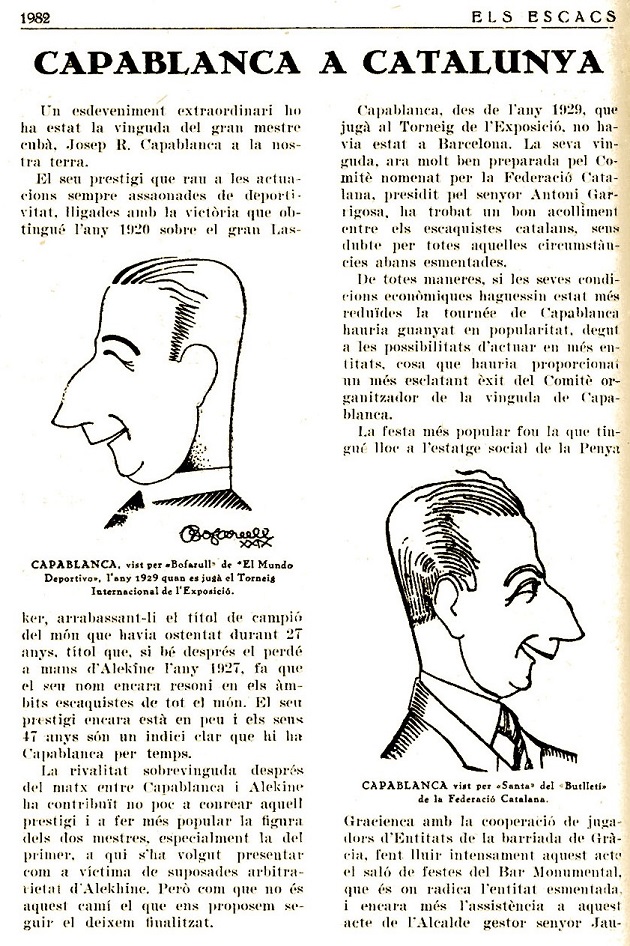
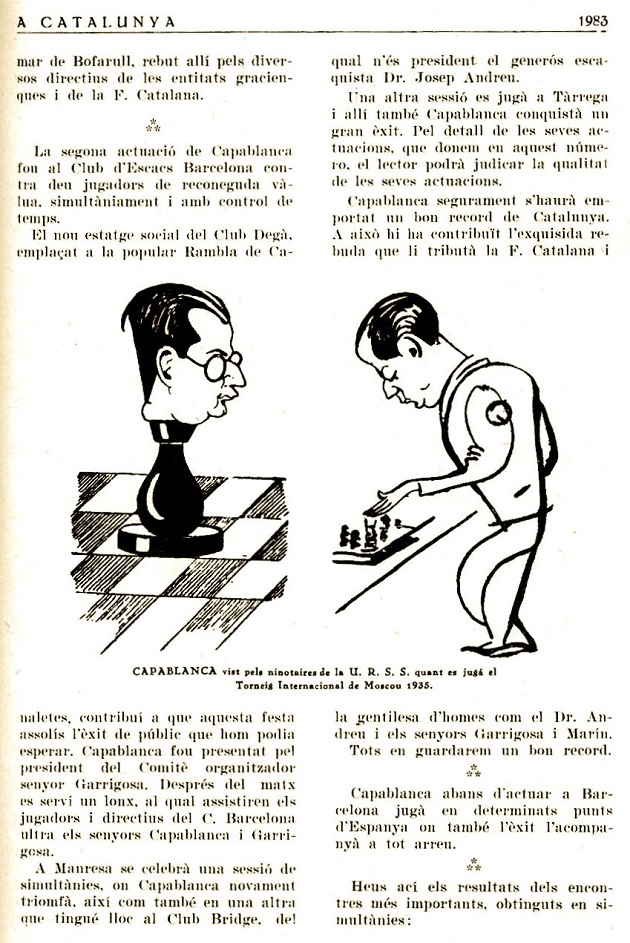
(10308)
The cartoon below is one of a series given in From Former Times (Chess), consisting of material that would hardly be regarded as printable today.
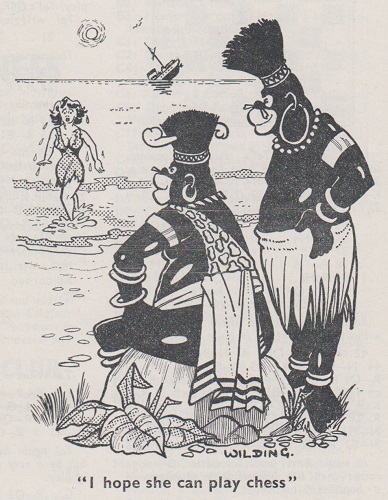
CHESS, End-December 1965, page 129
(10163)
A cartoon from CHESS (page 50 of the December 1939 issue):
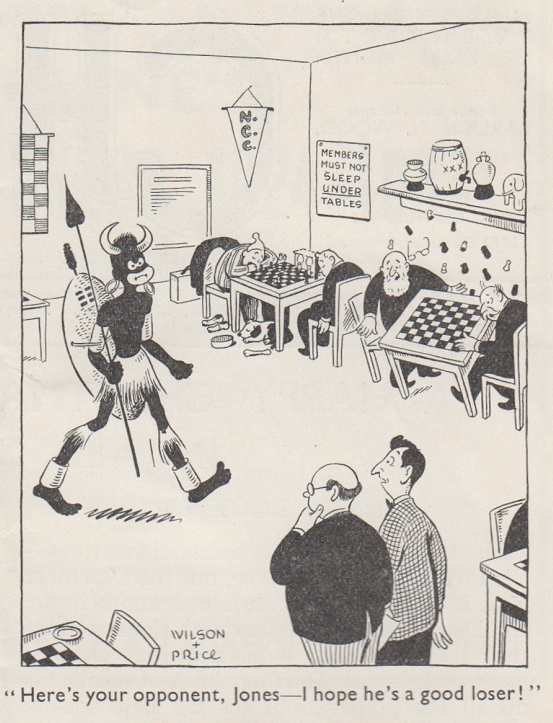
(10419)
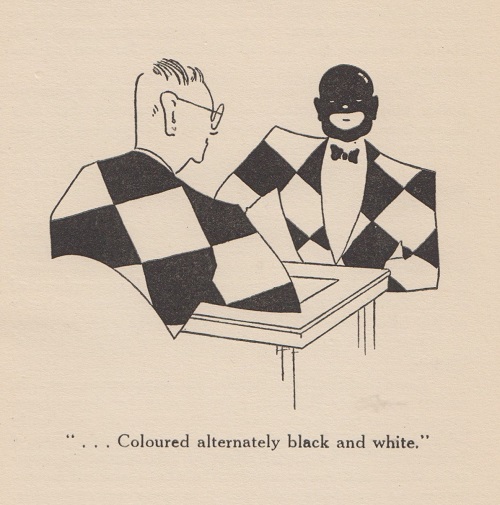
Source: page 13 of “Among These Mates” by Chielamangus (Sydney, 1939).
(10479)
From page 187 of the September 1939 Chess Review:
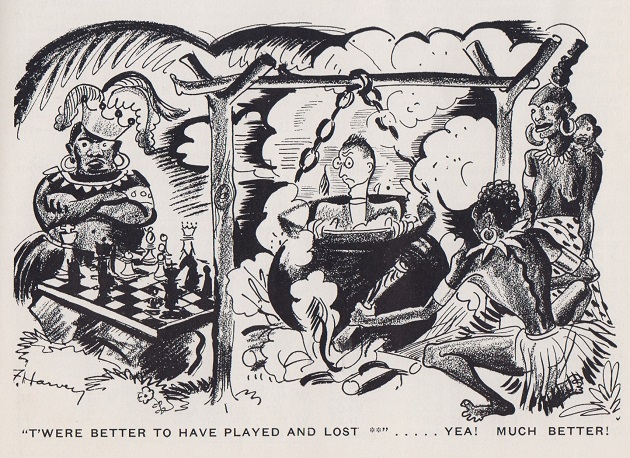
(10498)
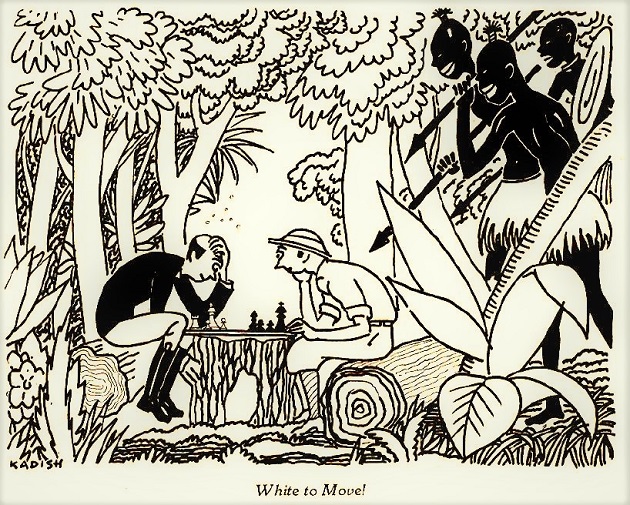
Source: Chess Review, August 1934, page 133.
(11028)
From Gerard Killoran comes this item on page 7 of the Leeds Mercury, 28 November 1928:
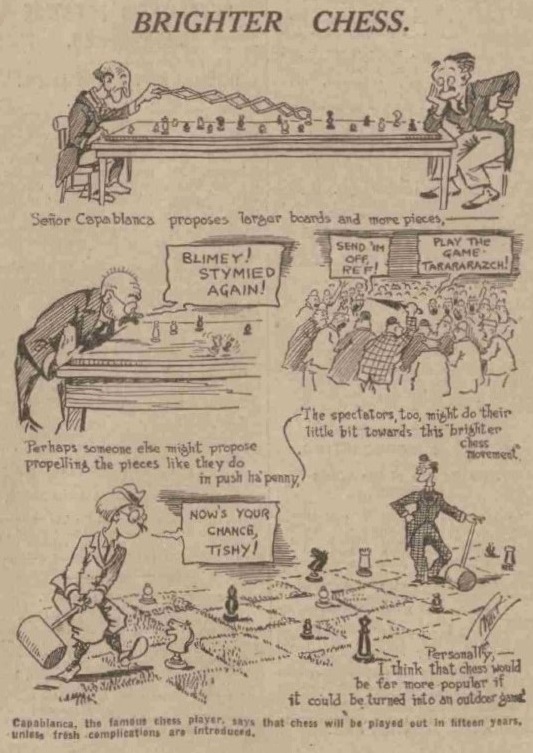
(10167)
From page 108 of Chess Review, April 1956:
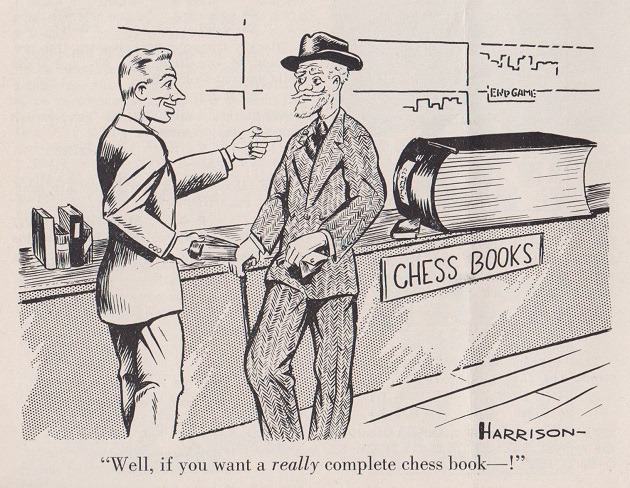
(10454)

This cartoon by Leslie Starke was the frontispiece of The Fireside Book of Chess by Irving Chernev and Fred Reinfeld (New York, 1949). The imprint page stated that it had appeared earlier the same year in the Saturday Evening Post.
(10611)
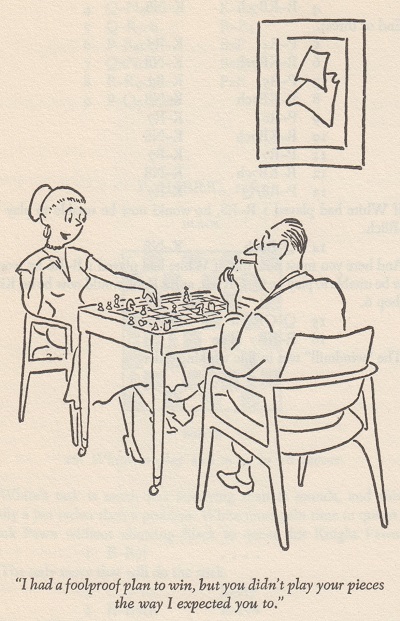
The Joys of Chess by Fred Reinfeld (New York, 1961), page 116
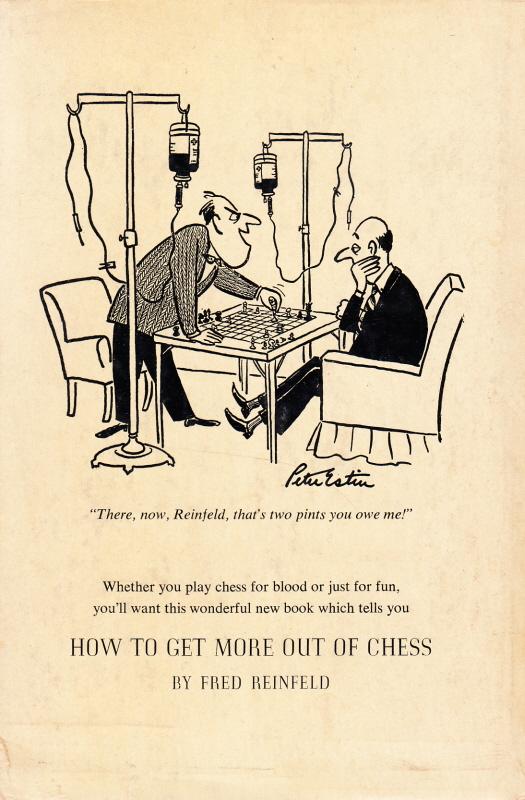
The back of the dust-jacket of How To Get More Out Of Chess by Fred Reinfeld (New York, 1957).
Gerard Killoran draws attention to the front page of Ally Sloper’s Half Holiday, 21 September 1895:
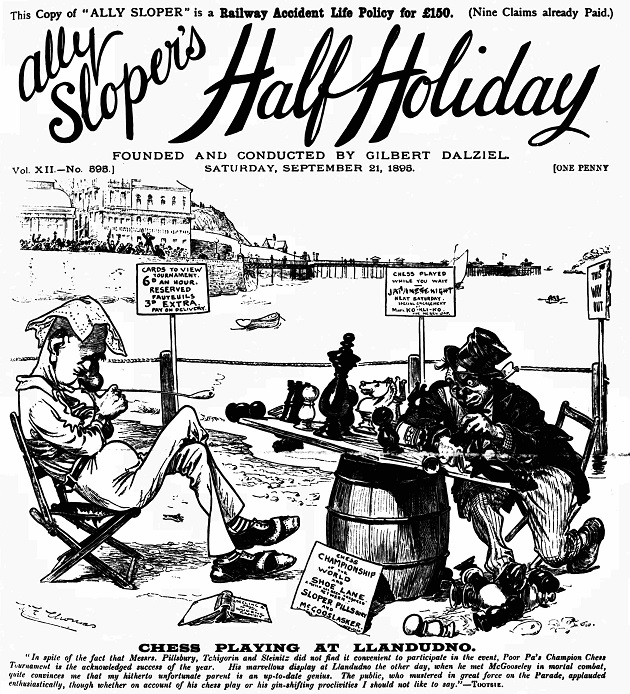
(10720)
From page 241 of CHESS, 25 May 1963:
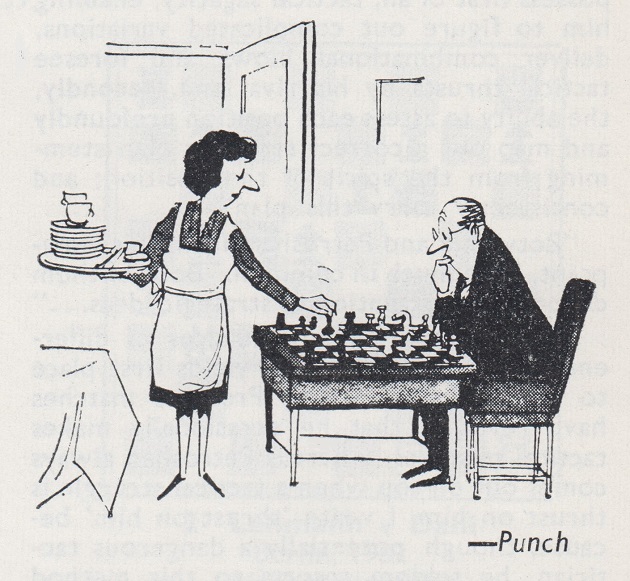
(10790)
From page 414 of Punch, 19 September 1962:
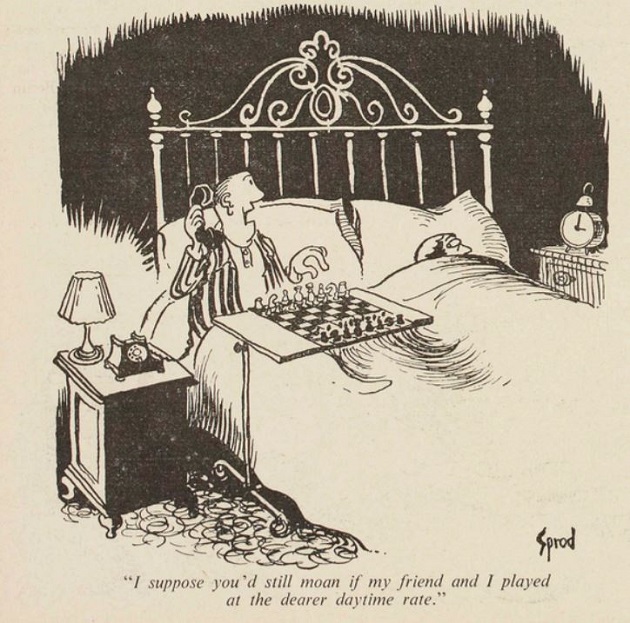
(10894)
L. Ross Jackson reports that he recently acquired this original pen-and-ink drawing:
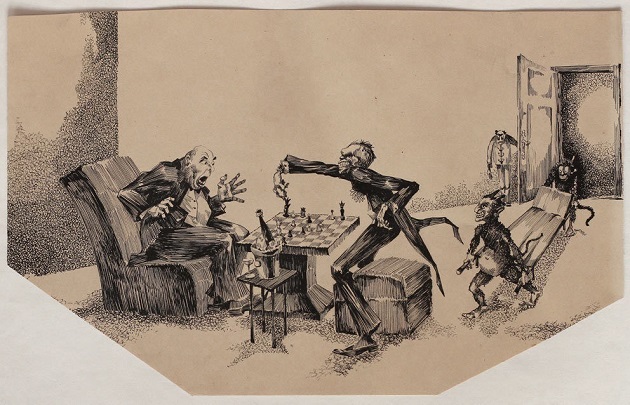
The dealer, in Vienna, had no information about the picture, which is unsigned.
(10974)
Olimpiu G. Urcan draws attention to a cartoon feature on pages 26-27 of the November-December 2018 Playboy: ‘American Chess Masters’ written by Brin-Jonathan Butler and illustrated by Nathan Gelgud.
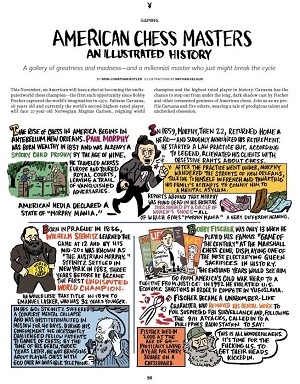
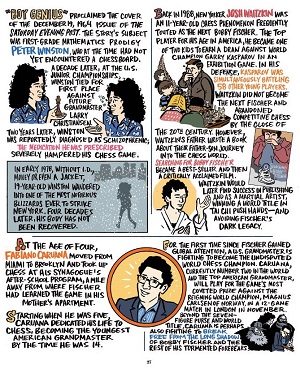
The left-hand section on Morphy refers to ‘a spooky child prodigy’ who later ‘traveled across Europe and toured royal courts ...’ Then comes this ‘Fun’:
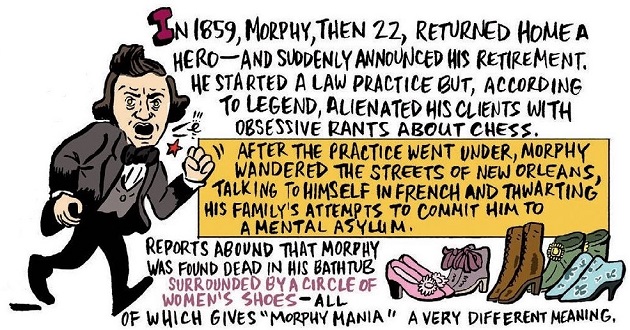
The treatment of Steinitz does not even attain the ‘according to legend’ and ‘reports abound that’ level:
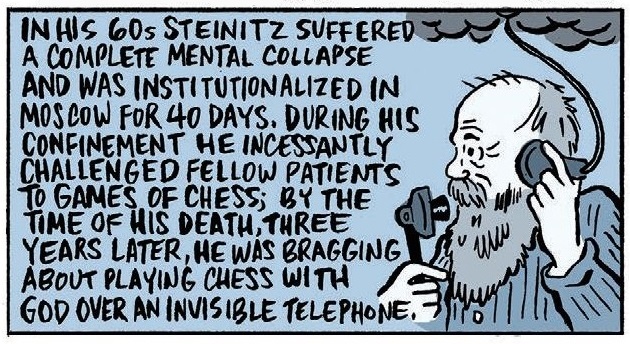
(11086)
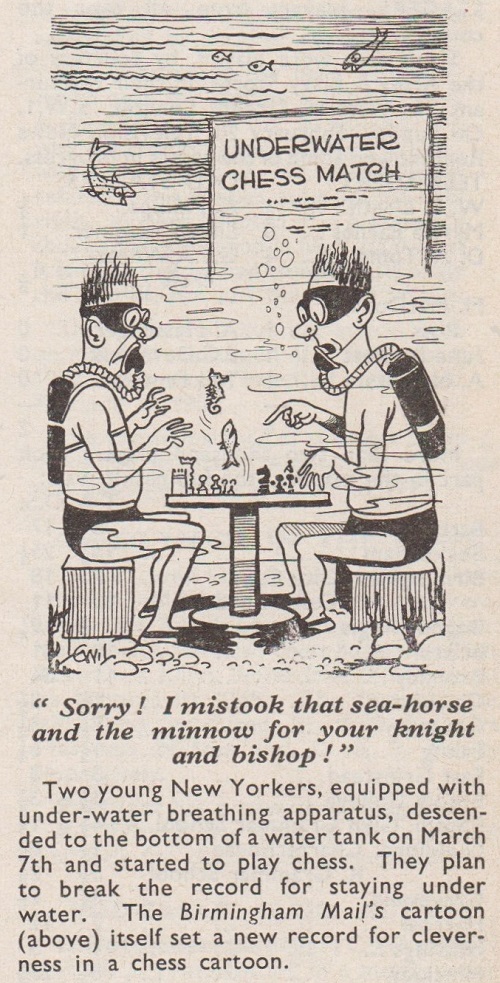
CHESS, 19 March 1955, page 255
Three years later the magazine briefly reported on an announcement by John E. Almond of San Francisco of the ‘very first world under-water chess championship’. See C.N. 3237 on page 125 of Chess Facts and Fables.
(11116)
Noting that the Argentinian weekly magazine Caras y Caretas is available via the digital collection of the Biblioteca Nacional de España, Olimpiu G. Urcan has forwarded a number of pages, including the following:
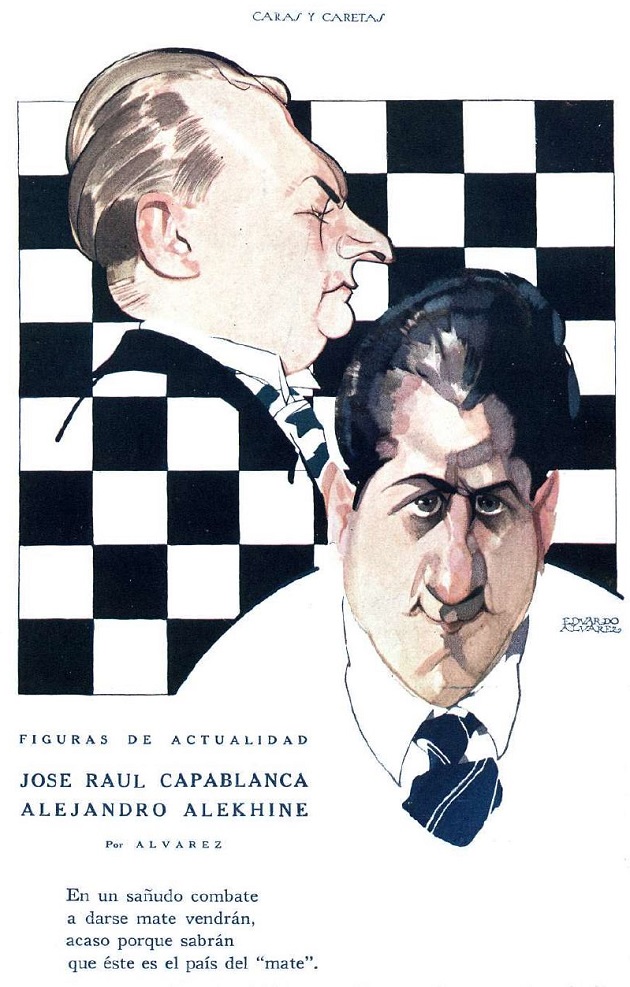
16 April 1927
(11318)
A set of caricatures from page 11 of Destino (Barcelona), 25 January 1964:
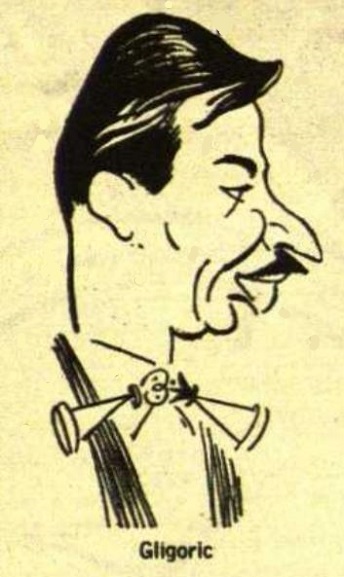
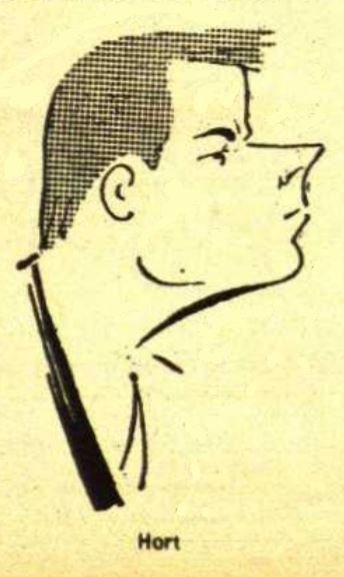
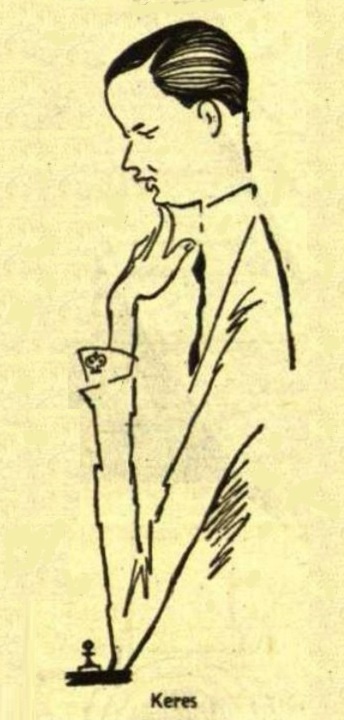
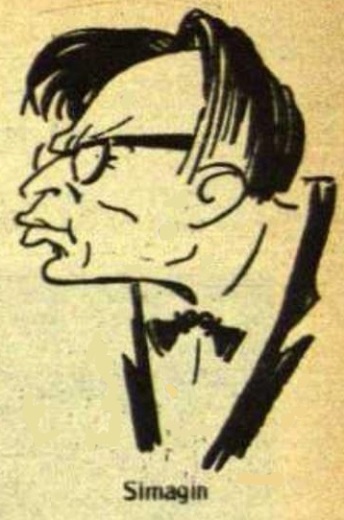
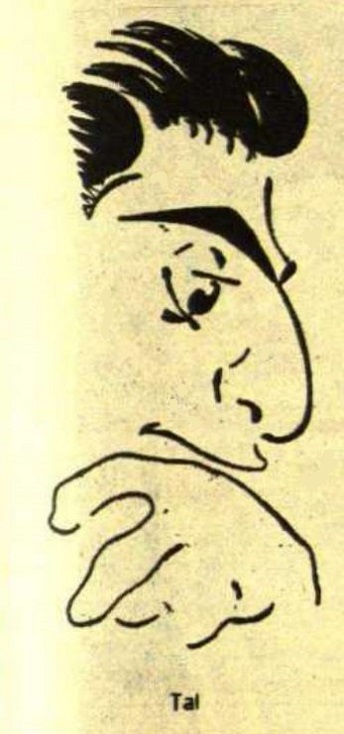
Gligorić, Hort, Keres, Simagin and Tal all participated in a tournament in Moscow in late 1963.
(11371)
From Yuri Kireev and Mikhail Sokolov (Moscow) comes this caricature of Capablanca in the Peterburgskaya Gazeta, 12 December 1913, page 4:
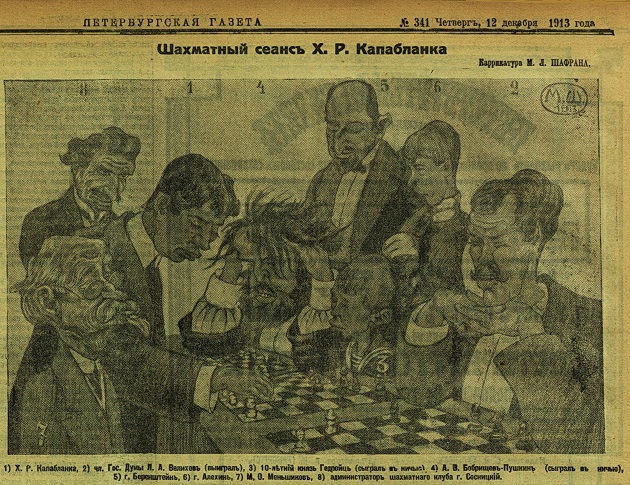
(11457)
Yuri Kireev and Mikhail Sokolov also send this cartoon from the Moscow tournament bulletin, 64, 29 May 1936, page 4:
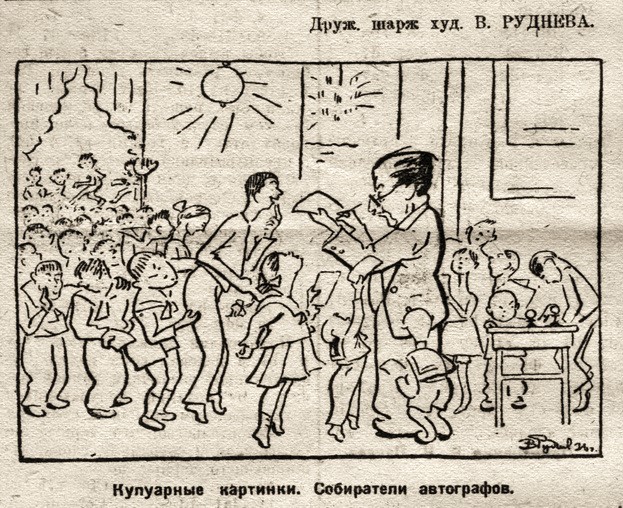
(11489)
This cartoon has been provided by David McAlister (Stirling, Scotland) from a Ripley’s syndicated column published on page 8 of the Evening Echo (Cork, Ireland), 28 May 1963:
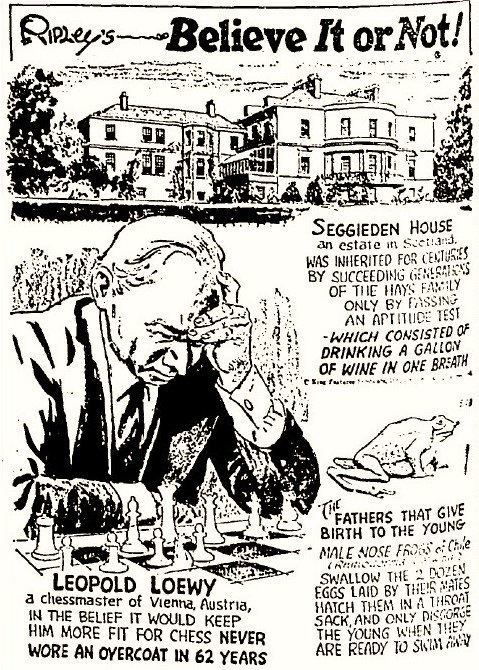
The coat matter was mentioned by Josef Krejcik on page 20 of his book Mein Abschied vom Schach (Berlin, 1955), as shown in C.N. 11012:

Michael Lorenz (Vienna) reports that a series of caricatures by Leopold Löwy was published in Die Bühne in 1925:
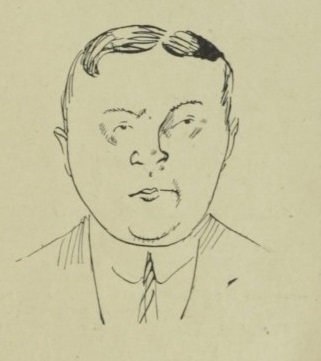
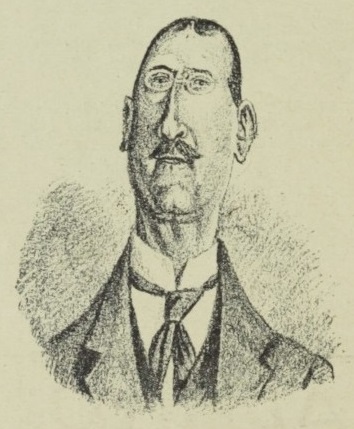
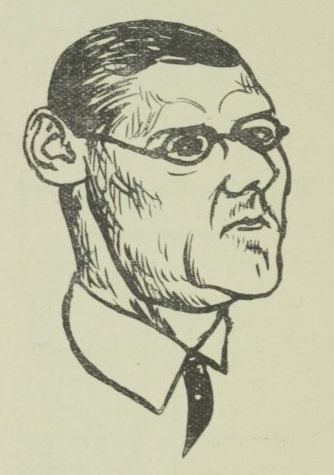
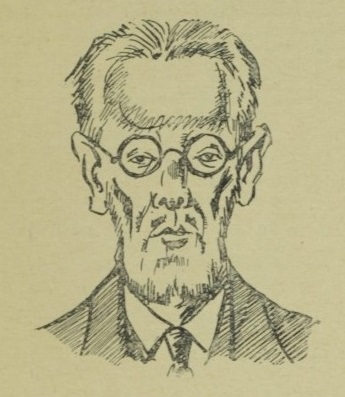
(11512)
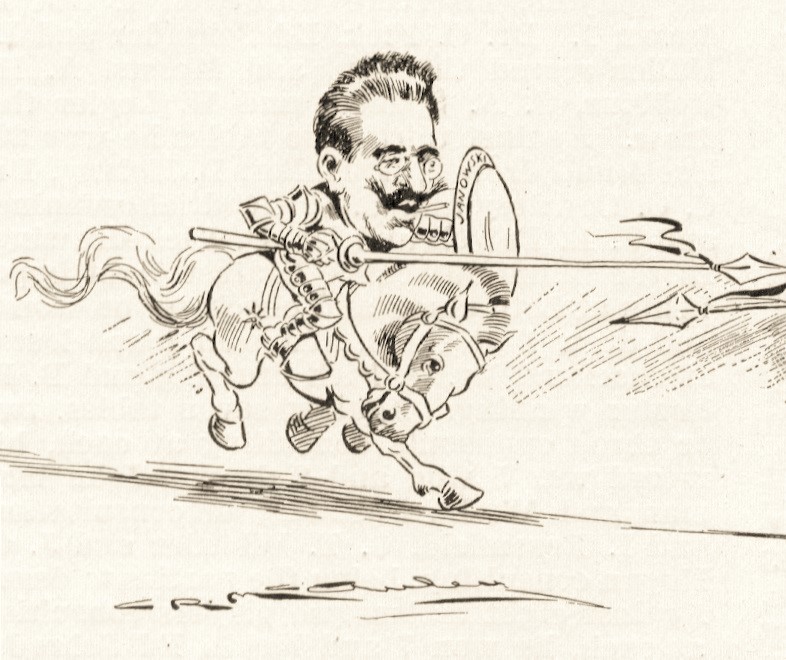
See Janowsky Jottings.
Michael Lorenz notes an illustration which accompanied a biographical note about Löwy on pages 12-13 of the January-February 1907 Wiener Schachzeitung:
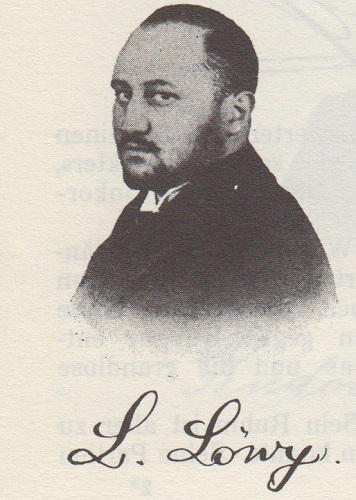
(11520)
A further contribution from Michael Lorenz is this caricature by Leopold Löwy of Georg Marco:
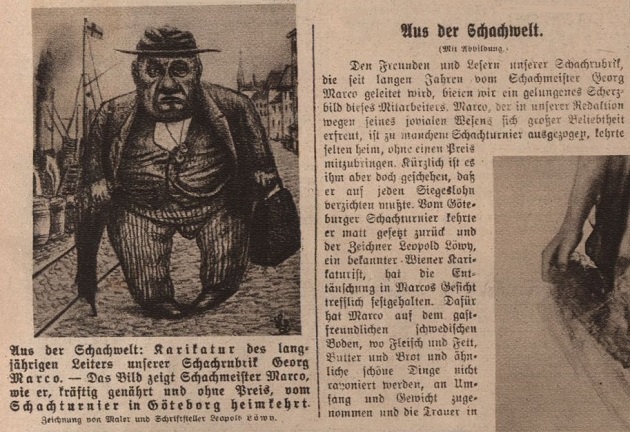
Das interessante Blatt, 18 November 1920, page 14
The caption describes Marco as returning from the Göteborg tournament ‘very well fed and without a prize’ (‘kräftig genährt und ohne Preis’).
(11521)
Zdeněk Závodný (Brno, Czech Republic) sends pages 17-18 of the 156/1925 edition of Die Bühne:
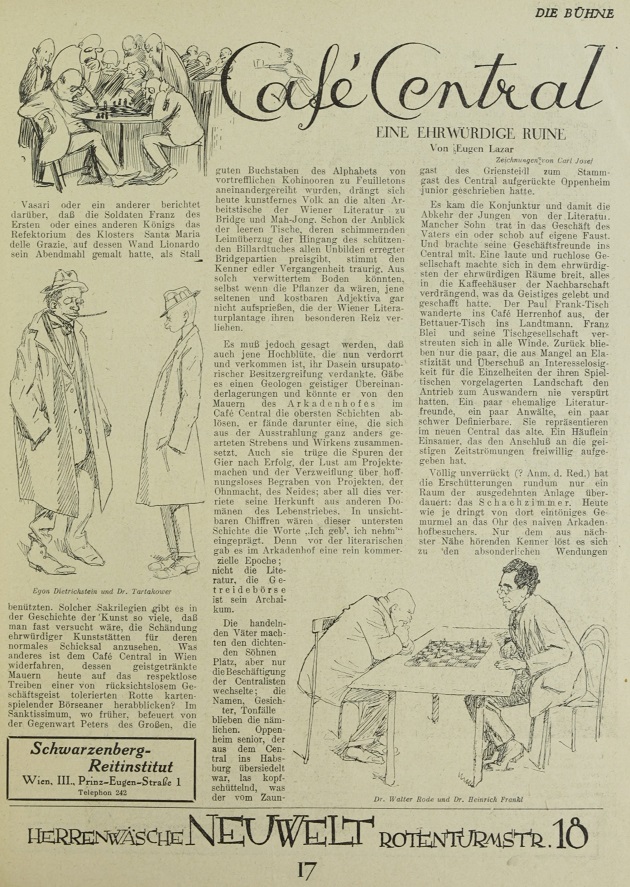
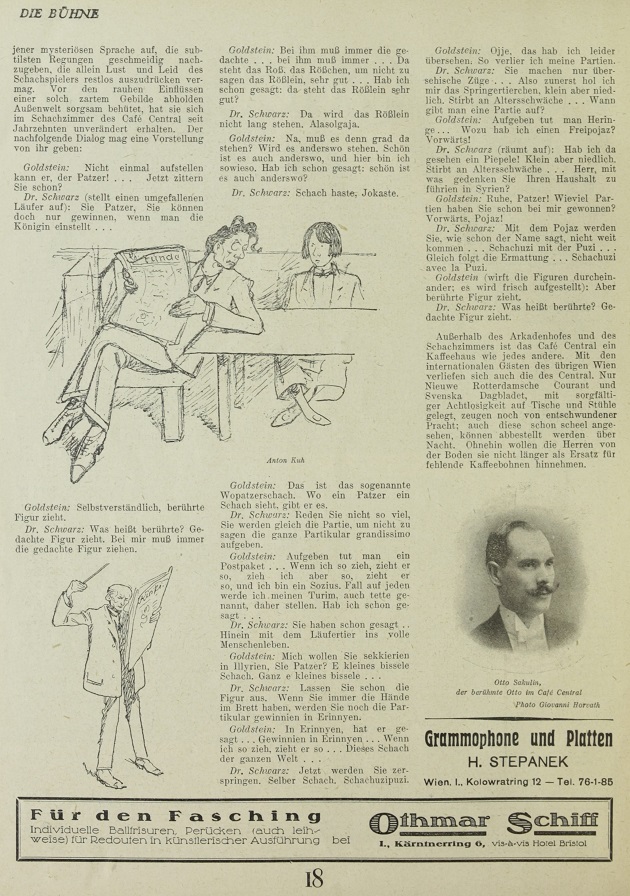
(11487)
Page 8 of the Pall Mall Gazette, 14 July 1899:

The article was featured on page 123 of the American Chess Magazine, September 1899. Regarding the sketches, see too C.N. 5729 and our feature article on London, 1899.
(11526)
This caricature is given at the start of Glorias del Tablero “Capablanca” by J.A. Gelabert (Havana, 1923) and at the end of the second edition (Havana, 1924):
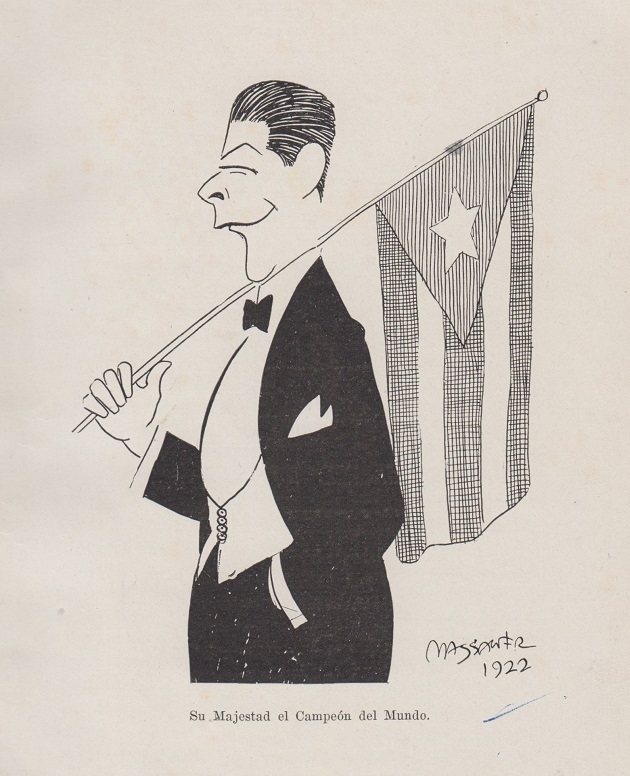
Yandy Rojas Barrios writes:
‘Concerning this widely-disseminated caricature by Conrado Massaguer, I can add that page 23 of the March 1923 edition of the magazine Social, which Massaguer edited, had another one of Capablanca:
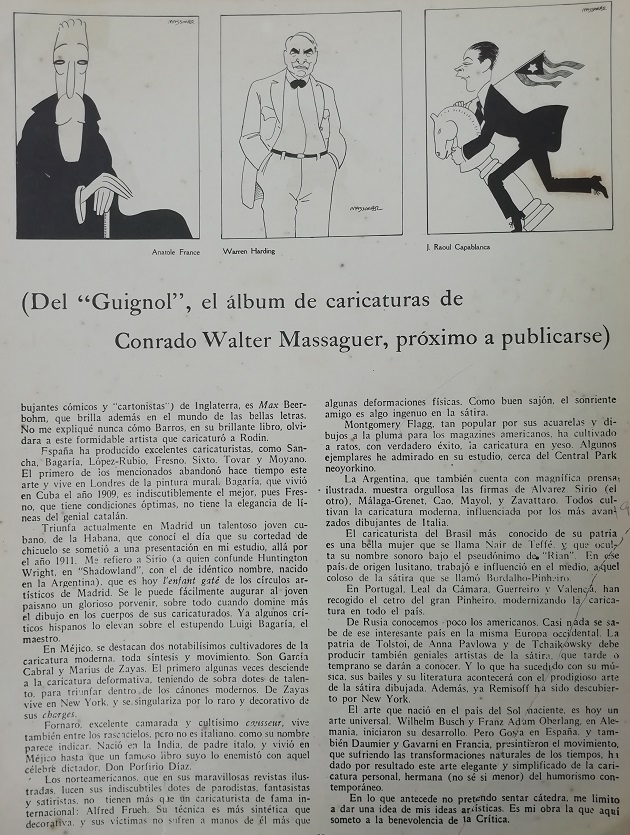
A colour version was on the back cover of the January 1924 issue:
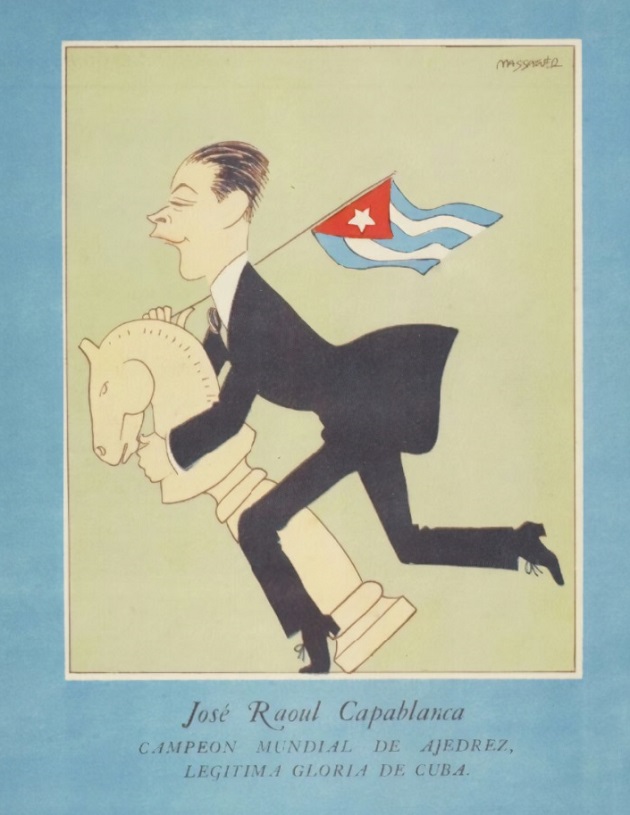
It is curious that the well-known 1922 caricature does not appear in any edition of Social that year.’
(11531)
A set of caricatures published on page 18 of Nieuwsblad van het Noorden, 1 November 1937, during the Euwe v Alekhine world championship match:
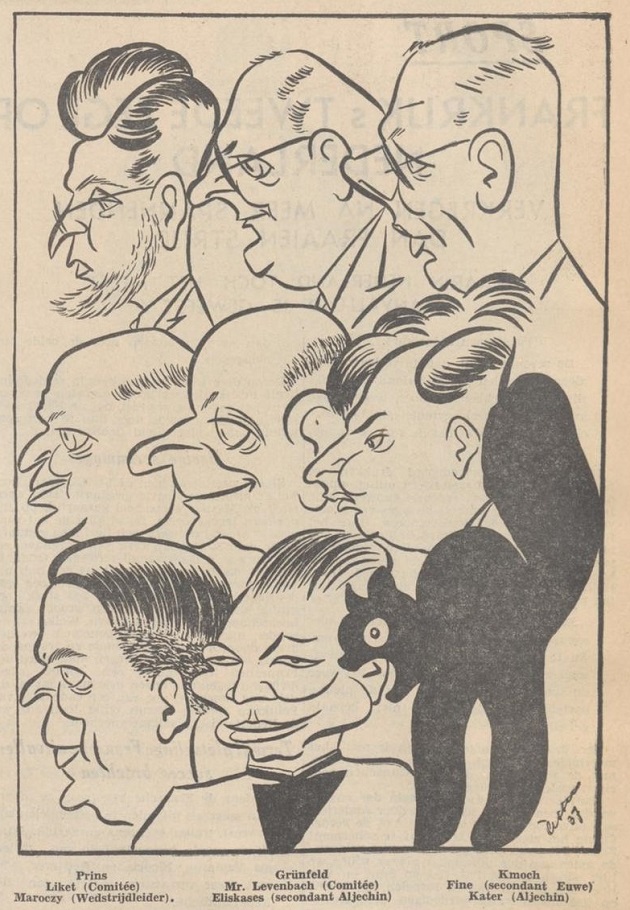
(11755)
A drawing of Roland Illa from an unnumbered page in the 22 November 1912 edition of Fray Mocho, a weekly publication in Argentina:
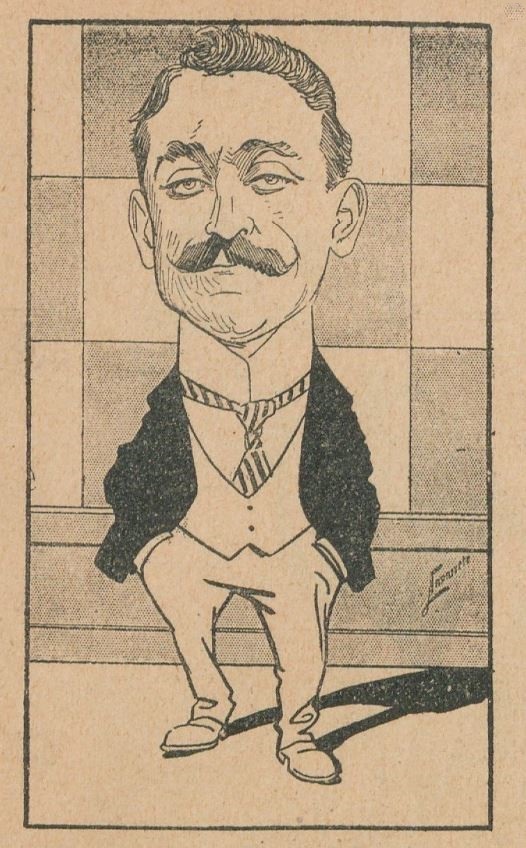
(11794)
Page 3 of Crítica, 17 September 1927:
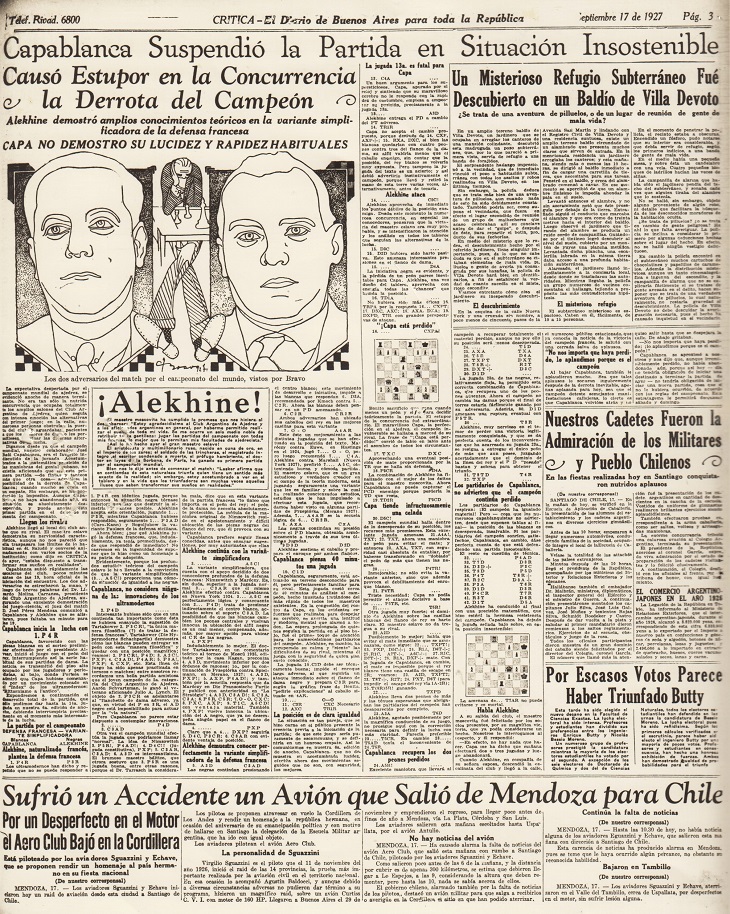
(11808)
The caricatures of Capablanca and Alekhine below also come from Crítica (11 October 1927, page 4 and 24 September 1927, page 7 respectively):
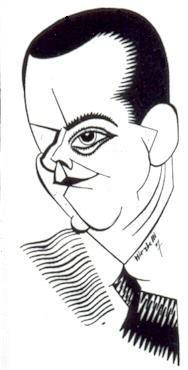
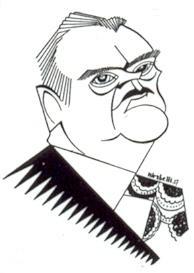
(4814)
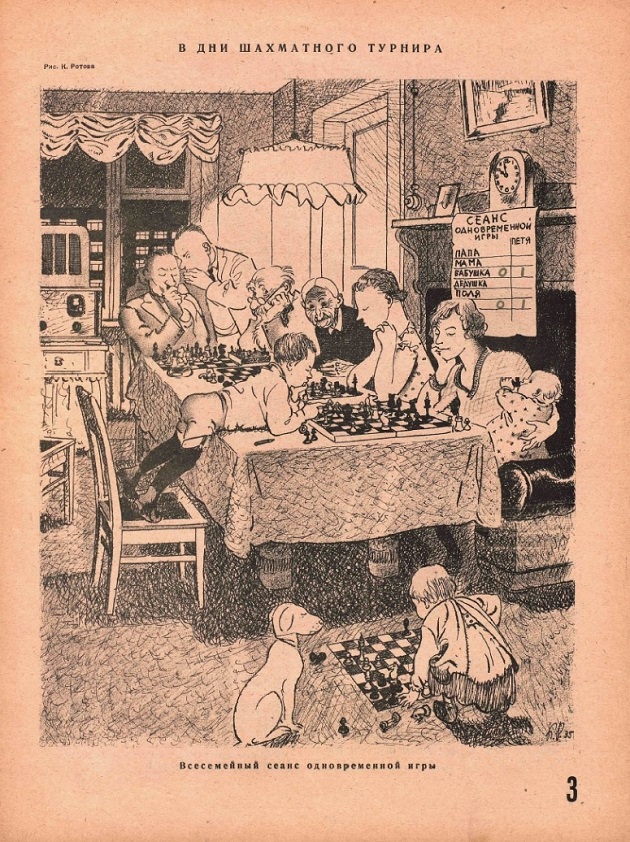
Source: the 4/1935 issue of the Soviet satirical magazine Крокодил.
(11922)
See too Chess Cartoons by Tom Webster.
Many cartoons regarding the 1972 Spassky v Fischer match are in our feature article on that contest.
To the Chess Notes main page.
To the Archives for other feature articles.
Copyright: Edward Winter. All rights reserved.